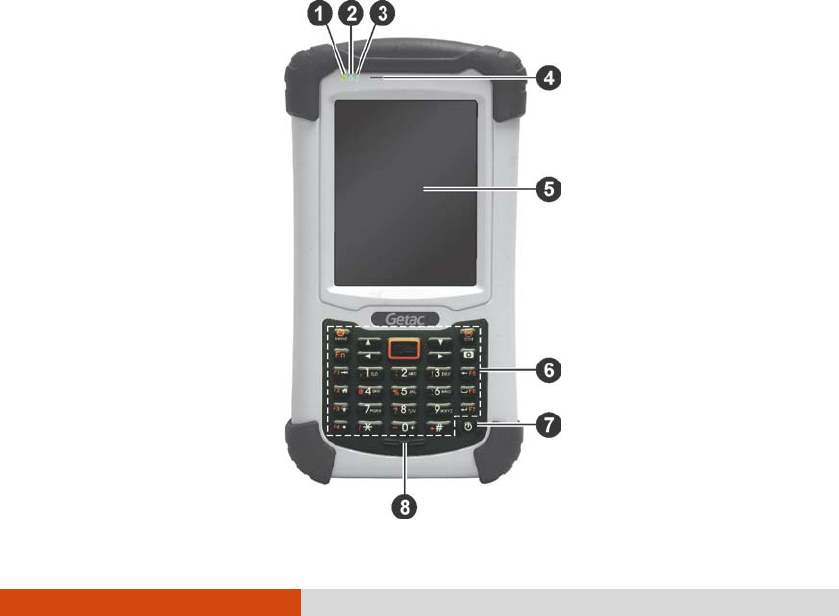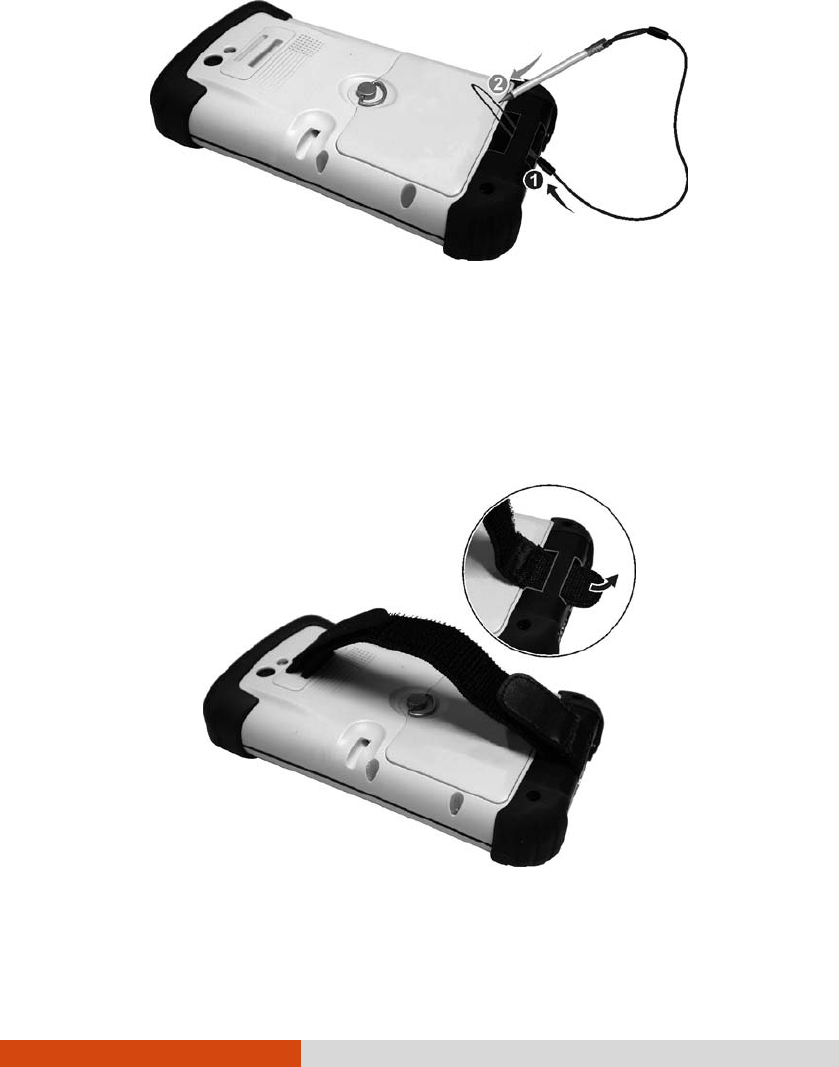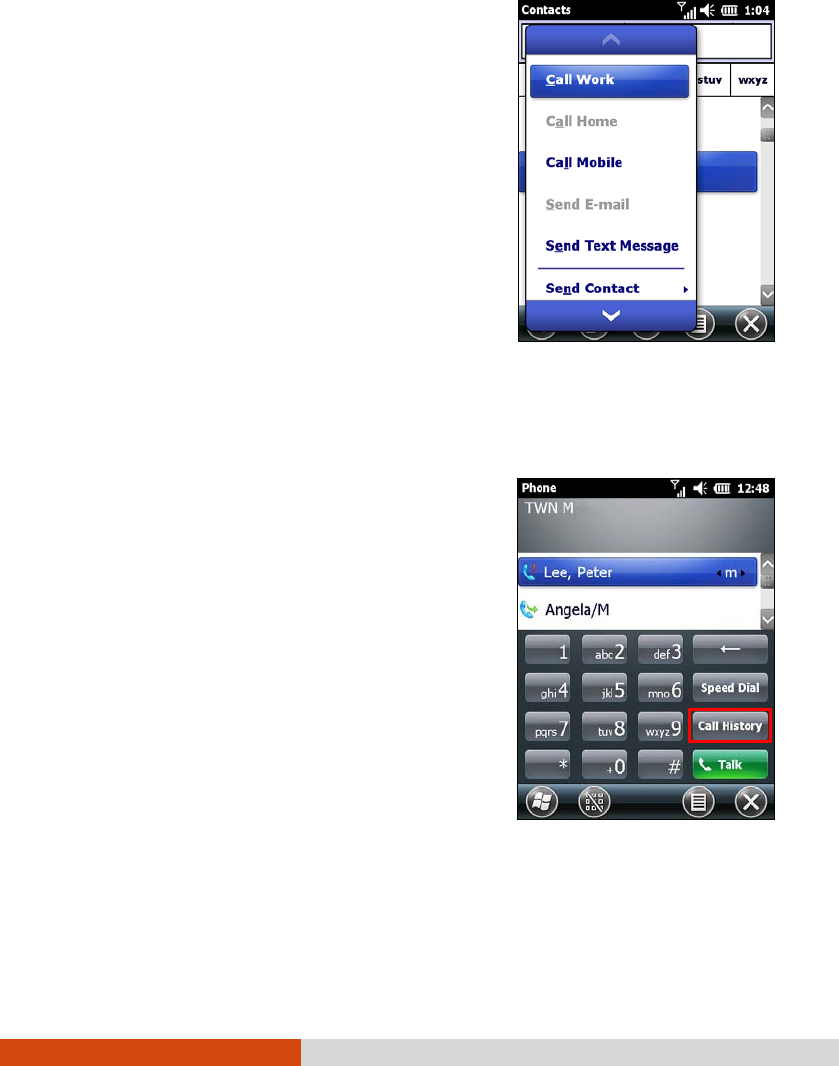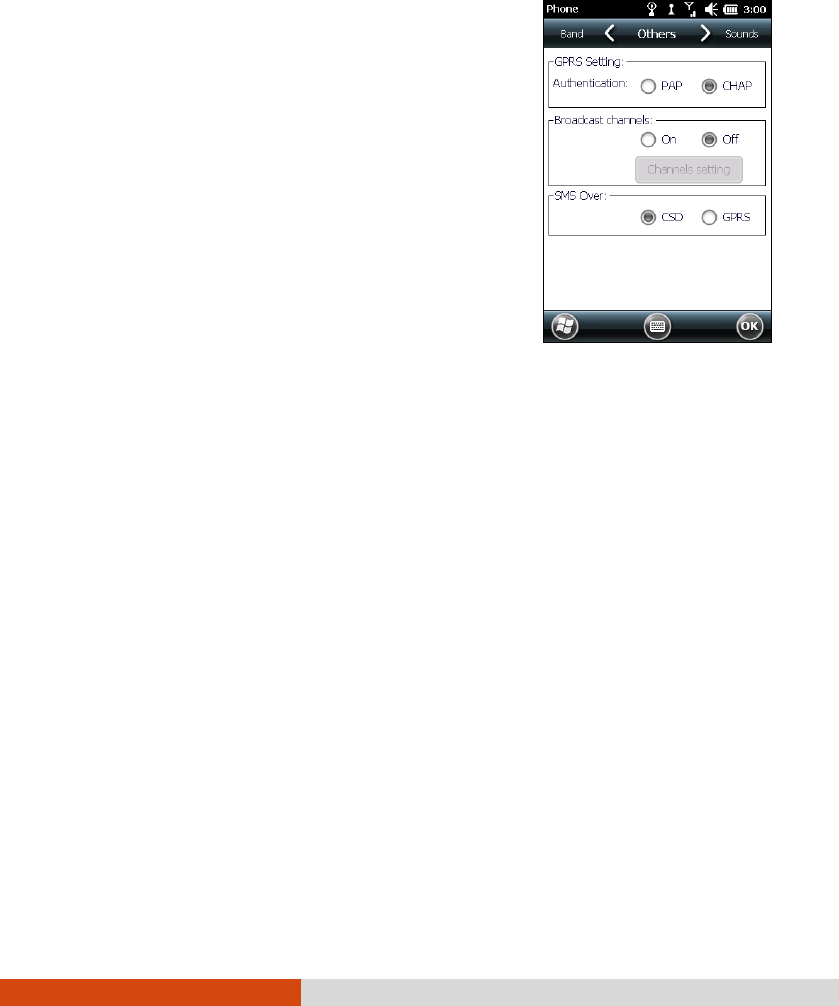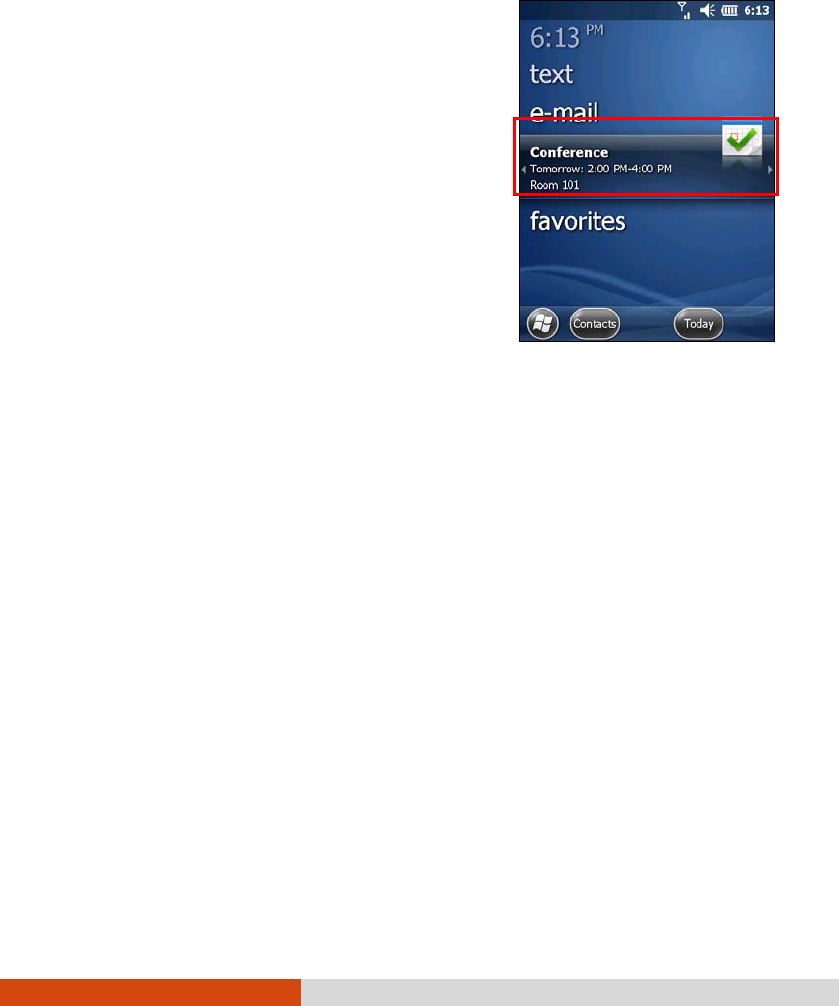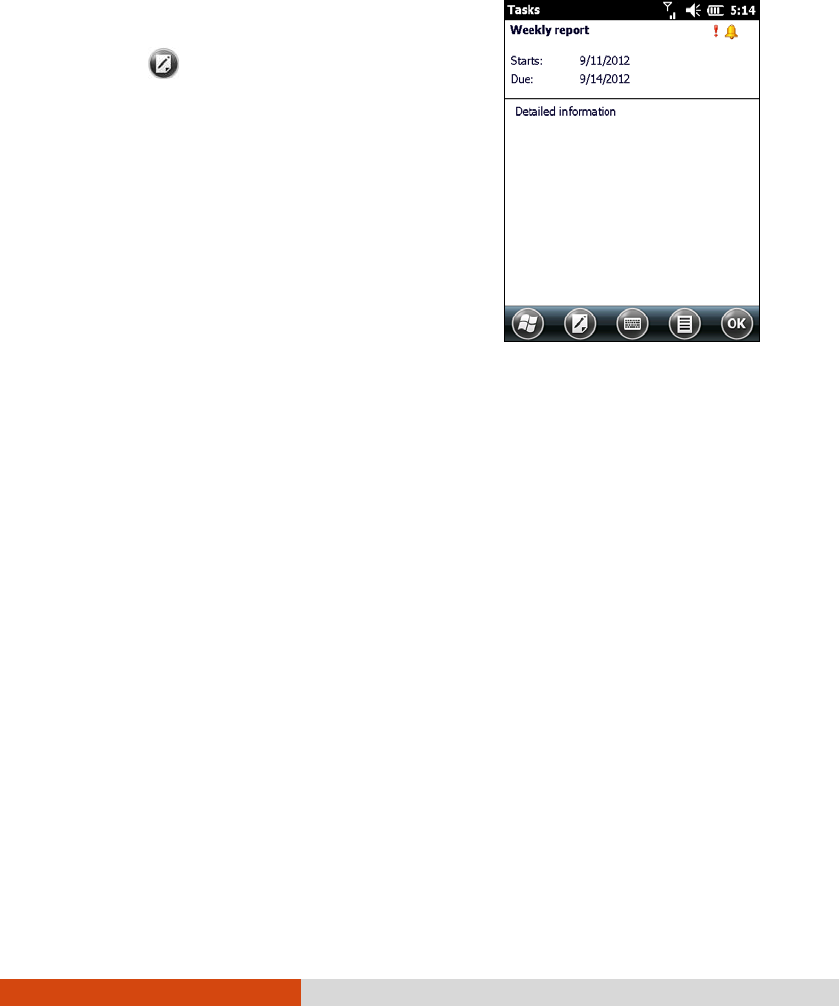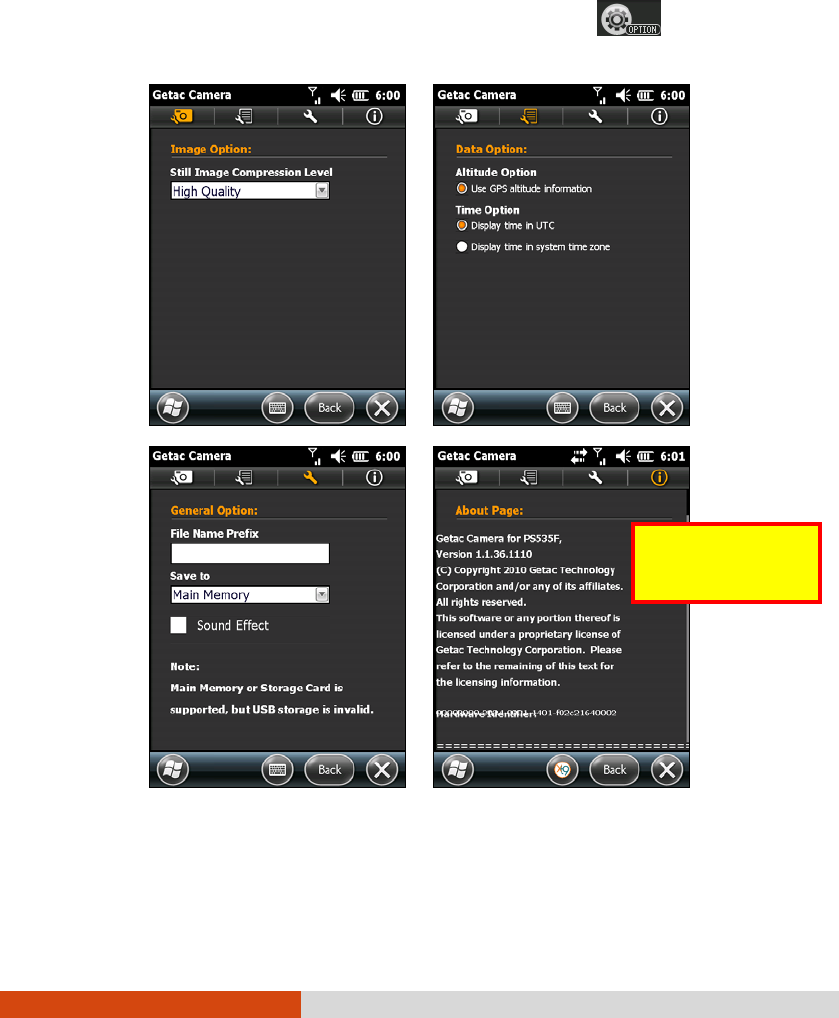Getac Technology PHS8-PP WWAN Module User Manual PS336
Getac Technology Corporation WWAN Module PS336
User Manual

Rugged Mobile Computing Solutions
PS336
USER MANUAL

Sep. 2012
Trademarks
Microsoft, Windows, the Windows logo, Windows Media, Outlook and
ActiveSync are registered trademarks or trademarks of Microsoft
Corporation in the United States and/or other countries. Microsoft products
are licensed to OEMs by Microsoft Licensing, Inc., a wholly owned subsidiary
of Microsoft Corporation.
The Bluetooth word mark and logos are owned by the Bluetooth SIG, Inc.
All other brand and product names are trademarks or registered trademarks
of their respective companies.
Disclaimer
Specifications and manuals are subject to change without notice. Getac
assumes no liability for damage incurred directly or indirectly from errors,
omissions, or discrepancies between the device and the manuals.
Notes
Depending upon the specific model purchased, the color and look of your
device and accessories may not exactly match the graphics shown in this
document.
The screenshots and other presentations shown in this document are for
reference only. They may differ from the actual screens and presentations
generated by the actual product.
For the latest version of the manual, please visit the Getac website at
www.getac.com.

i
Table of Contents
Chapter 1 Getting Started ............................................................. 1-1
Identifying Hardware Components ....................................... 1-1
Front Components .............................................................. 1-1
Back Components ............................................................... 1-6
Top Components ................................................................ 1-7
Bottom Components .......................................................... 1-8
Getting Your Device Ready for Use ....................................... 1-9
Installing the SIM Card and Battery .................................. 1-9
Connecting to AC Power and Charging the Battery ...... 1-11
Performing the Initial Startup ......................................... 1-12
Quick Help ......................................................................... 1-13
Synchronizing with Your Computer .................................... 1-13
Installing ActiveSync or WMDC ....................................... 1-13
Using Options ........................................................................ 1-15
Using the Tether ............................................................... 1-15
Using the Hand Strap ....................................................... 1-16
Using an MicroSD ............................................................. 1-17
Chapter 2 Basic Skills ..................................................................... 2-1
Power Saving and Turning Off .............................................. 2-1
Backlight Off ....................................................................... 2-1
Entering the Suspend Mode .............................................. 2-1
Turning Off ......................................................................... 2-2
Navigating on the Screen ....................................................... 2-2
Using the Touchscreen ....................................................... 2-2

ii
Using the Keypad ............................................................... 2-3
Home Screen ........................................................................... 2-3
Navigation Bar and Toolbar ................................................... 2-4
Running Programs .................................................................. 2-5
Shortcut Menus ....................................................................... 2-5
Notifications ............................................................................ 2-6
Entering Information .............................................................. 2-6
Entering Text Using the Input Panel ................................. 2-6
Writing or Drawing on the Screen .................................... 2-9
Recording a Message ........................................................ 2-13
Securing Your Device ............................................................ 2-14
Locking the Screen ........................................................... 2-14
Locking Your SIM Card ..................................................... 2-15
Chapter 3 Using the Phone (Select Models Only) ........................ 3-1
About Your Phone .................................................................. 3-1
Switching On or Off the Phone ......................................... 3-2
Starting the Phone Program .............................................. 3-3
Phone Status Icons .............................................................. 3-3
Making a Call .......................................................................... 3-4
Dialing a Call ....................................................................... 3-4
Making a Call from the Onscreen List ............................... 3-5
Making a Call from Contacts ............................................. 3-5
Making a Call from the Call History List ........................... 3-6
Making a Call from Speed Dial .......................................... 3-7
Quickly Making a Call to the Last Missed Call .................. 3-8
Responding to a Call ............................................................... 3-8
Answering a Call ................................................................. 3-8
Rejecting a Call ................................................................... 3-8
Ending a Call ....................................................................... 3-8
Operations during a Call ........................................................ 3-9
Adjusting the Phone Volume ............................................. 3-9
Using the Mute Function ................................................... 3-9
Using the Speakerphone .................................................... 3-9

iii
Managing More Than One Call ....................................... 3-10
Taking a Note during a Call ............................................. 3-11
Using Call History .................................................................. 3-12
Viewing Call History ......................................................... 3-12
Adding an Entry to Contacts Using Call History ............. 3-13
Using Speed Dial ................................................................... 3-13
Creating a Speed Dial Entry ............................................. 3-13
Editing or Deleting a Speed Dial Entry ........................... 3-14
Additional Phone Operations .............................................. 3-15
Using Text Messages ......................................................... 3-15
Setting up an Internet Connection ................................. 3-15
Checking Your Voice Mail ................................................ 3-15
Making an Emergency Call .............................................. 3-15
Dialing an International Call ............................................ 3-16
Customizing Your Phone ...................................................... 3-17
Changing Sounds Settings ............................................... 3-17
Changing Security Settings .............................................. 3-18
Changing Services Settings .............................................. 3-18
Changing Network Settings ............................................. 3-19
Changing Band Settings ................................................... 3-19
Changing Others Settings ................................................ 3-20
Chapter 4 Managing Your Device ................................................. 4-1
Managing Power ..................................................................... 4-1
Low Battery Signals and Actions ....................................... 4-1
Power-Saving Tips ............................................................... 4-2
Customizing Your Device ....................................................... 4-3
Working with Programs and Folders ..................................... 4-7
Adding and Removing Programs ...................................... 4-7
Searching and Organizing Information ............................ 4-7
Chapter 5 Microsoft Pocket Outlook ............................................. 5-1
Calendar: Scheduling Appointments and Meetings ............. 5-1
Creating an Appointment .................................................. 5-2
Viewing Appointments ...................................................... 5-3

iv
Contacts: Tracking Friends and Colleagues ........................... 5-4
Creating a Contact .............................................................. 5-4
Assigning a Ringtone and Picture ..................................... 5-5
Using the Contacts Summary Screen ................................. 5-5
Tasks: Keeping a To Do List .................................................... 5-6
Creating a Task ................................................................... 5-6
Using the Tasks Summary Screen ...................................... 5-7
Notes: Capturing Thoughts and Ideas ................................... 5-8
Creating a Note .................................................................. 5-8
E-mail and Text Messaging: Sending and Receiving
Messages .................................................................................. 5-9
About Accounts .................................................................. 5-9
Reading and Sending E-mails .......................................... 5-10
Reading and Sending Text Messages (Select Models Only)
........................................................................................... 5-12
Chapter 6 More Programs .............................................................. 6-1
ActiveSync ................................................................................ 6-1
Synchronizing Data ............................................................ 6-2
Synchronizing Directly with Exchange Server .................. 6-2
Office Mobile 2010 ................................................................. 6-4
Creating a Document/Workbook/Note ............................. 6-4
Opening an Office Mobile File .......................................... 6-4
Internet Explorer ..................................................................... 6-5
Windows Media ...................................................................... 6-6
Pictures & Videos ..................................................................... 6-7
Viewing Pictures and Videos .............................................. 6-7
Camera ..................................................................................... 6-8
Taking Pictures .................................................................... 6-8
Recording Video Clips ...................................................... 6-10
Camera Controls and Options.......................................... 6-12
Getac Camera ........................................................................ 6-13
Overview ........................................................................... 6-13
Taking Pictures .................................................................. 6-15
Camera Mode Settings ..................................................... 6-15

v
Viewing Pictures ............................................................... 6-17
Managing Images ............................................................. 6-21
Internet Sharing (Select Models Only) ................................ 6-25
E-Compass .............................................................................. 6-26
Reading and Calibrating the Compass ............................ 6-26
Compass Settings .............................................................. 6-27
TacLink ................................................................................... 6-28
Running TacLink ............................................................... 6-28
NMEA Log ......................................................................... 6-29
SBAS Settings .................................................................... 6-29
RFID Demo ............................................................................. 6-30
Reading Tags ..................................................................... 6-30
Writing Data to 15693 Tags ............................................. 6-31
Writing Data to Mifare Tags ............................................ 6-31
Chapter 7 Getting Connected ........................................................ 7-1
Types of Connections .............................................................. 7-1
Using Cellular Connection (Select Models Only) .................. 7-2
Setting up a Cellular (GPRS) Connection .......................... 7-2
Setting up a Dial-up Connection ....................................... 7-3
Using Wireless Network ......................................................... 7-4
Switching On or Off the Wi-Fi Radio ................................ 7-4
Connecting to a Wireless Network .................................... 7-5
Using the Bluetooth Function ................................................ 7-6
Switching On or Off the Bluetooth Radio ........................ 7-6
Sending Files via the Bluetooth Function ......................... 7-7
Creating a Bluetooth Partnership ..................................... 7-8
Chapter 8 Troubleshooting and Maintenance ............................. 8-1
Resetting Your Device ............................................................ 8-1
Restoring Factory Default State ............................................. 8-1
Troubleshooting ...................................................................... 8-3
Caring for Your Device ........................................................... 8-4

vi
Chapter 9 Regulatory Information ................................................ 9-1
Regulations Statements .......................................................... 9-1
European Notice ................................................................. 9-1
FCC Regulations .................................................................. 9-2
Safety Precautions ................................................................... 9-3
About Charging .................................................................. 9-3
About the Charger ............................................................. 9-3
About the Battery ............................................................... 9-4
About Radio Frequency Exposure ..................................... 9-4
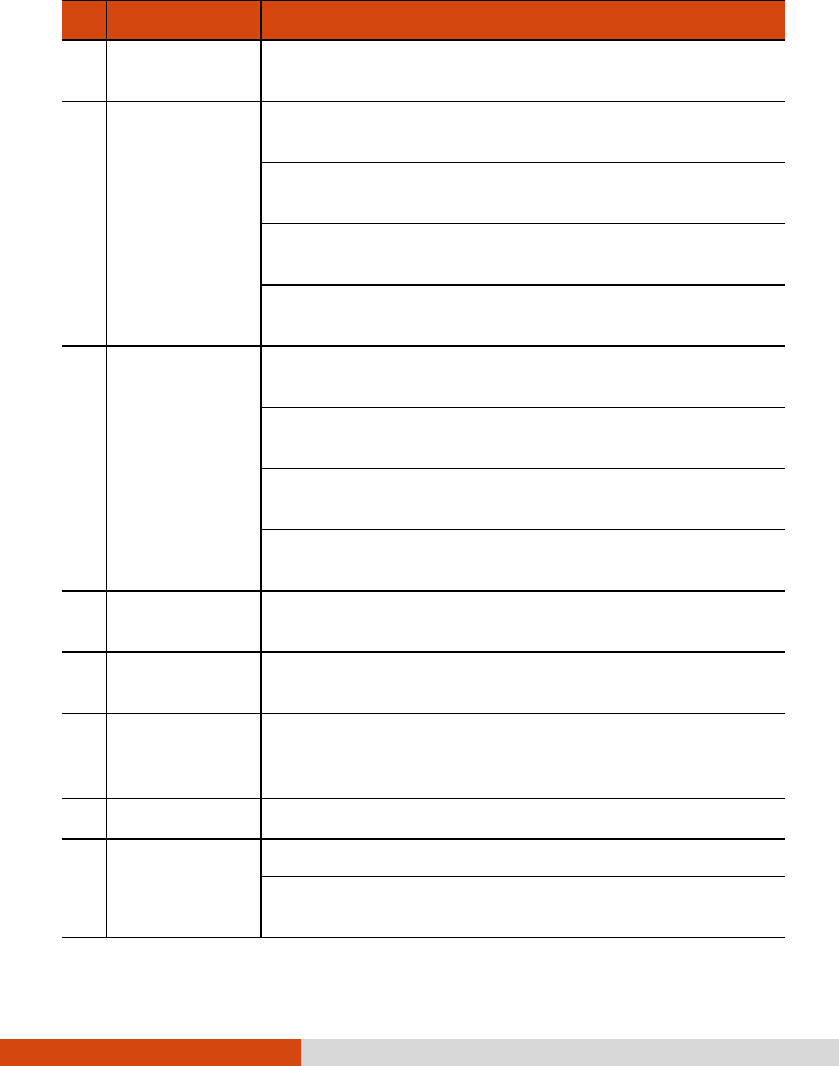
1-2 Getting Started
Ref
Component Description
Mobile Phone
Indicator
Flashes in blue to indicate that the phone function is
switched on (select models only).
RF (Radio
Frequency)
Indicator
Flashes in blue to indicate that the Bluetooth radio is
on.
Flashes in amber to indicate that the Wi-Fi (wireless
network) radio is on.
Flashes in purple to indicate that the GPS receiver is
on.
If more than one module is switched on, the indicator
changes color in a cyclic way.
Charge/
Notification
Indicator
Glows in amber to indicate that battery charging is in
progress.
Glows in green to indicate that the battery is fully
charged.
Glows in red to indicate that the battery power is
critically low (less than 10%).
Flashes in red to inform you of scheduled
appointments, alarms and reminders.
Earpiece Serves as the phone earpiece during a call (select
models only).
Touchscreen Displays the output of your device and responds to
your tapping.
Keypad Includes keys for numbers and specific functions. It
lights up when a key is pressed. (See the next section
for details.)
Power Button Turns on or off your device.
Microphone Records voices.
Serves as the mouthpiece during a call (select models
only).
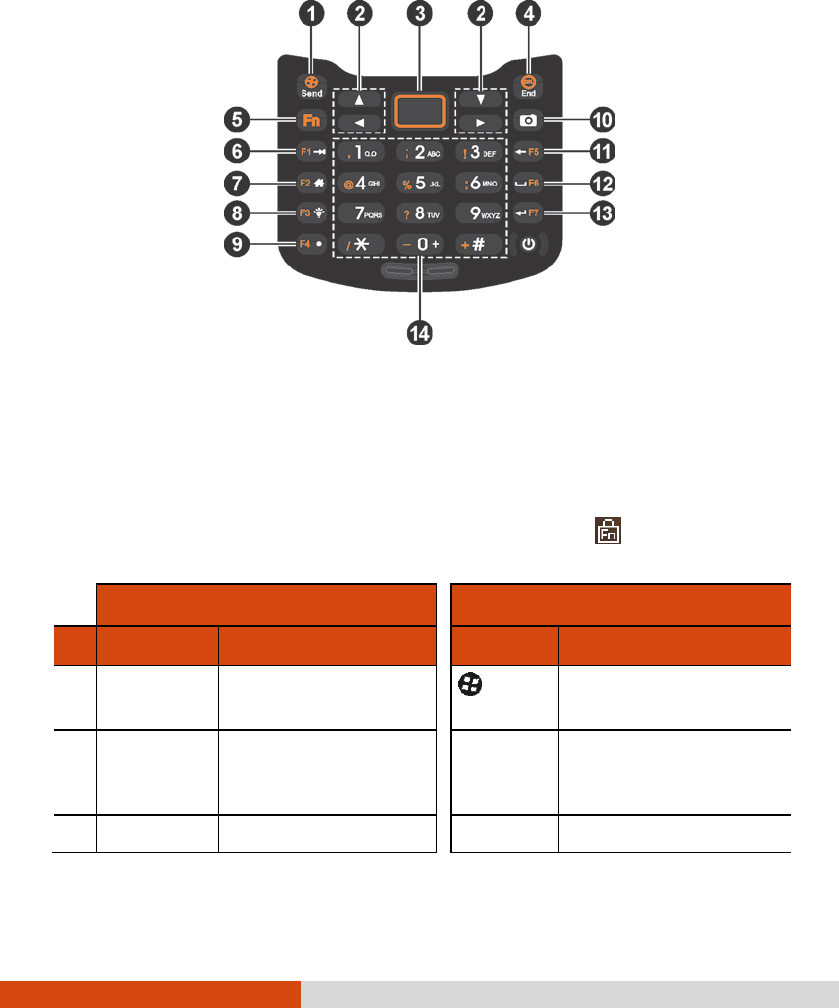
Getting Started 1-3
Keypad
The keypad provides two sets of functions:
Default functions as indicated by white icons/text.
Alternative functions as indicated by orange icons/text. You can use the
alternative functions when Fn lock is on.
Fn lock is off by default. When it is switched on, the icon shows in the
navigation bar.
Default
Alternative (with Fn Lock)
Ref
Key Description Key Description
Send Key Dials or answers a call
(select models only).
Start Key
Opens the Start menu
Arrow
Keys
Moves up, down, left
and right within the
screen or menu.
– –
Scan Key Starts RFID Demo. – –
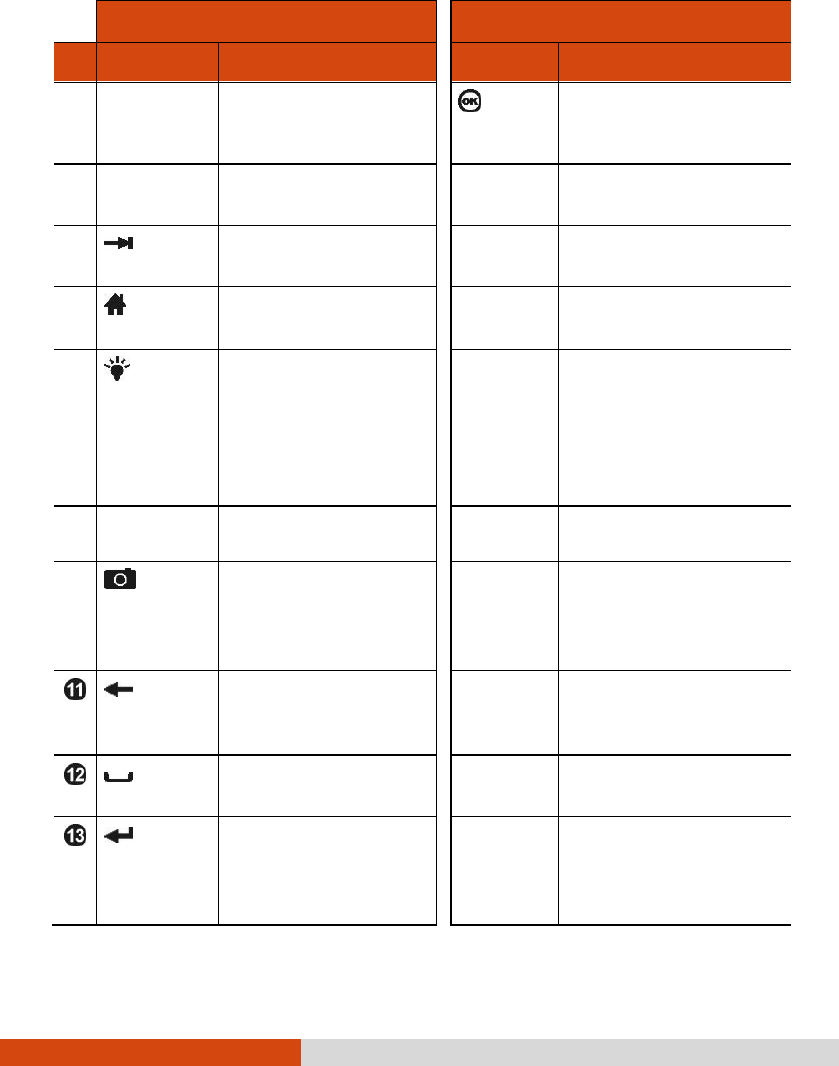
1-4 Getting Started
Default
Alternative (with Fn Lock)
Ref
Key Description Key Description
End Key Ends or rejects a call
(select models only).
OK Key
Closes the current
displayed menu or
program
Fn Lock Key
Switches on the
alternative functions.
Fn Unlock
Key
Switches off the
alternative functions.
Tab Key
Goes to the next
input field.
F1 Key Starts TacLink.
Home Key
Returns to the Home
screen.
F2 Key Starts Notes.
Brightness
Key
Increases the
brightness level of the
screen. It cycles to the
lowest level after
reaching the highest
level.
F3 Key Starts Task Manager.
Dot Key Enters a dot. F4 Key Starts Settings.
Camera
Key
Starts the Camera
program and serves
as the shutter release
button.
– –
Backspace
Key
Backspaces over one
character when in a
text input field.
F5 Key Starts Search.
Spacebar
Enters a space. F6 Key Starts File Explorer.
Action Key
Confirms your
selection by pressing,
similar to the Enter
key on a keyboard.
F7 Key Starts Calculator.
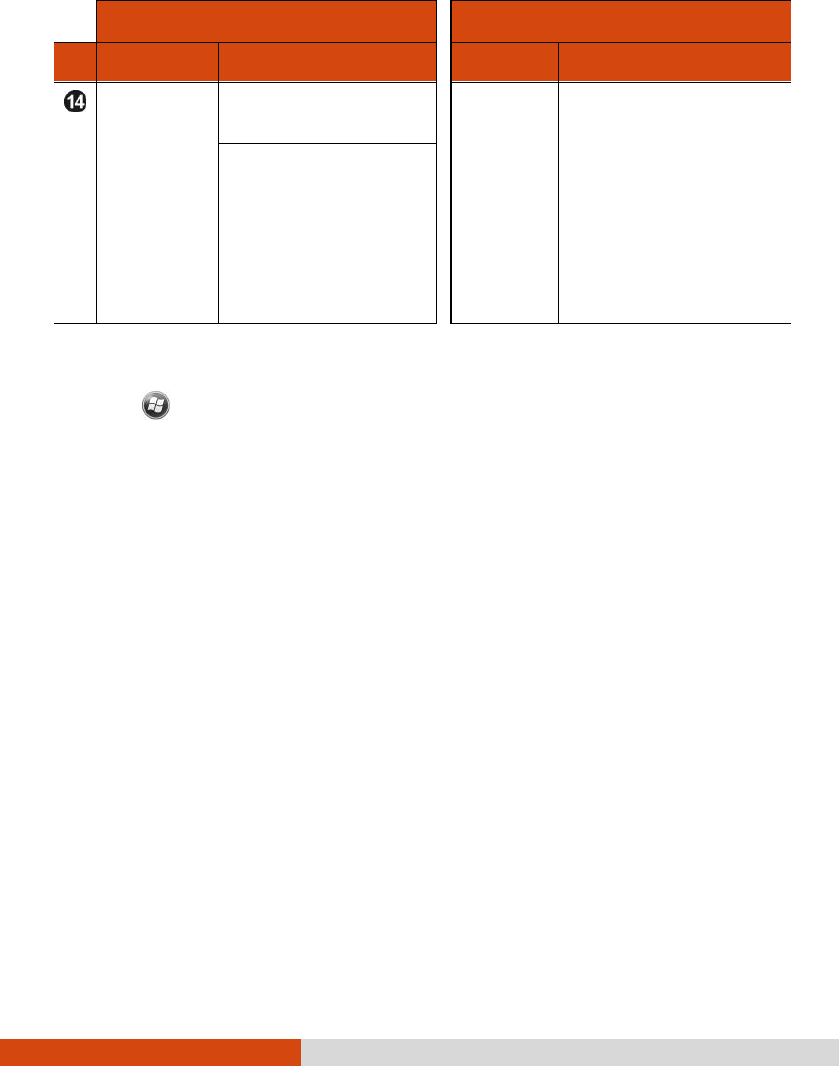
Getting Started 1-5
Default
Alternative (with Fn Lock)
Ref
Key Description Key Description
Numeric
Keys
Enter numbers by
default.
Symbol
Keys
Enter symbols as
indicated by the
orange icons. (Not
available for the Phone
program.)
Enter text without
the on-screen
keyboard. (See
“Entering Text Using
the Physical Keypad”
in Chapter 2 for
information.)
NOTE: The functions of F1 – F7 keys and Scan key described in the above
table are default settings. You can assign a different program to the key by
tapping Settings Personal Buttons.
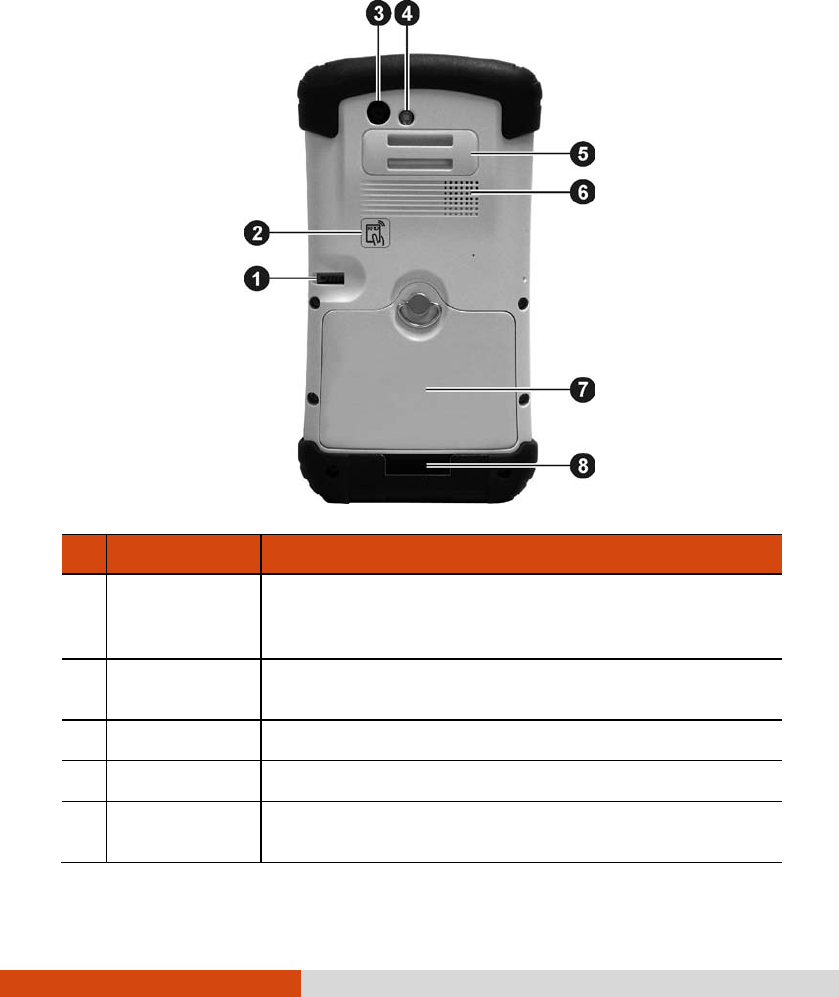
1-6 Getting Started
Back Components
Ref
Component Description
Stylus Serves as the input device by tapping on the
touchscreen to make selections and enter
information.
RFID Antenna Inside is the RFID antenna that reads RFID (Radio-
frequency identification) tags.
Camera Lens Takes still pictures or records video clips.
Flash Provides extra light when taking pictures.
Hand Strap
Holders
The hand strap attaches here.
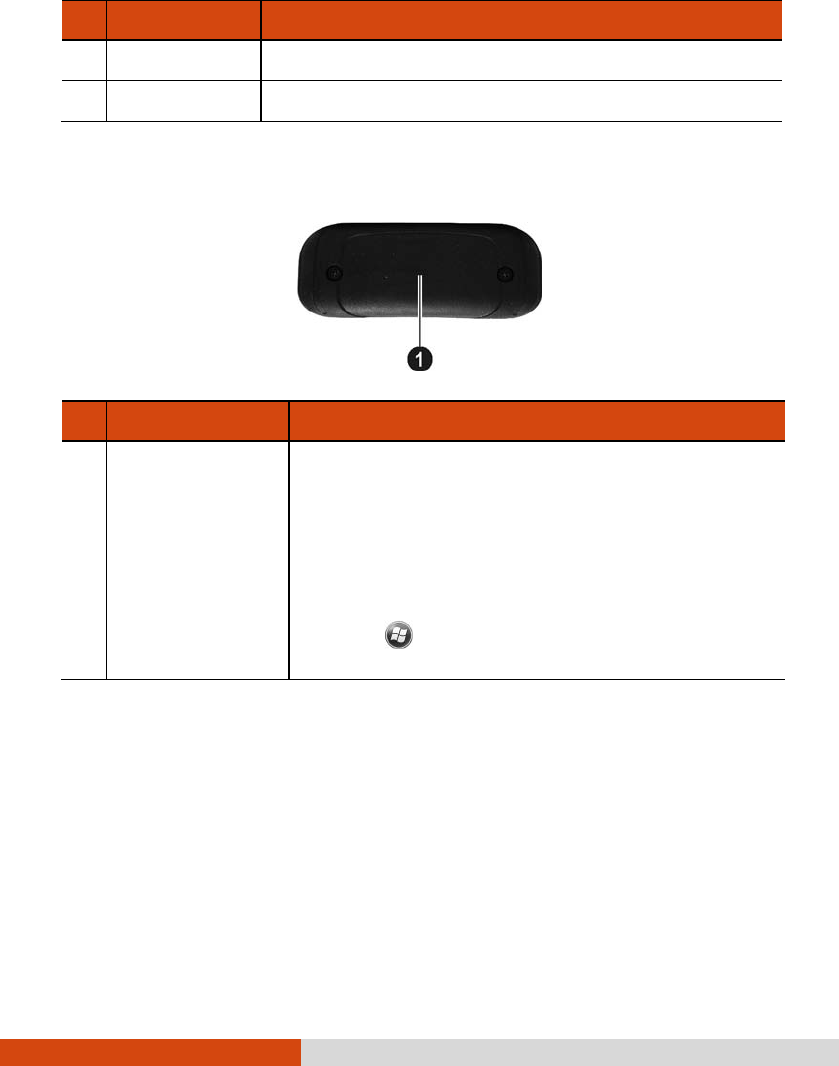
Getting Started 1-7
Ref
Component Description
Speaker Plays music, sounds and voices.
Battery Cover Inside is the battery.
Top Components
Ref
Component Description
Expansion Port
Cover
Inside is the Expansion Port (FlexiConn™ Mini-PCIE
type) that allows you to use a Getac proprietary
accessory for additional functions. (Contact your
sales representative for technical information of
FlexiConn™ if needed.)
NOTE: The expansion port and the RS232 serial port
cannot be used at the same time. When using the
port, tap
Settings
System
Serial Port
Switch to set up accordingly.
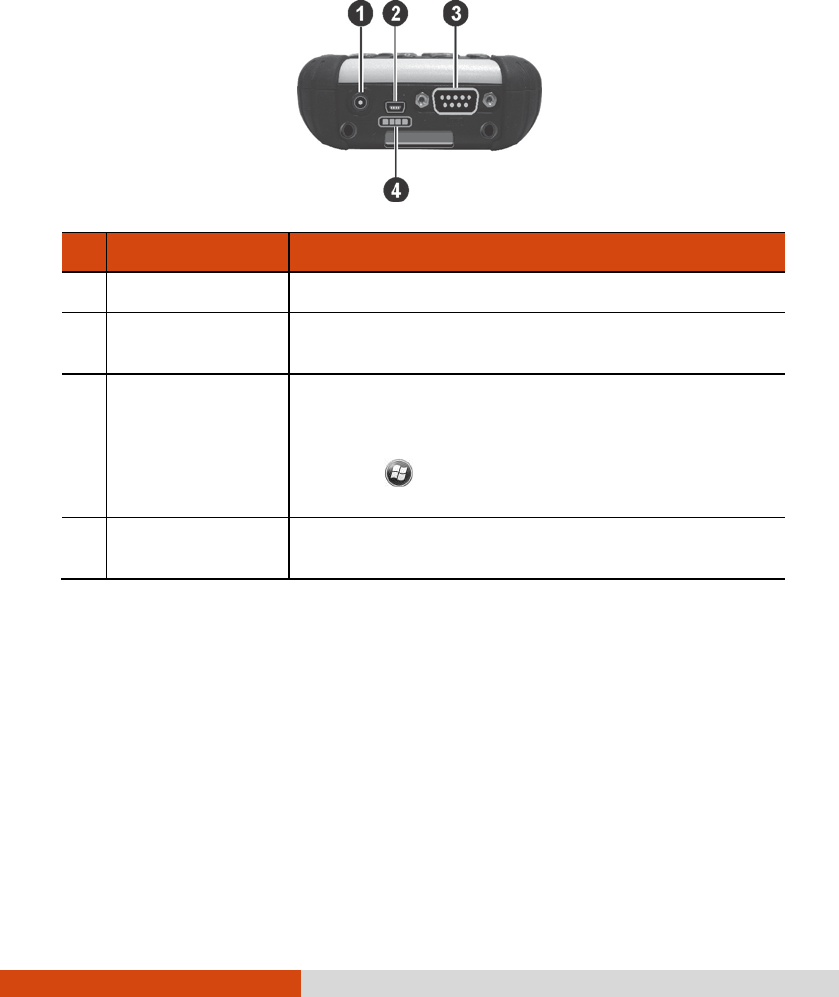
1-8 Getting Started
Bottom Components
Ref
Component Description
Power Connector Connects to the AC adapter.
USB OTG (Host &
Client) Connector
Connects to the USB cable.
Serial Port Provides D-sub 9 pins RS232 function.
NOTE: The expansion port and the RS232 serial port
cannot be used at the same time. When using the
port, tap
Settings
System
Serial Port
Switch to set up accordingly.
Docking
Connector
Connects to the office dock (an option).
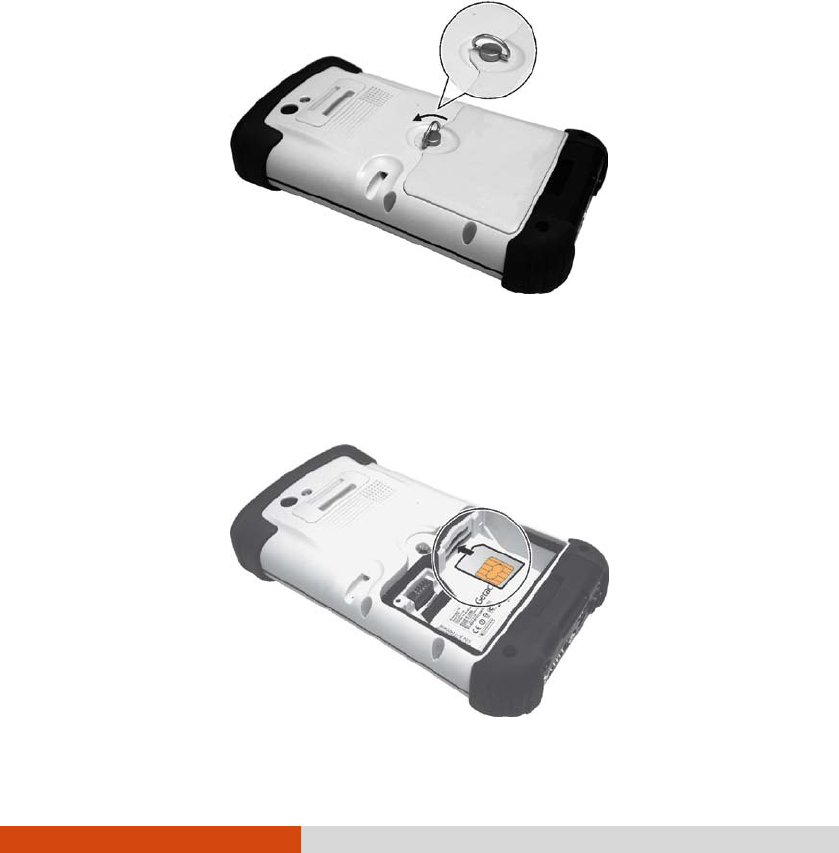
Getting Started 1-9
Getting Your Device Ready for Use
Installing the SIM Card and Battery
1. Lift the latch handle of the battery cover and turn it counterclockwise to
the unlock (vertical) position. Then, detach the cover from the device.
2. If you model has the phone function, you need to install the SIM card
provided by your mobile operator. With the SIM card’s chip side facing
up and the beveled corner pointing to the slot (the lower one), insert the
card all the way into the slot.
Unlock
position
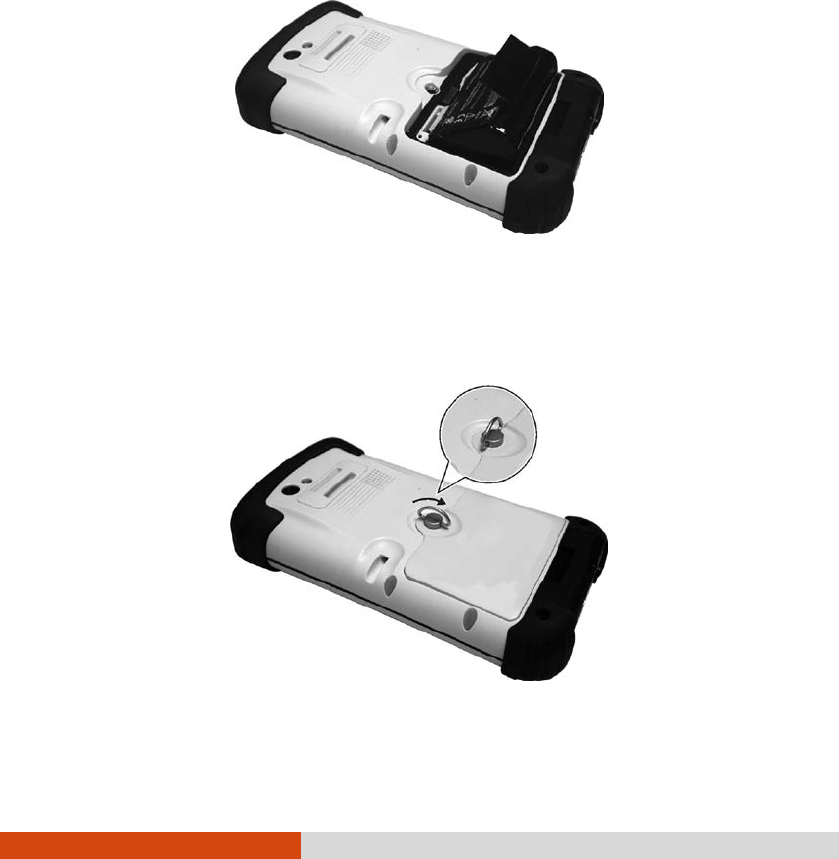
1-10 Getting Started
NOTE: To remove the SIM card, slightly push in the card to release it and
then pull the card out of the slot.
3. If you have a microSD card to insert, insert it into the slot. (See “Using an
MicroSD” later for more information.)
4. To install the battery, first attach the connector side of the battery to the
connector in the compartment and then lower the other side.
5. Attach the bottom side of the battery cover to the device at an angle
and then, with the handle still in the unlock (vertical) position, fit the
latch handle into place. Secure the latch by turning it clockwise to the
lock (horizontal) position.
Lock
position
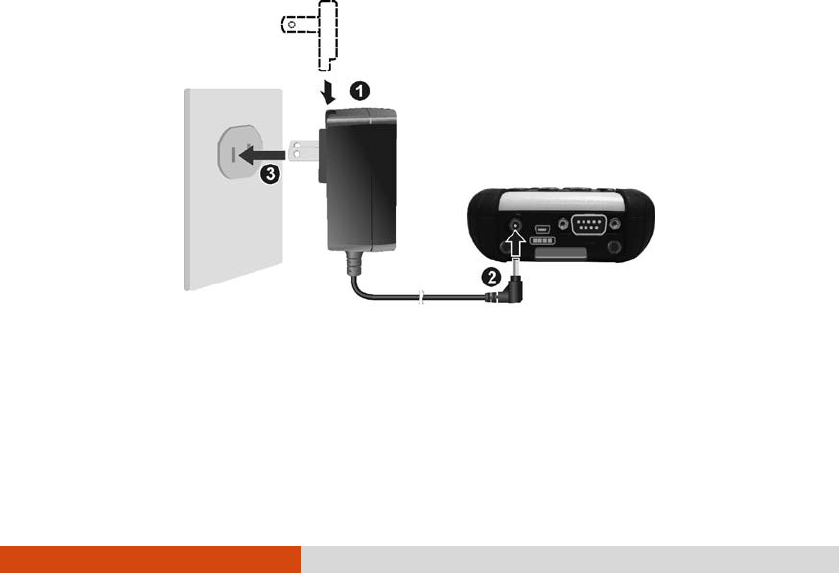
Getting Started 1-11
NOTE:
The battery cover must be locked for normal operation.
Your device supports battery hot swap. Whenever you remove the
battery cover with the device power on, the system will automatically
enter the suspend mode. As long as you replace the battery and battery
cover within180 seconds, you can press the power button to resume
operation. If the time exceeds 180 seconds, the system will automatically
shut down and any unsaved data might be lost.
Connecting to AC Power and Charging the
Battery
Be sure to fully charge the battery before using your device for the first time.
1. Fit the converter plug to the AC adapter ().
2. Connect the DC jack end of the AC adapter to your device () and the
other end to a wall outlet ().
3. The charge indicator glows in amber when charging is in progress. Do
not disconnect your device from AC power until the battery is fully
charged, as indicated by the amber indicator turning into green. This will
take a couple of hours.

1-12 Getting Started
CAUTION: For optimal performance of the lithium battery, take note of the
following:
Use the included AC adapter only.
There is no need to fully discharge the battery before charging. You can
charge the battery before it is discharged.
Do not charge the battery where the temperature is high (e.g. in direct
sunlight).
As a protection against damage, your device stops charging when the
battery’s temperature is extremely high or low. In high temperature
conditions, the charging stops when the battery’s temperature gets
above 70°C (158°F) and continues when the temperature lowers to 60°C
(140°F). In low temperature conditions, the charging stops when the
temperature gets below -5°C (23°F) and continues when the
temperature rises to 0°C (32°F).
If you will not use the product for a long period of time, be sure to fully
charge the battery at least once every two weeks. Over discharge of the
battery can affect the charging performance.
Performing the Initial Startup
When turning on your device for the very first time, you will be guided
through a setup process.
1. Make sure that your device is either connected to AC power or the
battery has power.
2. Press the power button to turn on your device.
3. The setup screen appears. Follow the on-screen instructions to complete
the setup wizard.
4. After the setup is completed, the Home screen appears. You can now use
your device.

Getting Started 1-13
Quick Help
The Home screen provides a getting started item. You can quickly access
most-needed settings from here.
Tap getting started on the Home screen. Brush left or right to see available
items such as ringtone, e-mail, Bluetooth headset, and others. Tap the item
you want to set up. To obtain information on using the device, tap View All
in the toolbar and Online help & how-to. (Internet connection is required.)
Synchronizing with Your
Computer
ActiveSync and Windows Mobile Device Center (WMDC) provide an easy way
to synchronize data on a Windows-based computer with your device.
ActiveSync works on computers that have the Windows XP operating
systems. WMDC works only on computers that have Windows Vista or
Windows 7.
ActiveSync and WMDC act as gateways between your device and your
computer for transferring Outlook e-mail, appointments, contacts, and
tasks, and media such as pictures, music, and videos. You can also use the
Explore feature in either program to move files or programs from your
computer to your device.
Installing ActiveSync or WMDC
If you’re using Windows XP or earlier versions of Windows, download and
install the latest ActiveSync. If you’re using Windows Vista or Windows 7,
download and install the latest Windows Mobile Device Center. (Visit the
Microsoft website to download the program and to obtain operating
instructions.)
NOTE:
Before installation, make sure that you have Microsoft Outlook installed
on your computer.
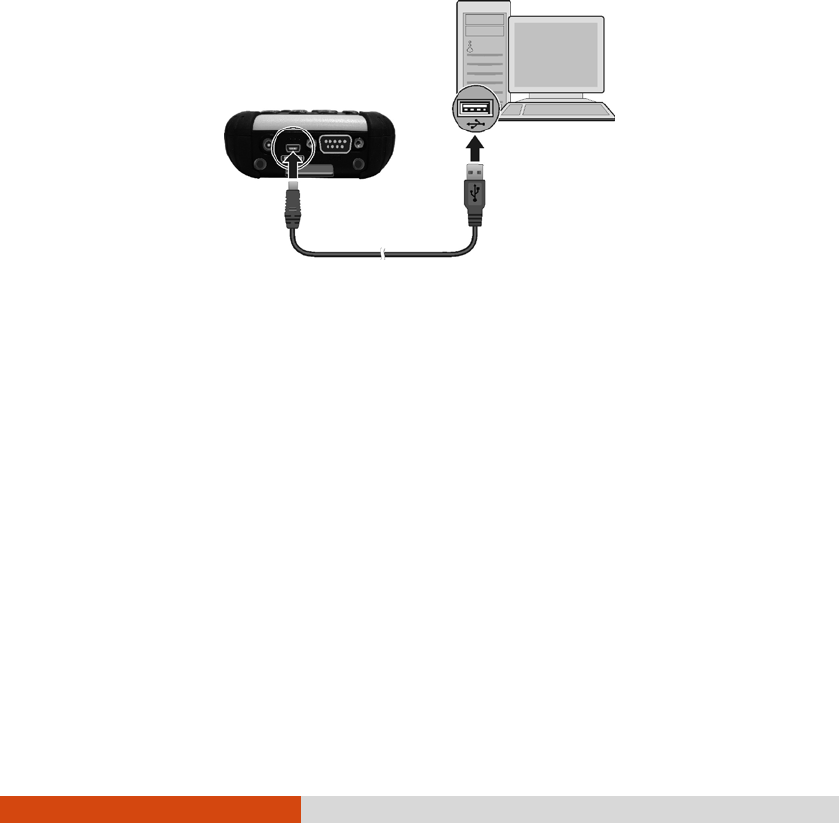
1-14 Getting Started
Connect your device to the computer AFTER Windows Mobile Device
Center or ActiveSync is installed.
ActiveSync connection problems may occur in some specific cases. They
are likely caused by interoperability with desktop firewall applications
or applications that manage network traffic. For troubleshooting
information, visit the Microsoft web site.
After the software installation, connect your device to your computer with
the USB cable and you are ready to synchronize.
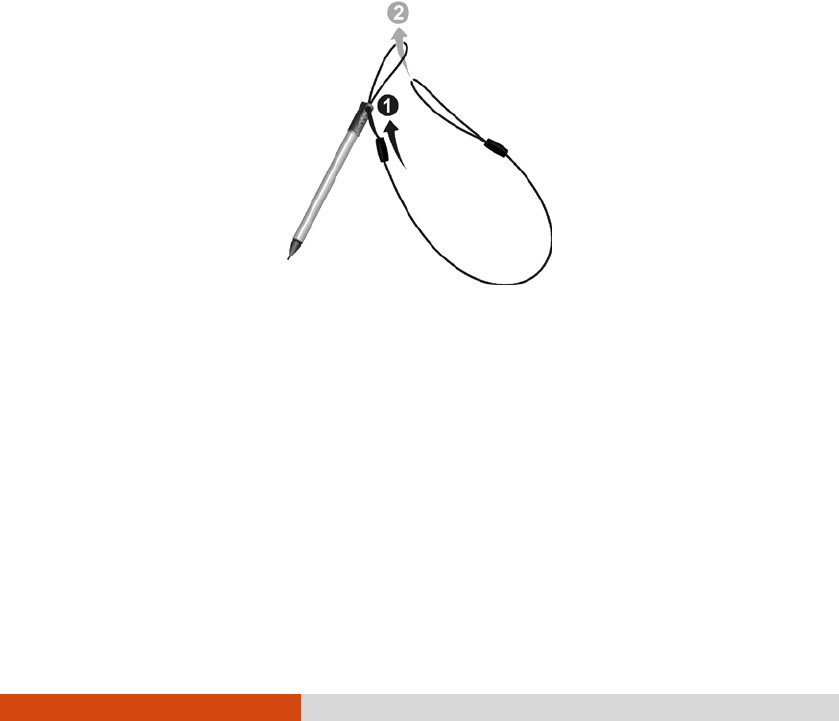
Getting Started 1-15
Using Options
Using the Tether
NOTE: Attach the tether for the stylus to the device before attaching the
hand strap.
A tether is provided for attaching the stylus to your device.
1. Insert one of the tether’s loop ends through the hole of the stylus (as
indicated by below). Then, insert the other end through the first loop
(as indicated by below) and pull it tight.
2. Insert the other loop end to the holder on the device (as indicated by
below). Then, insert the stylus end through the loop (as indicated by
below) and pull it tight.
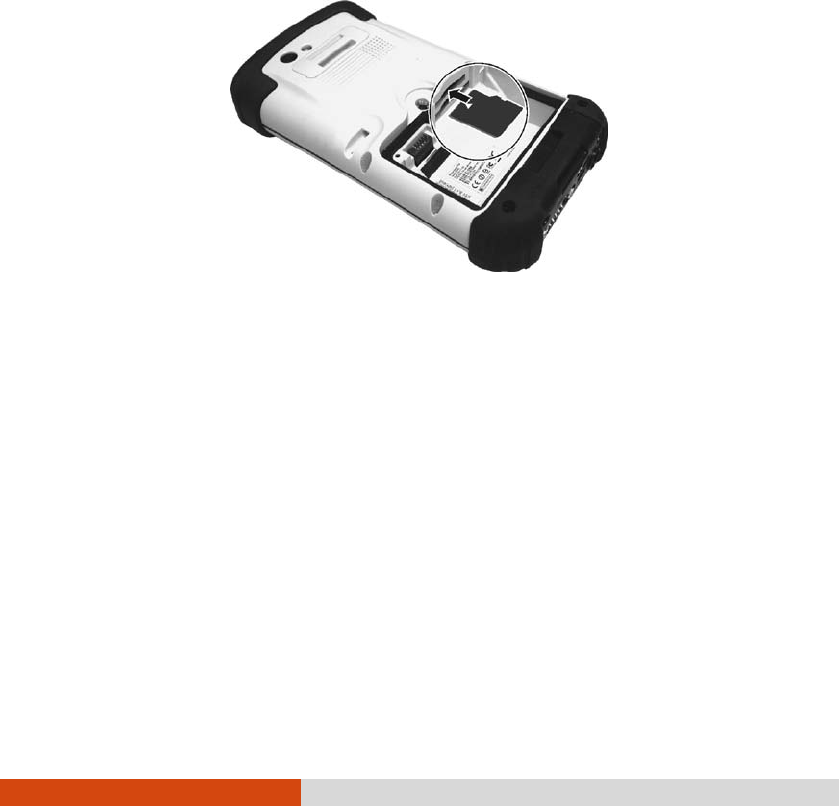
Getting Started 1-17
Using an MicroSD
Your device has a microSD card slot where you can insert a microSD card for
removable extra storage. To insert a microSD card:
1. Remove the battery. (Refer to “Installing the SIM Card and Battery”
earlier in this chapter.)
2. Insert the card into the slot, with the connector pointing to the slot (the
upper one) and its label facing the back of the device.
To remove the microSD card, slightly push the card edge to release it and
then pull the card out of the slot.
3. Replace the battery and battery cover.

Basic Skills 2-1
Chapter 2
Basic Skills
This chapter familiarizes you with the basic operations of your device.
CAUTION: The device can get uncomfortably warm when you use it in high
temperatures. In such a circumstance, please take safety measures (such as
wearing gloves) to protect yourself. Prolonged body contact can cause
discomfort and potentially a burn.
Power Saving and Turning Off
Backlight Off
The backlight of the screen dims out after a period of inactivity (default 1
minute on battery power and 2 minutes on external power).
To restore the backlight, tap the screen. Note that where you tap or what
you press also causes the related task to be performed.
Entering the Suspend Mode
Your device automatically suspends after a period of inactivity (default 3
minutes on battery power and 5 minutes on external power).
To manually suspend the device, briefly press the power button.
NOTE: (For models with the phone function only) The Mobile Phone
Indicator keeps on flashing when your device is suspended. Any incoming
call will resume your device.
To resume operation, press the power button. You will be back to where
you left off.
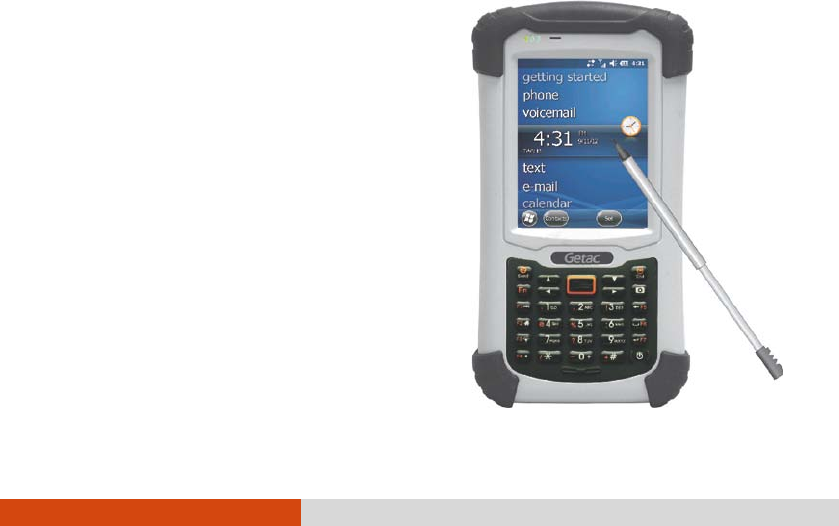
2-2 Basic Skills
Turning Off
If you are not using your device, press and hold the power button for at least
5 seconds until the device plays a notification sound and turns off.
Navigating on the Screen
Using the Touchscreen
CAUTION: Do not use a sharp object such as a ballpoint pen or pencil on
the touchscreen. Doing so may damage the touchscreen surface. Use the
included stylus or your finger.
NOTE: Pull the stylus out of the slot and extend it for ease of use. Store it in
the slot when not in use.
Use the stylus (or your finger) to navigate and select objects on the screen.
Here are some common terms that you should know when using the
touchscreen:
Tap
Touch the screen once with the stylus
to open items and select options.
Drag
Hold the stylus on the screen and drag
across the screen to select text and
images. Drag in a list to select multiple
items.
Tap and hold
Tap and hold the stylus on an item to
see a list of actions available for that
item. On the shortcut menu that
appears, tap the action you want to
perform.
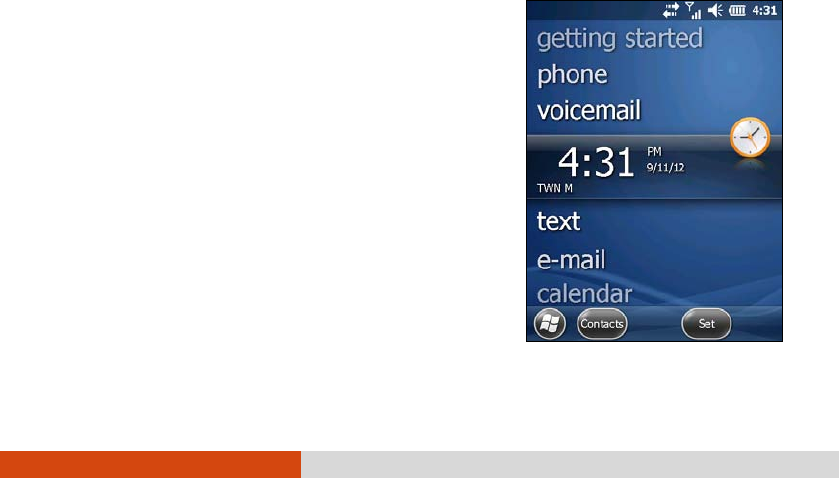
Basic Skills 2-3
Screen-touch gestures make it easier to navigate your device. Gestures you
can use are:
Scroll
Brush up or down on the touchscreen with the stylus, and lift the stylus
off when you reach the edge. To stop scrolling, tap the screen.
Pan
Place the stylus on the screen and move it around for more controlled
navigation. To stop panning, tap the screen.
NOTE: Not all applications support screen-touch gestures.
Using the Keypad
You can also use the keypad to navigate on the screen. (See “Keypad” in
Chapter 1 for information.)
Home Screen
The Home screen appears whenever you turn on your device after shutting it
down or resume the operation after 4 hours of inactivity.
The Home screen provides shortcuts to
frequently-used features. It shows information
such as your appointments, missed calls, and
unread messages, and provides quick access to
your music, pictures, and other applications.
All items are displayed in a scrollable list and the
item in the center is always the active item.
Brush
up or down on the screen to see more items.
When an item is active, it displays additional
information and action(s) you can take. When
there is more than one action, you can brush left
or right within the item to see the next or
previous action.
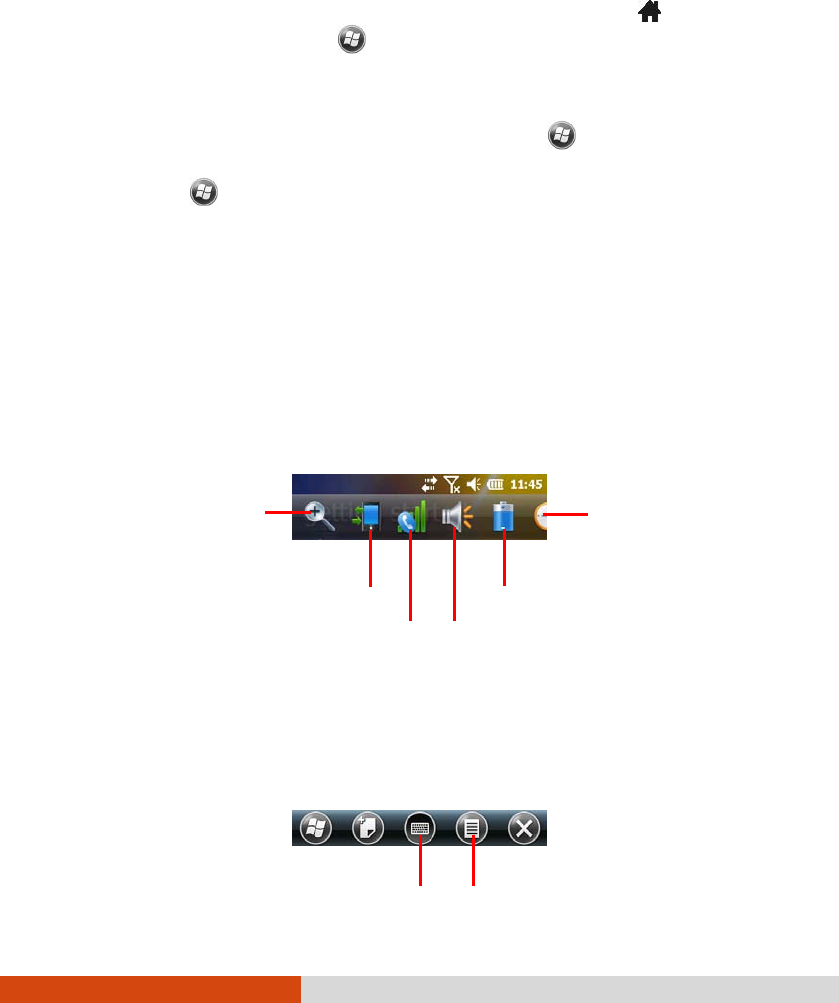
2-4 Basic Skills
You can conveniently perform a task by tapping the active item or the soft
button in the toolbar.
The Home screen is accessible from anywhere by pressing the Home key
on your device or by tapping (at the left-bottom corner of the screen)
and then Home.
NOTE:
You can customize the Home screen by tapping Settings Home.
You can use your device in a landscape manner. To change the screen
view, tap Settings System Screen General Landscape or
Portrait.
Navigation Bar and Toolbar
The Navigation bar is located at the top of the screen. It displays the active
program name and indicators for connectivity, volume, power, time, and
others. You can tap this bar to set up related items.
An example of the Navigation bar:
Use the toolbar at the bottom of the screen to perform tasks in the active
program. The toolbar includes buttons such as the input panel button and
Menu button.
An example of the toolbar:
Tap to set time zone,
date, and time.
Tap to adjust the volume.
Tap to zoom
in the screen.
Tap to set up various
connections.
Tap to set power options.
Menu button
Input panel button
Tap to set up phone.
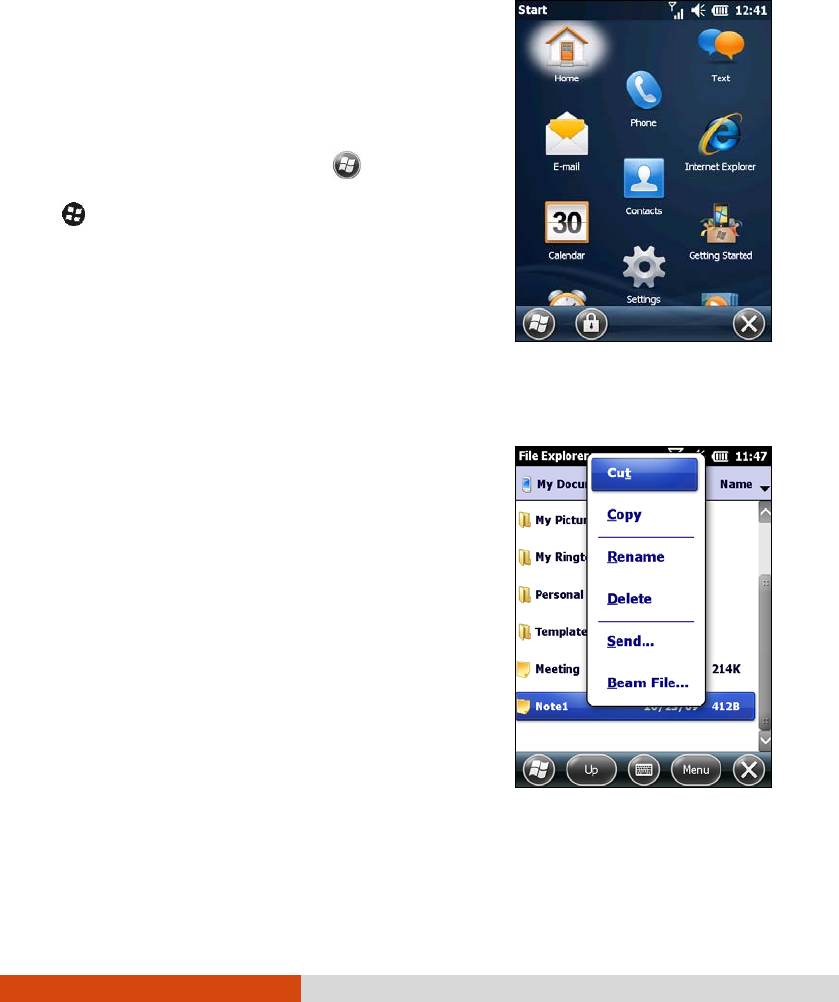
Basic Skills 2-5
Running Programs
You can switch from one program to another
without closing any program.
In addition to running a frequently-used
program from the Home sc
reen, you can access
any program from the Start menu.
To open the Start menu, tap at the
left-bottom corner of the screen or press Fn +
Start key on your device. The Start menu
contains all the program icons. You can brush
up or down on the screen to see other
program icons.
Shortcut Menus
With shortcut menus, you can quickly choose
an action for an item. The actions in the
shortcut menus vary from program to
program.
To access a shortcut menu, tap and hold the
stylus on the name of the item that you want
to perform the action on. When the menu
appears, lift the stylus and tap the action you
want to perform. Or tap anywhere outside
the menu to close the menu without
performing an action.

2-6 Basic Skills
Notifications
Your device reminds you in a variety of ways when you have something to
do. For example, if you have set up an appointment in Calendar, a task with
a due date in Tasks or an alarm in Clock, you will be notified in any of the
following ways:
A message appears on the screen.
A sound, which you can specify, is played.
The notification indicator flashes in red.
To choose reminder types and sounds for your device, tap Sounds &
Notifications.
Entering Information
You have several options for entering new information:
Use the Input panel to enter typed text, either by using the on-screen
keyboard or other input methods.
Write directly on the screen.
Draw pictures on the screen.
Speak into the microphone to record a message.
Entering Text Using the Input Panel
Use the Input panel to enter information in any program on your device.
To show or hide the Input panel, tap the Input panel button in the middle of
the toolbar. To change to a different input mode, tap and hold the Input
panel button and select from the popup menu.
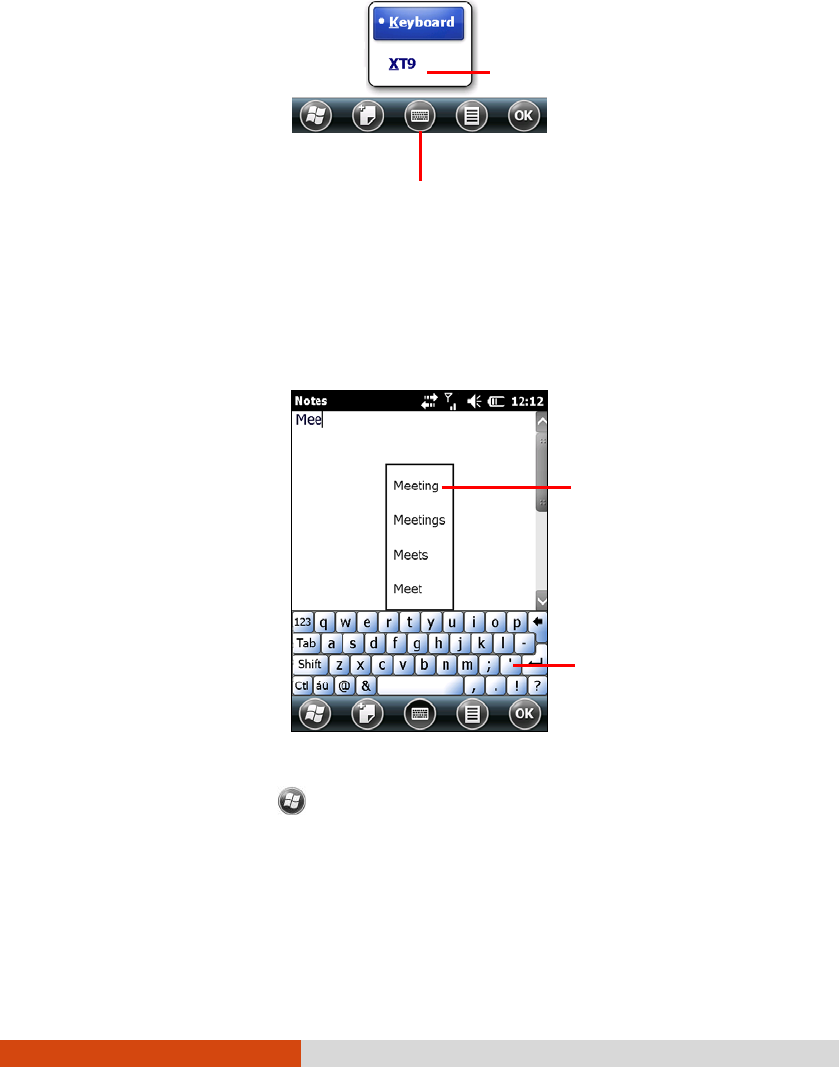
Basic Skills 2-7
Microsoft Keyboard
When you use the Microsoft Input panel, your device anticipates the word
you are typing or writing and displays it above the Input panel. When you
tap the displayed word, it is inserted into your text at the insertion point.
The more you use your device, the more words it learns to anticipate.
NOTE: You can configure the keyboard, changing from small keys to large
keys, for example. Tap Settings Personal Input.
This appears only if you have
installed the input method.
Input panel button.
Tap here if this is the
right word.
These are large keys (not
default settings).
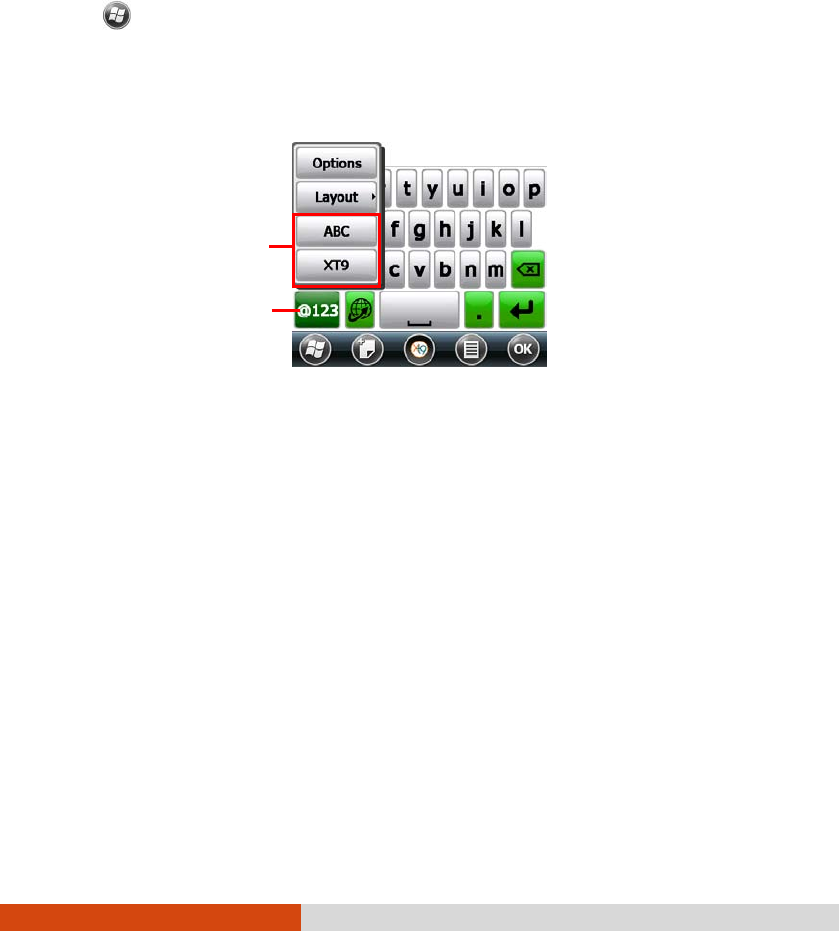
2-8 Basic Skills
XT9 Keyboard
Your device offers XT9 Text Input Software that features large keys and
allows you to enter text faster and more easily.
You have to install the software before you can use the XP9 input method.
Tap XT9 Setup to install it.
There are two input modes available: XT9 mode and ABC mode. To use a
different mode, tap and hold the @123 or ABC key (at the lower left corner)
to display the menu and then tap your selection.
The difference between XT9 and ABC modes is that XT9 mode supports
enhanced features such as visible selection list, word completion, spell
correction, and auto substitution.
In either mode, you can switch from the letter keys to the number/symbol
keys by tapping @123 and switch back by tapping ABC.
Tap and hold to
display the menu.
Tap to select a mode.
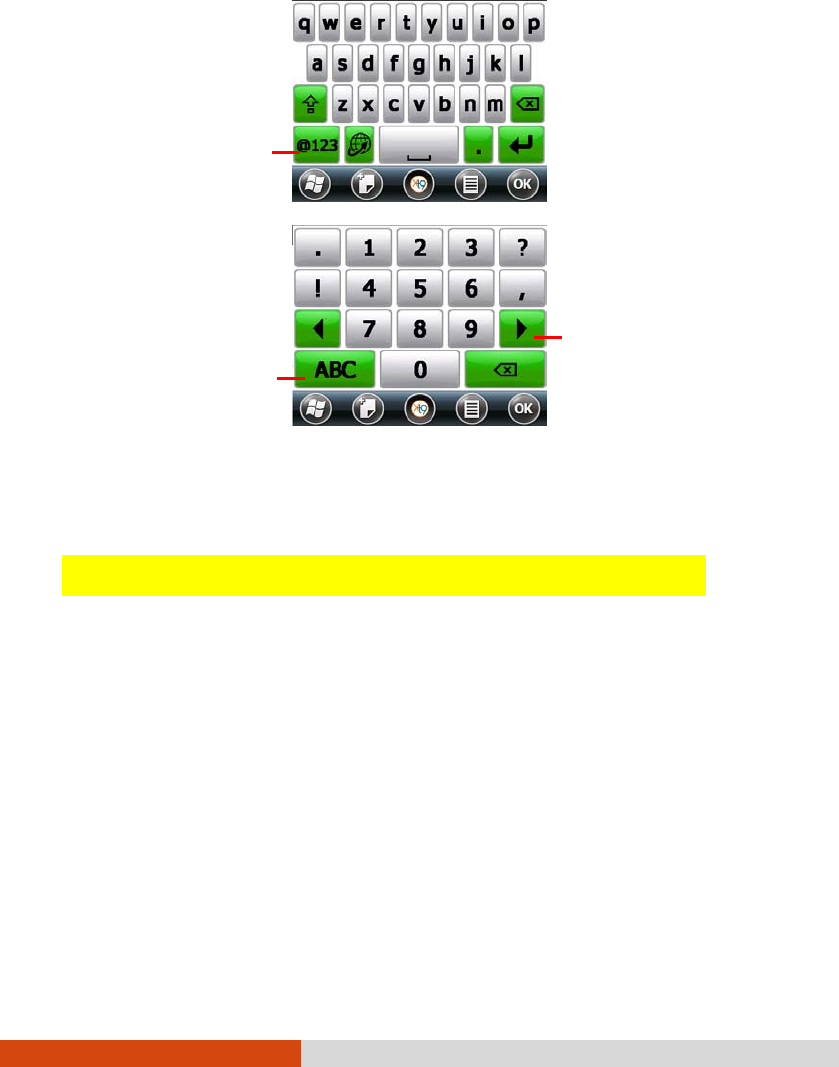
Basic Skills 2-9
For detailed information on using and customizing XT9 features, tap and
hold the @123 or ABC key (at the lower left corner) to display the menu and
then tap Options XT9 Help.
Entering Text Using the Physical Keypad
The physical keypad on your device works with XT9 Text Input Software to
provide text input capability. (You have to install the software first.) You can
use the physical keypad to enter text when the Input Panel is hidden.
NOTE: When the Input Panel is open, the text input capability of the
physical keypad will be disabled.
The keypad functions in one of the three input modes:
XT9 mode (default)
ABC mode
12# mode
Tap to switch to
number/symbol keys.
Tap to switch to
letter keys.
Tap one of the arrow
keys to cycle to the
previous or next set of
number/symbol keys.
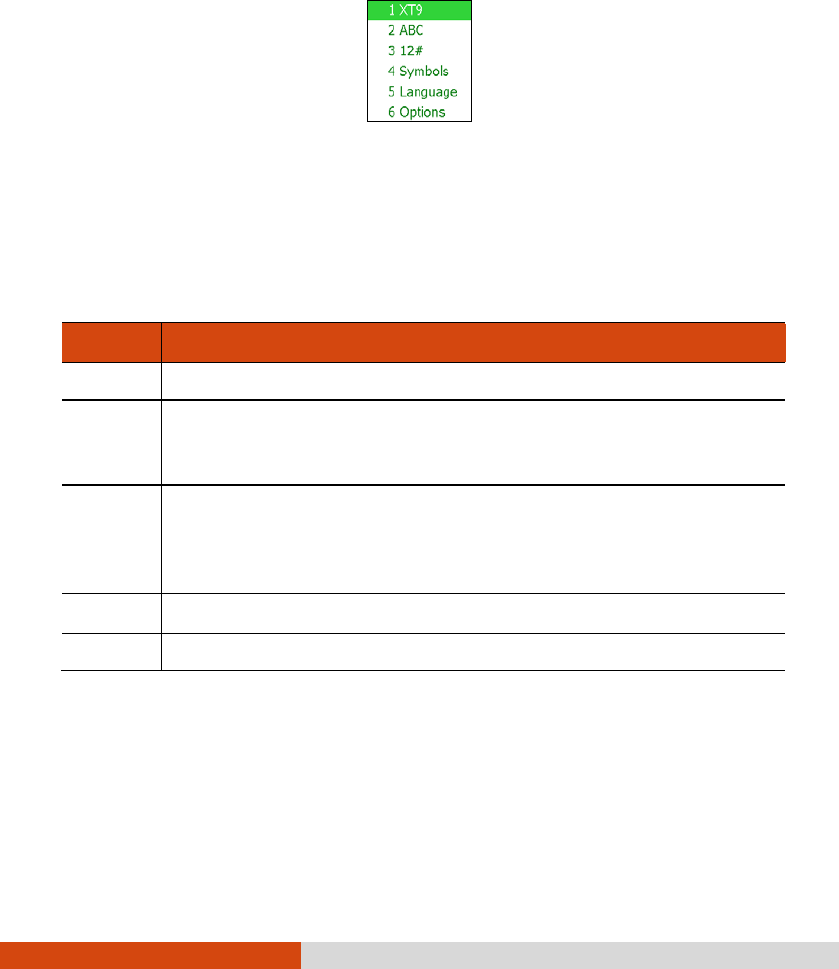
2-10 Basic Skills
To switch to a different mode, press the
*
key for a prolonged period of
time. A small options menu, as shown below, will pop up in the lower right
corner of the screen. Press 1, 2, or 3 for the mode you want.
Keypad Operation in XT9 Mode
XT9 is a smart input mode that allows you to enter words with only one
keystroke per letter. Though a key is shared by three to four letters, the XT9
mode can judge from your keystroke combination to predict the word you
want to enter. For example, to enter the word day, simply press 329.
Key Function in XT9 Mode
1 Press to show the list of punctuation marks.
2 ~ 9 Press the key containing the letter you want. A list appears at the
bottom of the screen. As you press the next key for the next
letter, the list of predicted words updates accordingly.
*
Press to switch to the next letter case choice:
xt9 (all small case letters)
Xt9 (capitalized)
XT9 (all capitals)
# Press to enter a space.
0 No function.
Keypad Operation in ABC Mode
ABC mode allows you to enter each letter of a word by pressing the key
once, twice, three, or four times until you cycle to the letter you want. For
example, to enter the word day, press 3 once, 2 once, and 9 three times.
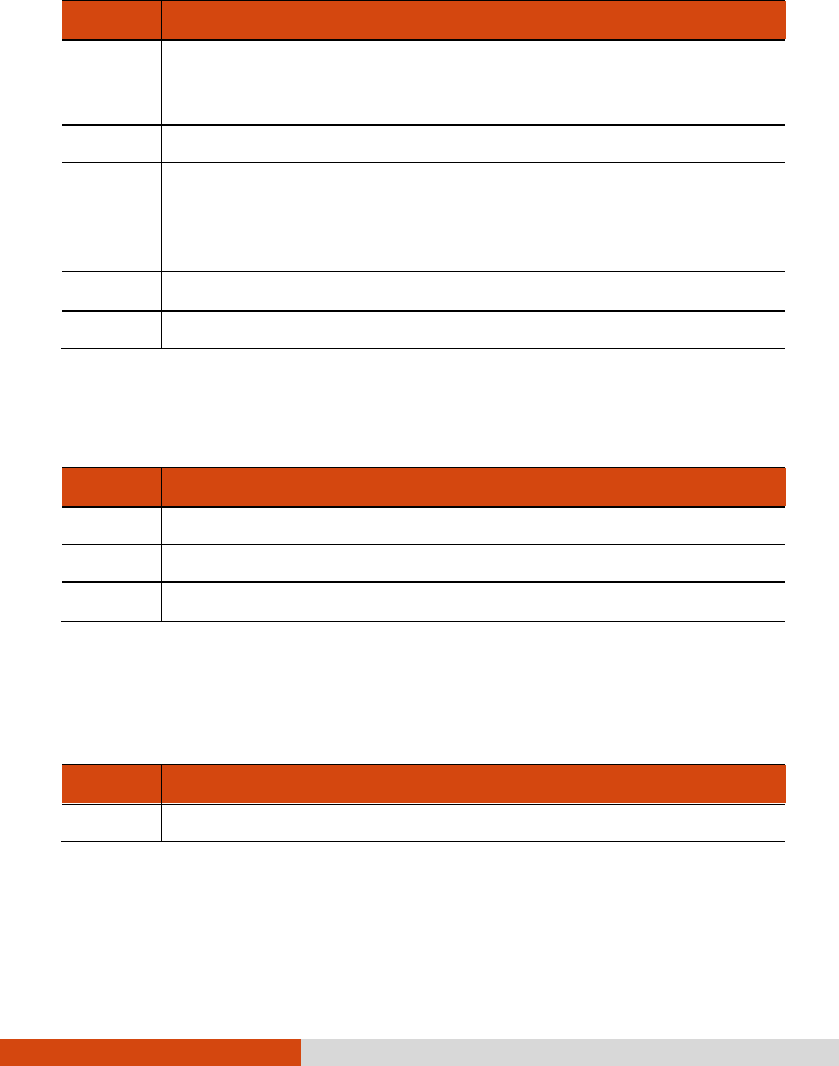
Basic Skills 2-11
Key Function in ABC Mode
1 Press as many times as needed to enter one of the below
punctuation marks.
. ? ! , - ‘ @ : /
2 ~ 9 Press as many times as needed to enter the letter you want.
*
Press to switch to the next letter case choice:
abc (all small case letters)
Abc (capitalized)
ABC (all capitals)
# Press to enter a space.
0 Press once to enter + and twice to enter 0.
Keypad Operation in 12# Mode
12# mode allows you to enter numbers.
Key Function in 12# Mode
0 ~ 9 Press to enter the number.
*
Press to return to the previous text input mode.
# Press to enter #.
Keypad Operation When Pressed Longer
The previous descriptions of the three input modes apply to short press of a
key. When a key is pressed longer in any mode, the result is as below:
Key When Pressed Longer
0 ~ 9 Press longer to enter the number.
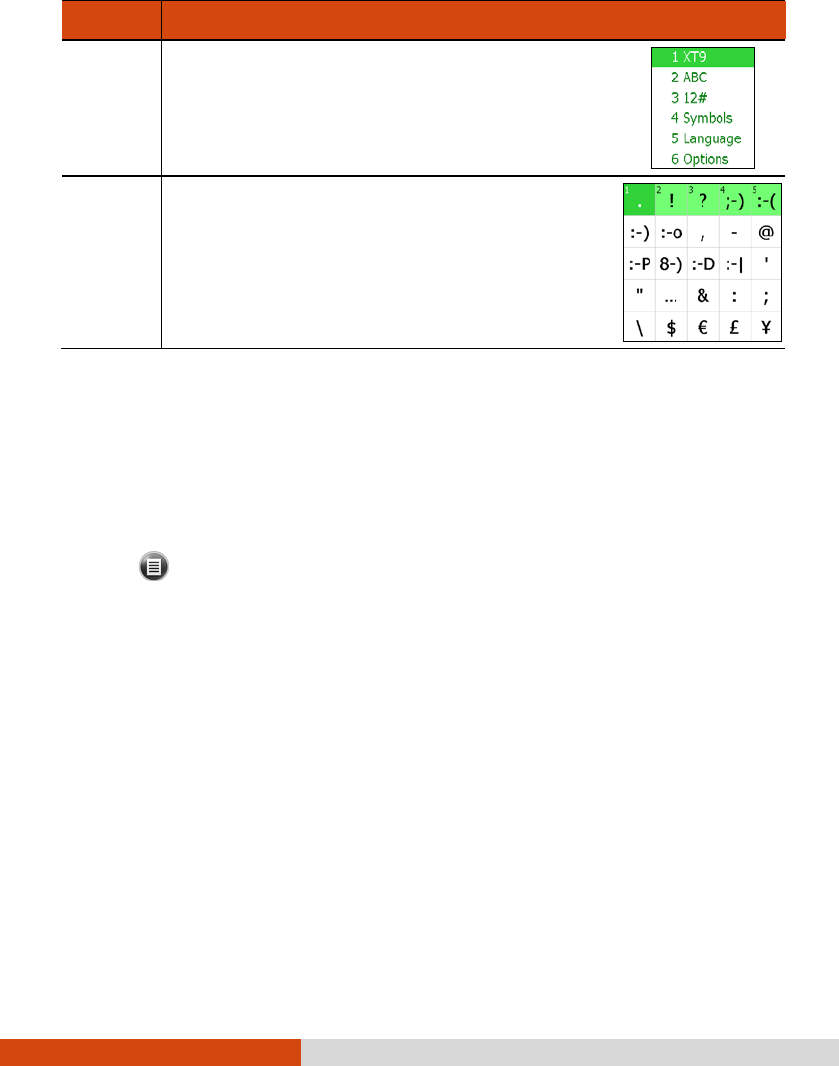
2-12 Basic Skills
Key When Pressed Longer
*
Press longer to pop up the options menu as
shown here.
# Press longer to pop up the symbols selection
menu as shown here.
Writing or Drawing on the Screen
In certain programs, such as Notes, you can write or draw on the screen as
you do on paper.
NOTE: Not all programs support the drawing mode.
1. Tap Draw to enable drawing mode. A check (√) appears before
the command.
2. To create a drawing, cross three ruled lines on your first stroke. A
drawing box appears. Subsequent strokes in or touching the drawing
box become part of the drawing.
Drawings that do not cross three ruled lines will be treated as writing.
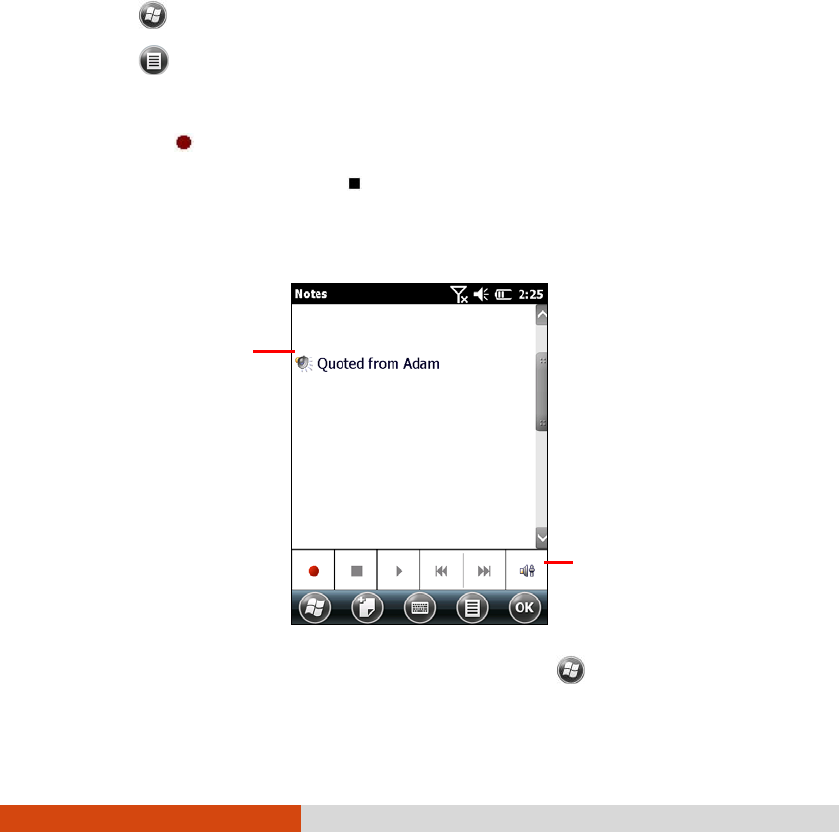
Basic Skills 2-13
Recording a Message
You can quickly capture thoughts, reminders and phone numbers by
recording a message. In the Notes program, you can either create a
stand-alone recording or include a recording in a written note. If you want
to include the recording in a note, open the note first. In the Messaging
program, you can add a recording to an email message.
To create a recording:
1. Tap Notes to switch to the program.
2. Tap View Recording Toolbar to show the Recording toolbar.
3. Hold the device’s microphone near your mouth or other source of sound.
4. Tap the Record button on the Recording toolbar to start recording.
5. To stop recording, tap the Stop button on the Recording toolbar. The
new recording appears in the note list or as an embedded icon.
To play a recording, tap it in the list or tap its icon in the note.
NOTE: You can select a recording format by tapping Notes Settings
Personal Input Options.
Indicates an
embedded recording.
Recording toolbar
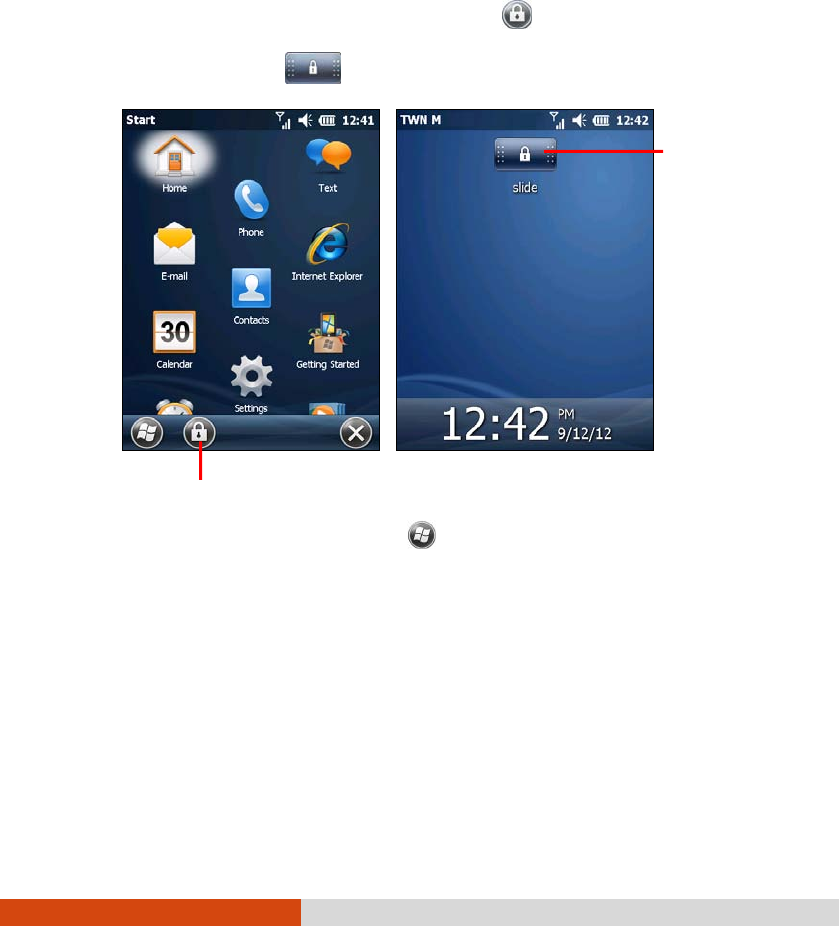
2-14 Basic Skills
Securing Your Device
Locking the Screen
You can lock the screen at any time by tapping in the toolbar of the Start
menu. This will not affect the notification messages and incoming calls. To
unlock the screen, drag left or right.
To set a password for unlocking, tap Settings Lock. When a
password is set, you will be asked to enter your password whenever you
want to use the device.
NOTE: If you forget your password, you must clear memory so you can use
your device again. (See “Restoring Factory Default State” in Chapter 8 for
instructions.)
Tap to lock.
Drag left or
right to unlock.

Basic Skills 2-15
Locking Your SIM Card
You can set a PIN (Personal Identification Number) code to protect your SIM
card against unauthorized use. (Your mobile phone network operator may
have already set a PIN for the SIM card.)
By default, your device does not enable PIN security. To enable the security
or change the PIN, tap Settings Personal Phone Security.
When enabled, you will be asked to enter the SIM card’s PIN code when
starting up the device.

Using the Phone 3-1
Chapter 3
Using the Phone
(Select Models Only)
This chapter tells you how to use the mobile phone function of your device.
About Your Phone
Select models are equipped with the HSDPA (High-Speed Downlink Packet
Access) module. HSDPA is an enhanced 3G (third generation) mobile
telephony communications protocol. It can operate on 850/900/1800/1900/
2100MHz.
To use the phone, you need to first set up an account with a mobile phone
network service. The functions available to you depend on the services
offered by your mobile phone network service provider and your type of
subscription.
Your service provider will provide you with a SIM card. This card contains
your mobile phone account details and rights, contacts that can be stored
and any additional services to which you have subscribed. You must install a
SIM card before you can make or receive phone calls or use wireless data
services. (See “Installing the SIM Card and Battery” in Chapter 1 for
installation instructions.)
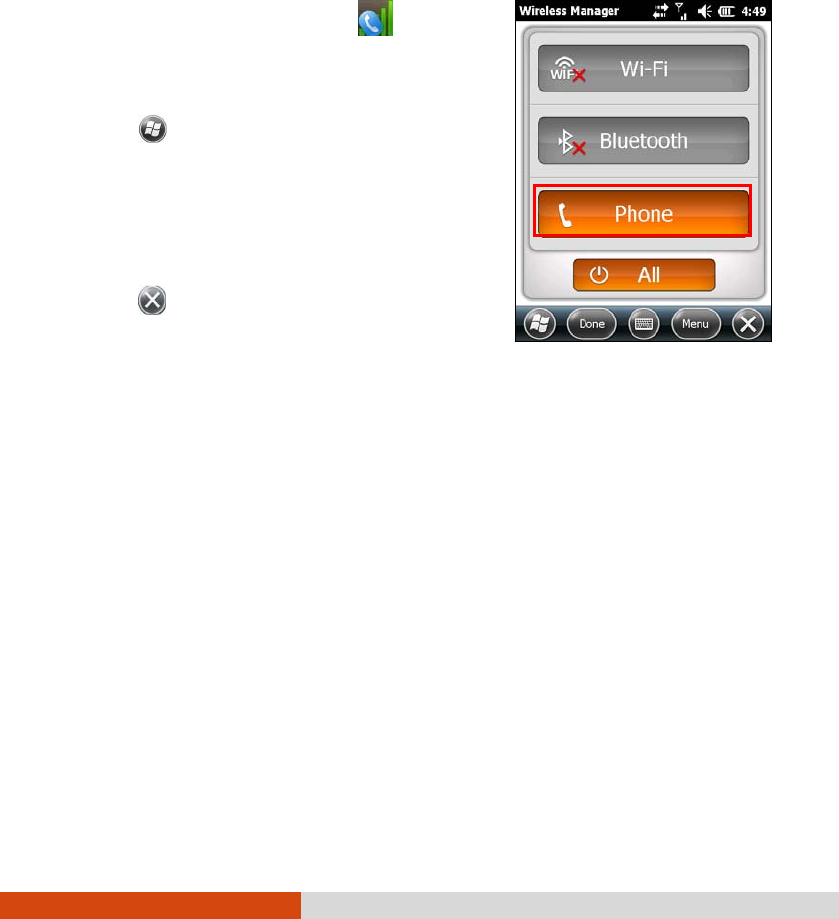
3-2 Using the Phone
Switching On or Off the Phone
When the device is turned on, the phone is switched on by default. When
needed (for example, on an airplane), you can switch off the phone without
turning off your device.
1. Tap the navigation bar and . Then tap
Wireless Manager in the popup window.
– or –
Tap Settings Connections
Wireless Manager.
2. The Wireless Manager screen appears.
Tap Phone to switch it from on to off or
the other way around.
3. Tap .
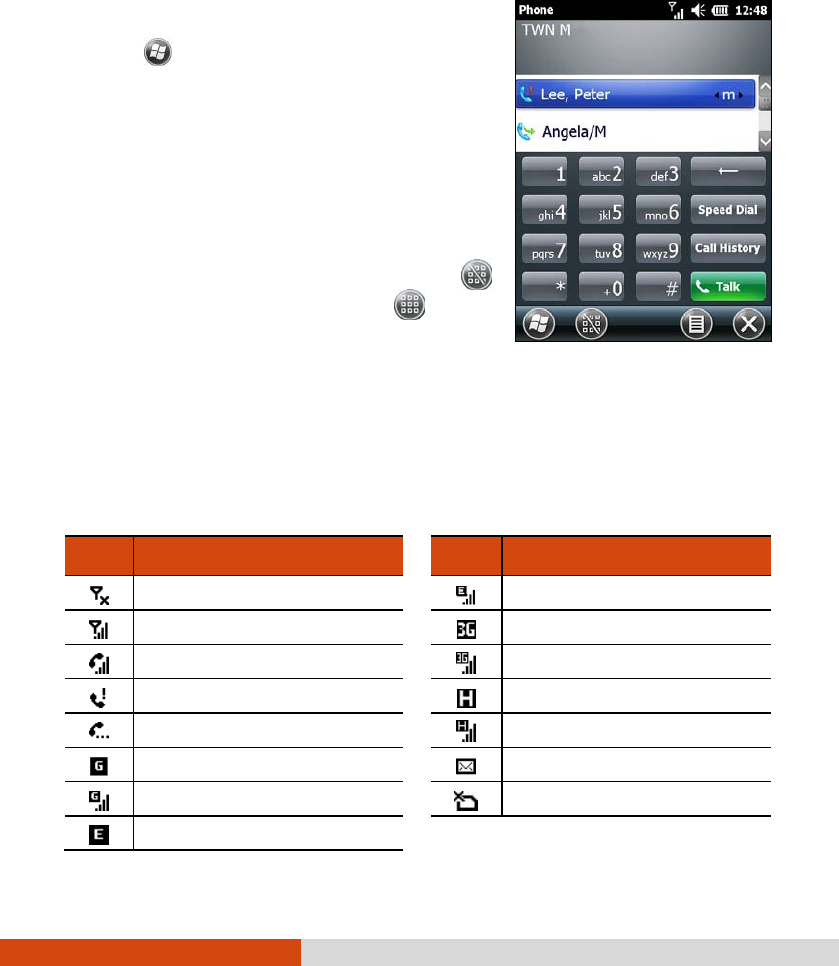
Using the Phone 3-3
Starting the Phone Program
Start the Phone program by any of the three methods:
Press the Send key on the device.
Tap Phone.
Tap the phone item on the Home screen.
Tap again if it displays “No New Missed
Calls.”
NOTE: If the phone is currently off, you will
be asked to turn it on.
Whenever you start Phone, the Phone screen
displays the onscreen keypad. You can tap
to hide it. To show the keypad, tap .
You can use other programs during a call.
To quickly switch back to Phone, press the Send key on your device.
Phone Status Icons
Icons will be displayed on the navigation bar to indicate the status of the
phone functions. They are listed below.
Icon Meaning Icon Meaning
Phone off (airplane mode) EDGE in use
Signal strength
WCDMA/UMTS available
Call in progress
WCDMA/UMTS in use
Missed call HSPA available
Call on hold HSPA in use
GPRS available New message
GPRS in use Missing SIM card
EDGE available
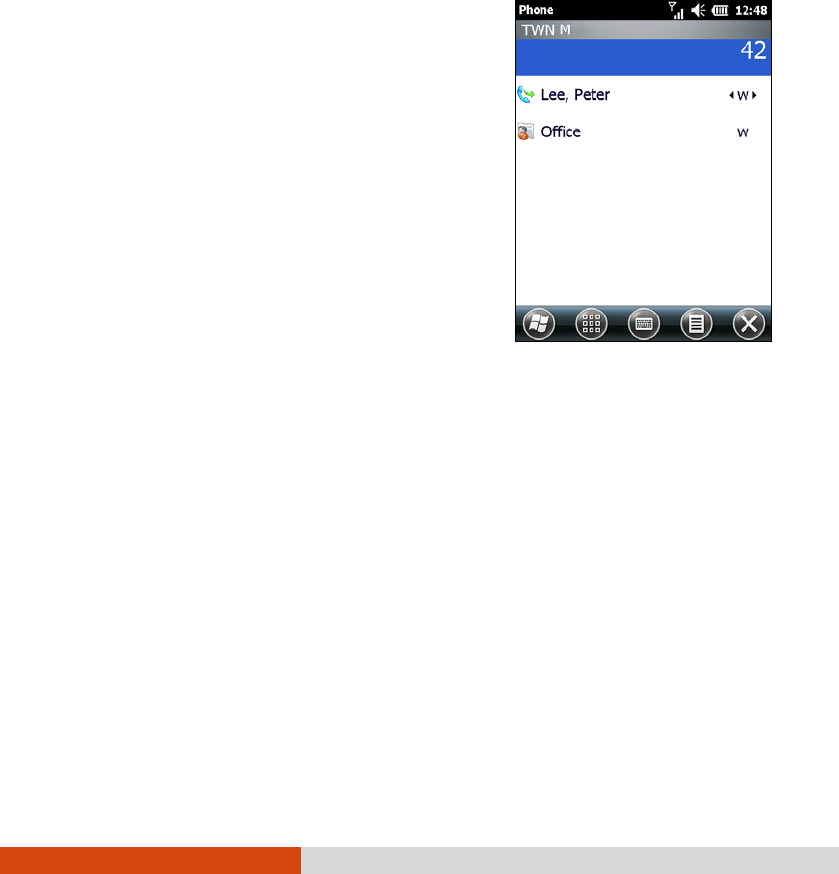
3-4 Using the Phone
Making a Call
There are several ways you can make a call.
Dialing a Call
1.
When on the Home screen: Press the
numeric keys on your device to start
entering the phone number. Your device
will automatically switch to the Phone
program.
While in the Phone program: Enter the
phone number using the physical or
onscreen keypad.
2. As you enter the phone number, the
program searches Contacts, Call History,
and Speed Dial to find a matching name
and/or number. When you see the name
of the person to call listed, select it and
the desired phone number.
Or, you can continue entering the complete phone number.
3. Press the Send key on your device to make the call.
NOTE:
If you enter a wrong number, use the Backspace key to erase individual
numbers one at a time.
If you are making an international call, tap and hold on the number key
0 until the + sign appears. The + sign replaces the international prefix of
the country from where you are calling.
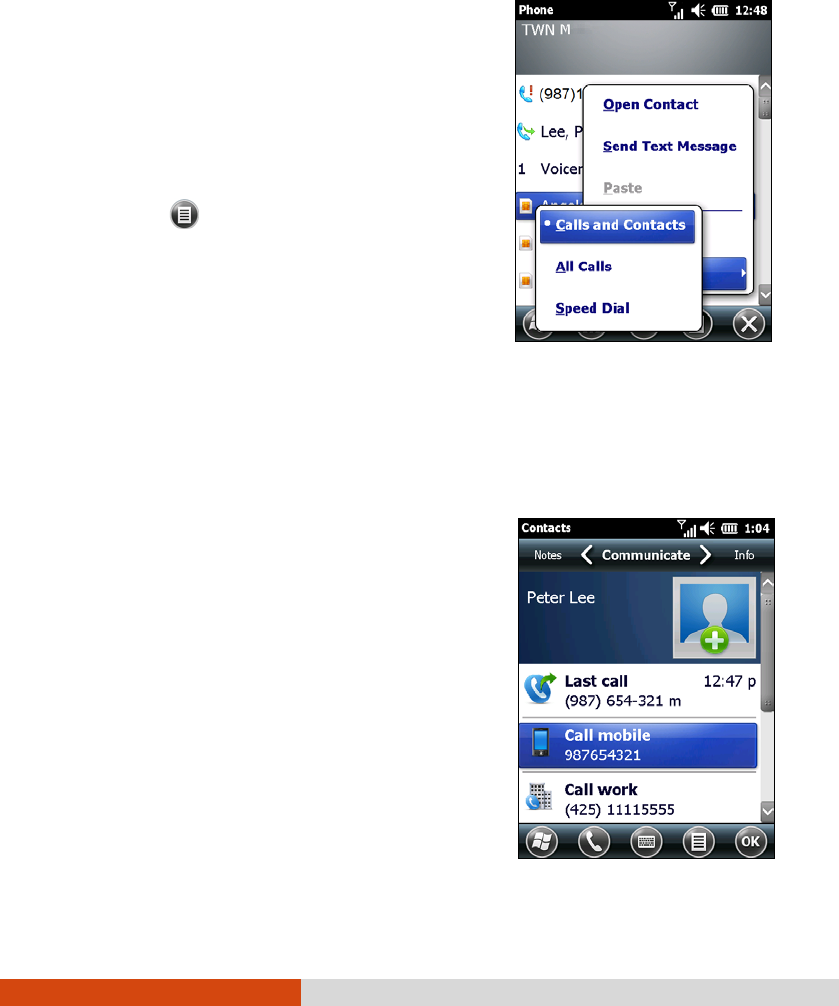
Using the Phone 3-5
Making a Call from the Onscreen List
Whenever you start the Phone program, the
screen lists all recent calls, speed dials, and
contacts.
If the list contains the number you want to
call, you can conveniently select from the list
and press the Send key on your device.
NOTE: To view a different list on the Phone
screen, tap
View and select one of the
options.
Making a Call from Contacts
Microsoft Contacts displays your contact information stored both in your
device’s memory and on your SIM card. (See “Contacts: Tracking Friends and
Colleagues” in Chapter 5 for detailed information on the Contacts program.)
1. Start the Contacts program.
2. Do one of the followings to call a person
in the contact list:
Tap the contact to call. Then tap the
number to call.
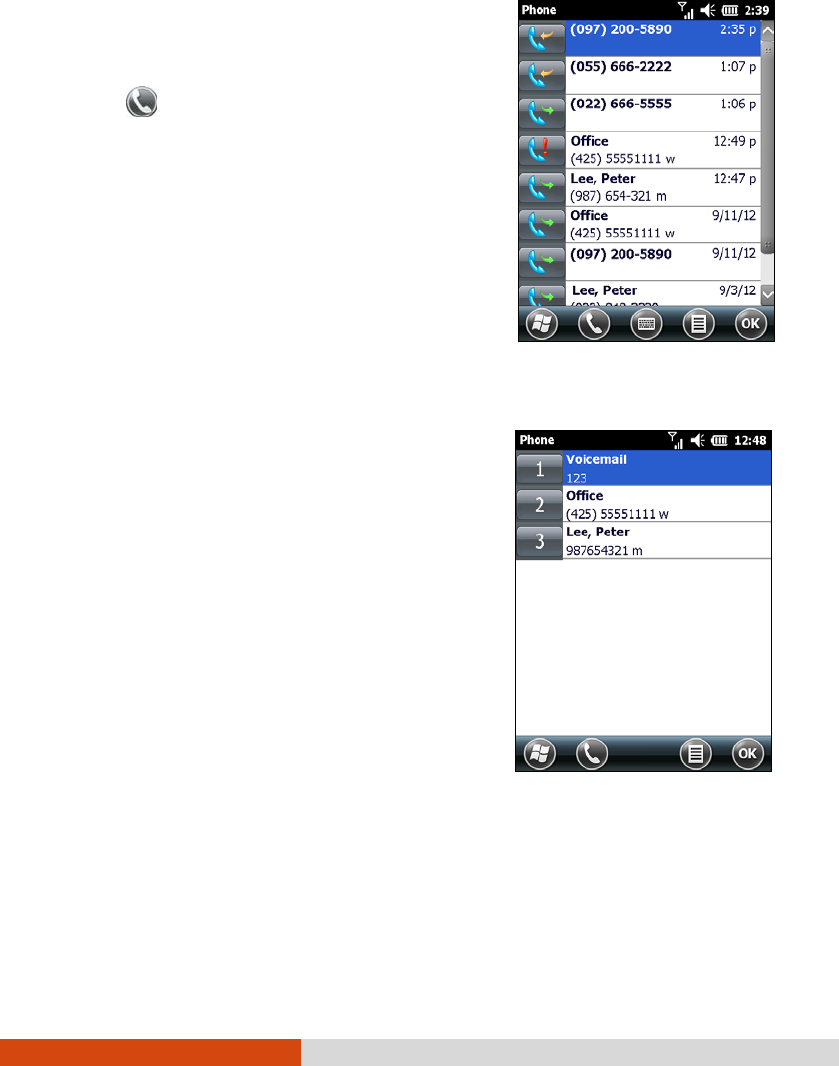
Using the Phone 3-7
2. Do one of the followings to call a person
in the Call History list:
Select the number to call and then tap
or press the Send key on your
device.
Tap and hold on the number to call
and then tap Call in the shortcut menu.
Making a Call from Speed Dial
If you have created speed dial entries, you can
call a person quickly. (See “Using Speed Dial”
in this chapter for information.)
When on the Home screen or in the Phone
program, press and hold the numeric key of
the assigned speed dial number to make the
call.
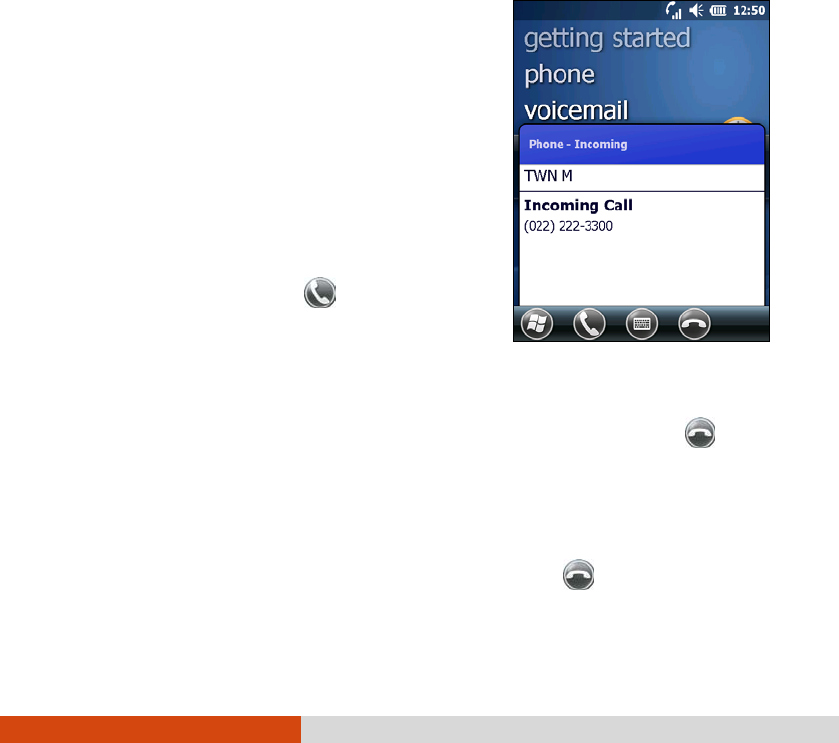
3-8 Using the Phone
Quickly Making a Call to the Last Missed Call
The Home screen displays the last missed call in the phone item. Tap phone
to view the caller information. To call back, tap again.
NOTE: If you do not wish to call back, do not tap the caller information on
the Home screen. To cancel the caller information, tap Notification in the
toolbar to dismiss it.
Responding to a Call
When an incoming call is received, your
device rings or vibrates according to the
options you have set for the phone. The name
and number of the caller are displayed on the
pop-up window. If the name of the caller is
not in your contact list, only the caller’s phone
number is displayed.
Answering a Call
To answer an incoming call, press the Send
key on your device or tap in the toolbar.
Rejecting a Call
To reject an incoming call, press the End key on your device or tap in the
toolbar.
Ending a Call
To end a call, press the End key on your device or tap in the toolbar.
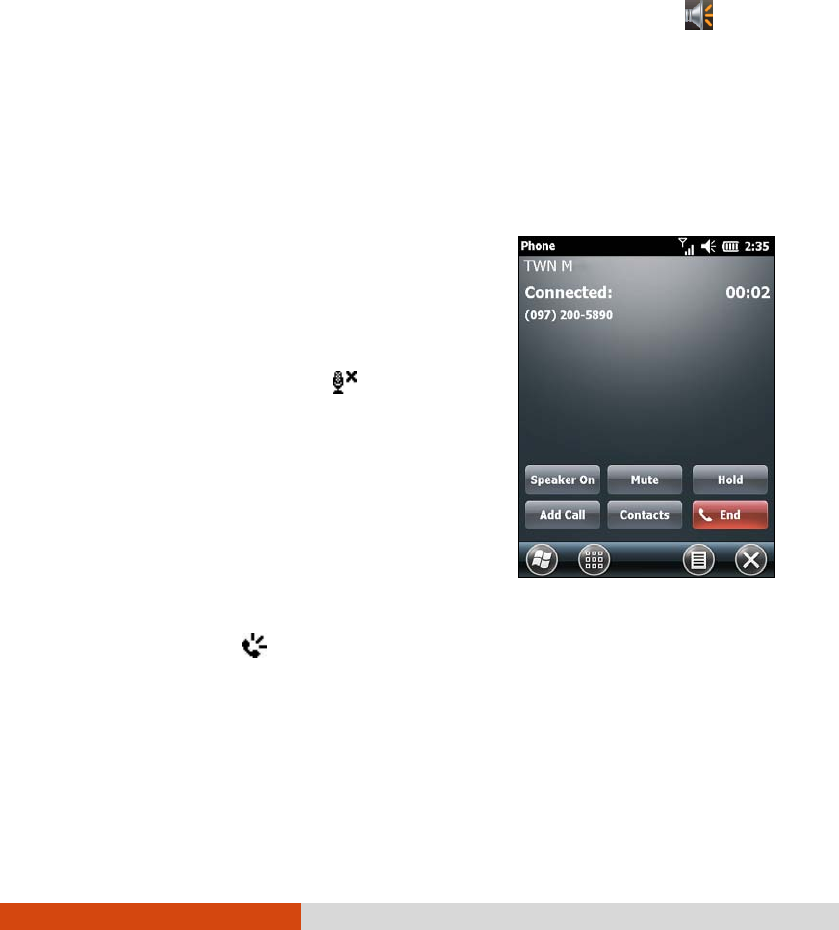
Using the Phone 3-9
Operations during a Call
Adjusting the Phone Volume
To adjust the volume during a call, tap the navigation bar and tap .
Select a volume level before the window disappears.
CAUTION: Never raise the sound volume level too high when using
earphones. An excessive sound volume level could cause damage to your
hearing.
Using the Mute Function
During a call, you can mute your microphone
so that the person with whom you are
speaking cannot hear you, but you can still
hear him or her.
On the Phone keypad, tap Mute to switch on
the mute function. The icon will appear
on the upper-right corner.
To switch off the mute function, tap Unmute.
Using the Speakerphone
You can switch on the speakerphone to use
your device as a hands-free solution.
On the Phone keypad, tap Speaker On to switch on the speakerphone
function. The icon will appear on the navigation bar.
To switch off the speakerphone function, tap Speaker Off.

3-10 Using the Phone
Managing More Than One Call
NOTE: You may need to register for the “call waiting” service with your
mobile phone network service and set your device accordingly. The exact
number of people you can talk at the same time depends on your mobile
phone network service.
During a call, you can make or take a second call while putting the current
call on hold. Then, you can choose to swap between the two callers or set up
a conference call between all three parties.
Holding a Call to Take a Second Call
1. If there is another incoming call when you are talking on your device, a
pop-up window appears to notify you.
2. Answer the second call.
3. When you end the second call, you will be back to the first call.
Placing a Call on Hold to Make a Second Call
1. During a call, tap Hold to place the first call on hold.
2. Make the second call.
3. When you end the second call, you will be back to the first call.
Swapping between Calls
When you have put a call on hold and made or taken another call as
described earlier, you can swap between the two calls by tapping Swap.

Using the Phone 3-11
Setting up a Conference Call
NOTE: You may need to consult your mobile phone network service for the
availability and subscription of the conference call function.
1. When you have put a call on hold and made or taken another call as
described earlier, you can set up conference calling by tapping
Conference.
2. To add additional people to your conference, tap Hold. Dial a second
number and press the Send key to connect. Wait for it to be picked up.
Then tap Menu Conference.
3. If you want to talk to one of the parties privately during the call, tap
Private. Select a number, and tap Private.
To include everyone in the call again, tap Conference.
Taking a Note during a Call
You can take a note during a call.
1. Tap Note.
2. Enter your note and tap OK.
To access a note you created during a call:
1. While in the Phone program, tap Call History.
2. The icon indicates that the phone call entry contains a note. Tap and
hold the name or number for that entry, and tap View Note in the
shortcut menu.
NOTE: You can also tap Notes, and access the note in the Calls folder.
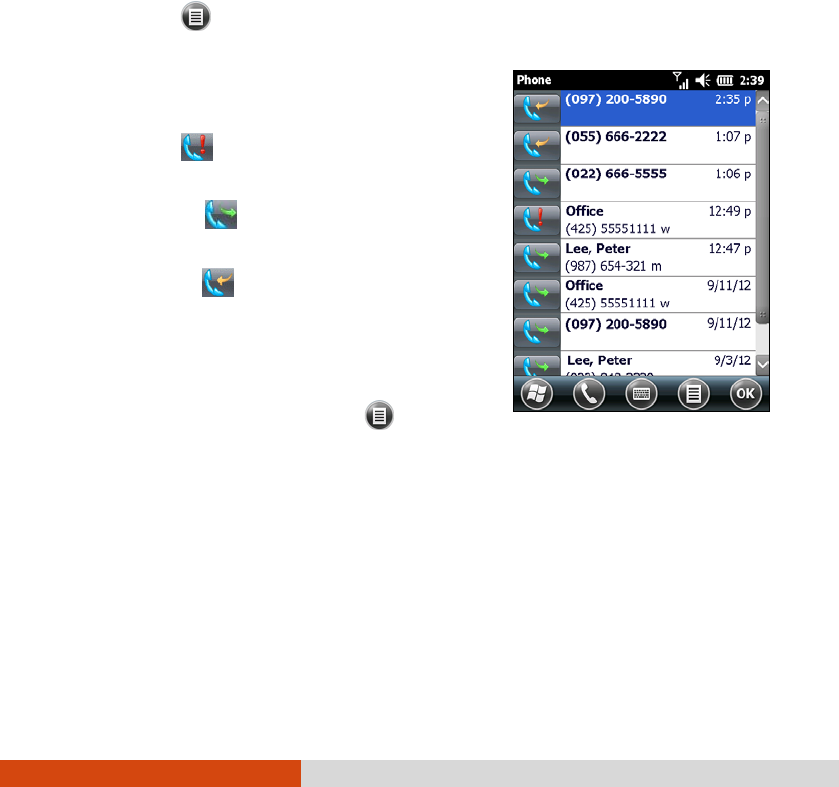
3-12 Using the Phone
Using Call History
Call History provides the time and duration of all incoming, outgoing, and
missed calls, and a summary of total calls. Call History also provides easy
access to any notes taken during a call.
To access Call History while in the Phone program, tap Call History.
Viewing Call History
You can tap Filter to change the Call History view (All Calls by
default).
All Calls: Displays all calls made to and
from your device in a chronological order.
Missed ( ): Displays only calls that
were not answered.
Outgoing ( ): Displays only calls made
from your device.
Incoming ( ): Displays only calls made
to your device.
To see the time, date and duration of a call,
tap the item on the list to view details.
To clear all items on the list, tap Delete
All Calls.
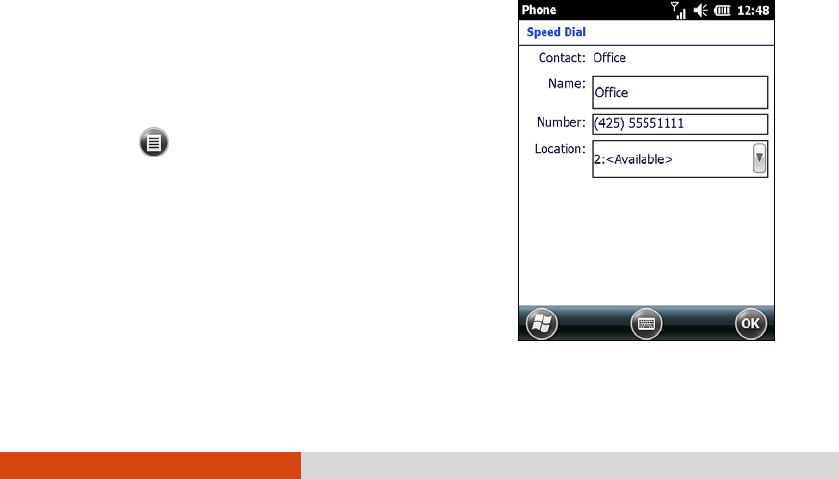
Using the Phone 3-13
Adding an Entry to Contacts Using Call
History
You can add a phone number in the Call History to Outlook Contacts or SIM
Contact.
1. Tap and hold the entry you wish to transfer, and tap Save to Contacts in
the shortcut menu.
2. Tap <New Contact> and select a contact type.
3. Enter the contact’s name, and select the proper number type.
4. Tap Save to save the entry.
Using Speed Dial
You can create Speed Dials for frequently-called phone numbers so you can
dial a number with a single key press.
Creating a Speed Dial Entry
Speed dials can only be created for numbers
stored in Contacts.
1. While in the Phone program, tap Speed
Dial.
2. Tap New.
3. Tap the desired contact.
4. In Name, accept the current name or
change it if you want to.
5. In Number, select the phone number if
there is more than one number for the
contact.

3-14 Using the Phone
6. If Location, accept the current speed dial number or change the number
if you want to.
7. Tap OK to save the setting.
The new Speed Dial entry is now on the Speed Dial list. The letter on the
lower-right corner of the entry indicates the assigned phone number.
For example, “m” indicates the mobile phone number.
NOTE: The first Speed Dial location is reserved for your voice mail.
Editing or Deleting a Speed Dial Entry
1. While in the Phone program, tap Speed Dial.
2. Tap the desired entry and tap Delete.
– or –
Tap and hold on the desired entry, and tap Delete in the shortcut menu.
3. Tap Yes.

Using the Phone 3-15
Additional Phone Operations
Using Text Messages
Text messages are automatically received when your phone is switched on.
The Home screen shows if there are new text messages. You can tap the
section to open the message list.
To send a text message, you can do one of the followings:
First select a phone number from a program such as Phone or Contacts.
Then select Send text message.
First start the Messaging program. Then select the phone number.
See “Reading and Sending Text Messages (Select Models Only)” in Chapter 5
for more information.
Setting up an Internet Connection
You can set up an Internet connection using the mobile network. See “Using
Cellular Connection (Select Models Only)” in Chapter 7 for information.
Checking Your Voice Mail
The first position in your speed dial list defaults as your voice mailbox. When
you insert your SIM card, your device automatically detects your voice
mailbox number and sets it to the first position in your speed dial list.
Making an Emergency Call
You can use your device to dial the international emergency number 112.
This number can normally be used to make an emergency call in any country
with or without a SIM card inserted, as long as you are within a mobile
phone network.

3-16 Using the Phone
Some mobile phone network services may require that a SIM card be
inserted, and in some cases that the PIN be entered.
There may be other emergency numbers available. Your mobile phone
network service may save additional local emergency numbers in the SIM
card.
Dialing an International Call
When you are manually dialing a number, tap and hold on the number key 0
until the + sign appears. The + sign replaces the international prefix of the
country from where you are calling.
Enter the full phone number you want to dial including country code, area
code (without the leading area code zero) and local phone number.
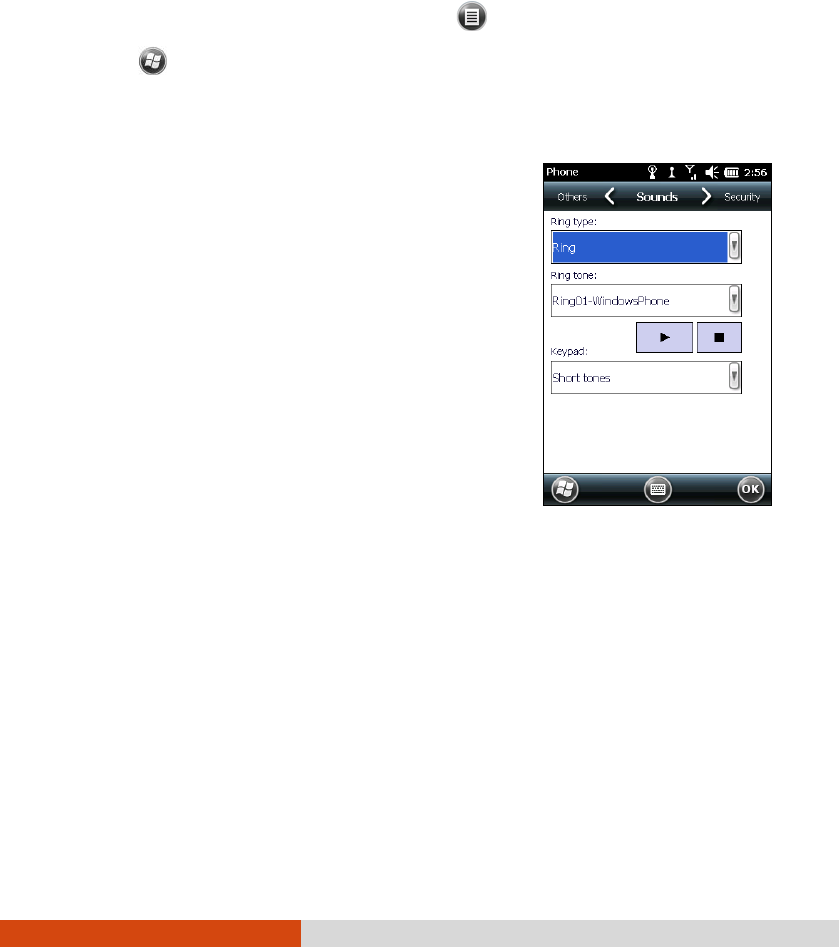
Using the Phone 3-17
Customizing Your Phone
To access the Phone settings, use one of the methods:
Switch to the Phone program and tap Options.
Tap Settings Personal Phone.
Changing Sounds Settings
Scroll left or right to the Sounds page.
You can customize phone settings, such as the
ring type and ringtone to be used for incoming
calls, and the keypad tone to be used when
entering phone numbers.
NOTE:
To use custom files (MP3, WMA, and WAV
formats) as ringtones for incoming calls,
copy the files to the \Application
Data\Sounds folder on your device. Then,
select the sound from the Ring Tone list.
To assign a specific ringtone to a contact for
easy identification, create the contact as an
Outlook contact and select a ringtone. (See
“Assigning a Ringtone and Picture” in
Chapter 5.)
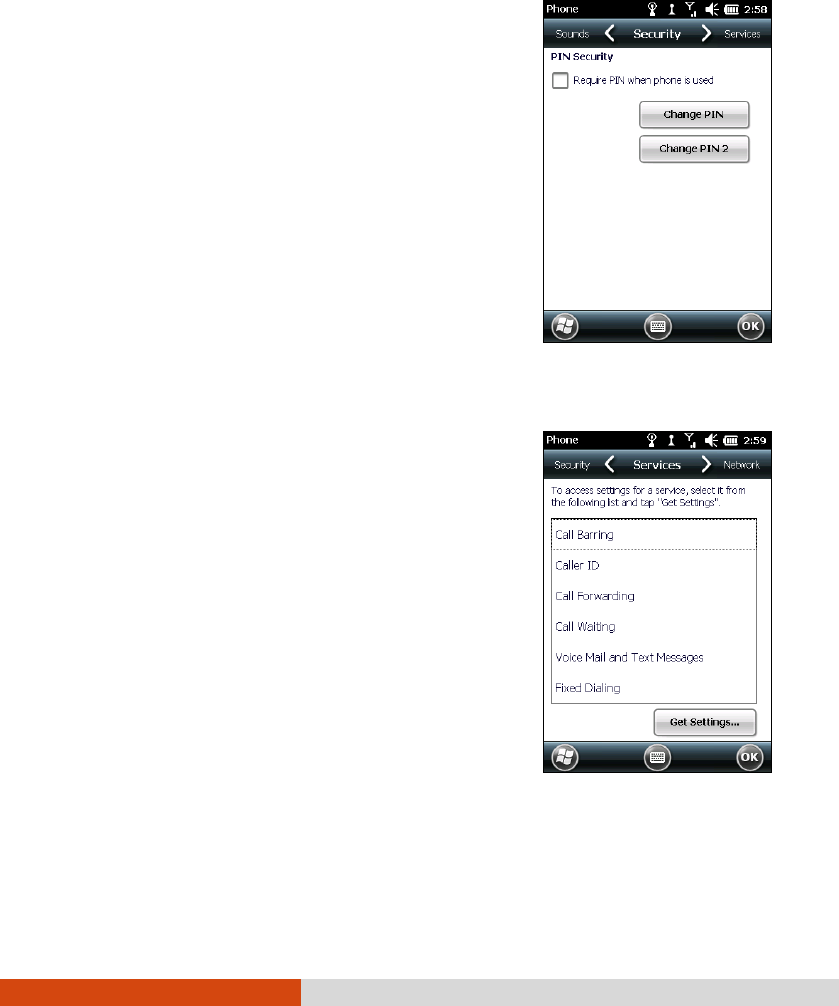
3-18 Using the Phone
Changing Security Settings
Scroll left or right to the Security page.
You can protect your phone from unauthorized
use.
You might be prompted to enter the PIN2 code
for specific functions (such as the pre-paid card’s
charging counters). Consult your mobile phone
network service to check if your SIM card
supports PIN2-related functions and services.
NOTE: Emergency calls can be placed at any time
without requiring a PIN code.
Changing Services Settings
Scroll left or right to the Services page.
You can access and configure settings for the
phone services you subscribed to through your
mobile phone network service. For example, you
may want to block certain types of incoming
and/or outgoing calls, forward incoming calls to
a different phone number based on your
situation, be notified of incoming calls when you
are already in a call, or let others know your
identity when making calls. Services available to
you depend on your mobile phone network
service and the type of your subscription.
To view your services settings, tap a service and
then tap Get Settings.
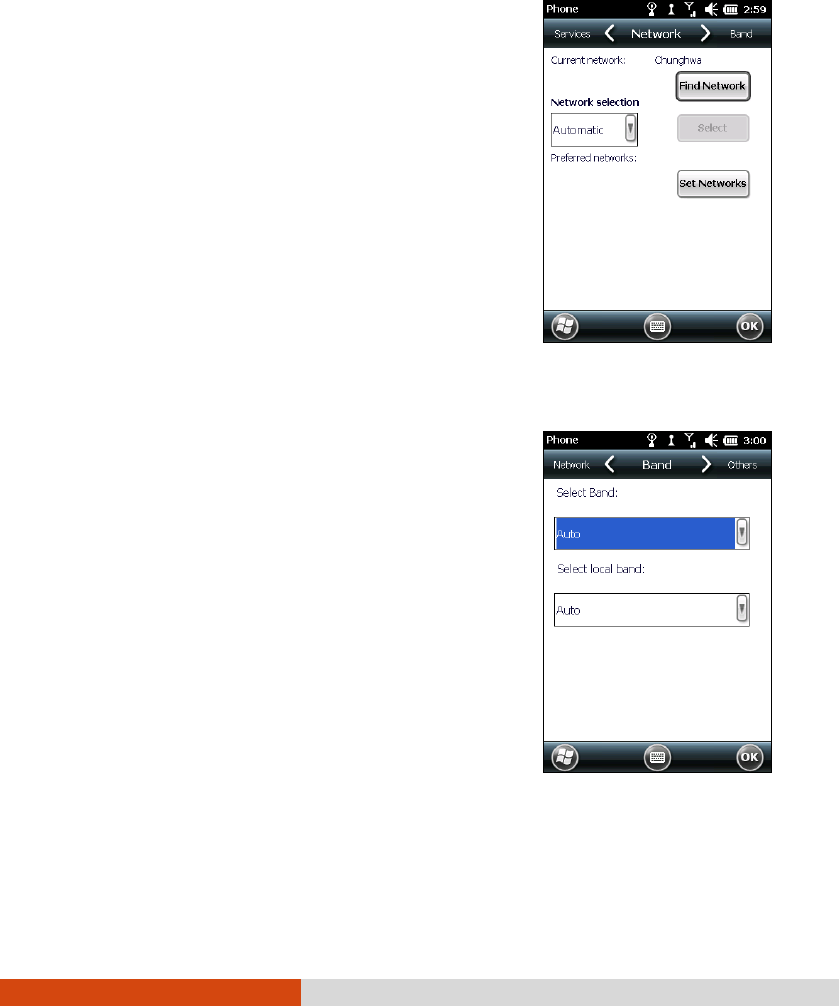
Using the Phone 3-19
Changing Network Settings
Scroll left or right to the Network page.
You can view available wireless networks,
determine the order in which your phone
accesses another network if the current one is
unavailable, and specify whether you want to
change networks manually or automatically. The
current network will remain active until you
change it, lose your signal, or change your SIM
card.
Changing Band Settings
Scroll left or right to the Band page.
The settings will be configured automatically
according to the SIM card inserted. You can
manually change the settings if needed.

Managing Your Device 4-1
Chapter 4
Managing Your
Device
This chapter tells you how to effectively manage power, settings, data and
programs of your device.
Managing Power
A fully charged battery should provide power for up to 6 hours of use. The
operating time of a fully charged battery depends on how you are using the
device. Some functions, such as using multimedia or operating a microSD
card, may consume the battery power considerably.
Low Battery Signals and Actions
CAUTION: When you recharge the battery upon a warning of low power,
you should charge for at least 30 minutes. If you unplug the AC charger
soon, you may not have sufficient battery power for your operation.
You can monitor the battery power by tapping Settings System
Power. The remaining power is displayed on a status bar in the Power
control panel.
When the battery is low, your device will pop up a warning message and a
beep will sound. You should save your data and recharge the battery
immediately upon a warning of low power; otherwise your device will turn

4-2 Managing Your Device
off automatically. You need to connect the device to external AC power for
charging before you can use it again.
Power-Saving Tips
Follow these suggestions to maximize the battery’s operating time,
particularly when you are relying solely on the battery power for extended
time periods.
Suspend frequently.
By default, the screen backlight will automatically dim out and the
device will also suspend when it has been idle for a period of time. You
can shorten the length of the idle time using Settings System
Power Advanced to set up.
Press the power button to suspend your device when it is not in use,
even for a short time.
Turn off functions not needed or adjust settings.
Lower the volume.
Decrease the screen brightness to the lowest comfortable level.
Do not enable sounds or light flashing except for the most necessary
notifications. (Tap Settings Sounds & Notifications to set
up.)
Avoid power-consuming situations such as:
Using a modem or other peripheral
Playing sound or music
Recording
Using or monitoring wireless signals
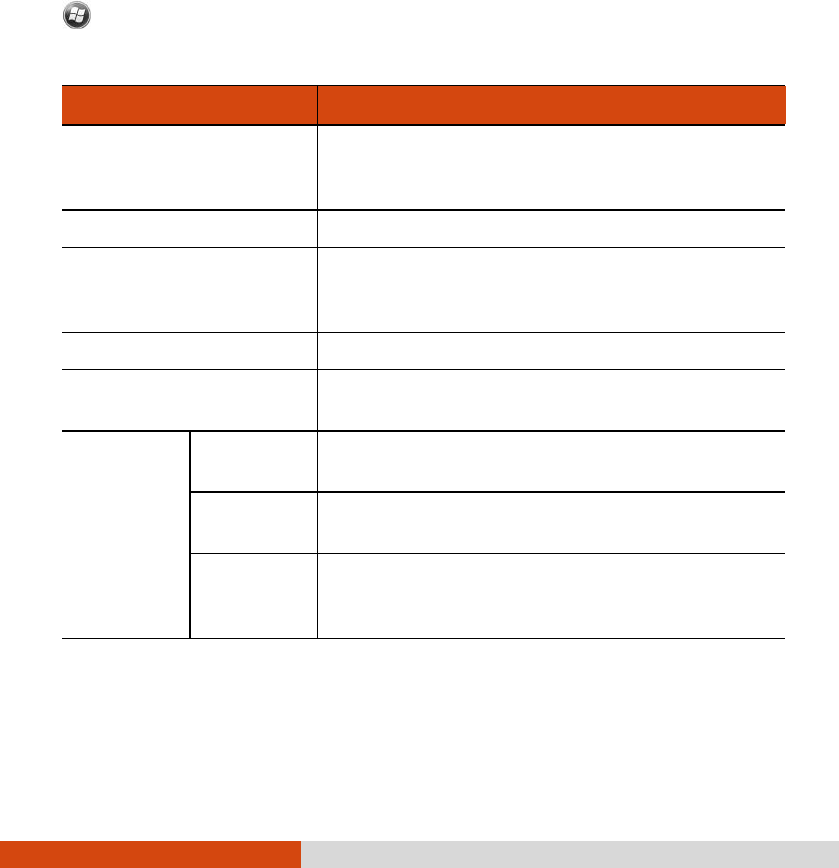
Managing Your Device 4-3
Customizing Your Device
NOTE: Incorrect settings may cause your system to malfunction. Make sure
that you fully understand the function of a certain item before any
adjustment.
You can customize the settings of the device to your own preferences. Tap
Settings.
The items you can customize are described as follows:
Item Description
Bluetooth To set up or change the Bluetooth connection.
(See “Using the Bluetooth Function” in Chapter
7 for detailed information.)
Clock & Alarms To change the time and date and to set alarms.
Home To select the information you want displayed on
the Home screen and to select a desired theme
for the background.
Lock To set a password for security.
Sounds & Notifications To set the conditions and types of the sounds,
system volume and ways of notifications.
Connections
Beam To receive information and files via Bluetooth
technology.
Connections
To set up or change connection information.
(See Chapter 7 for detailed information.)
Domain
Enroll
To connect your device with company resources.
You will need the enrollment password
provided by your system administrator.
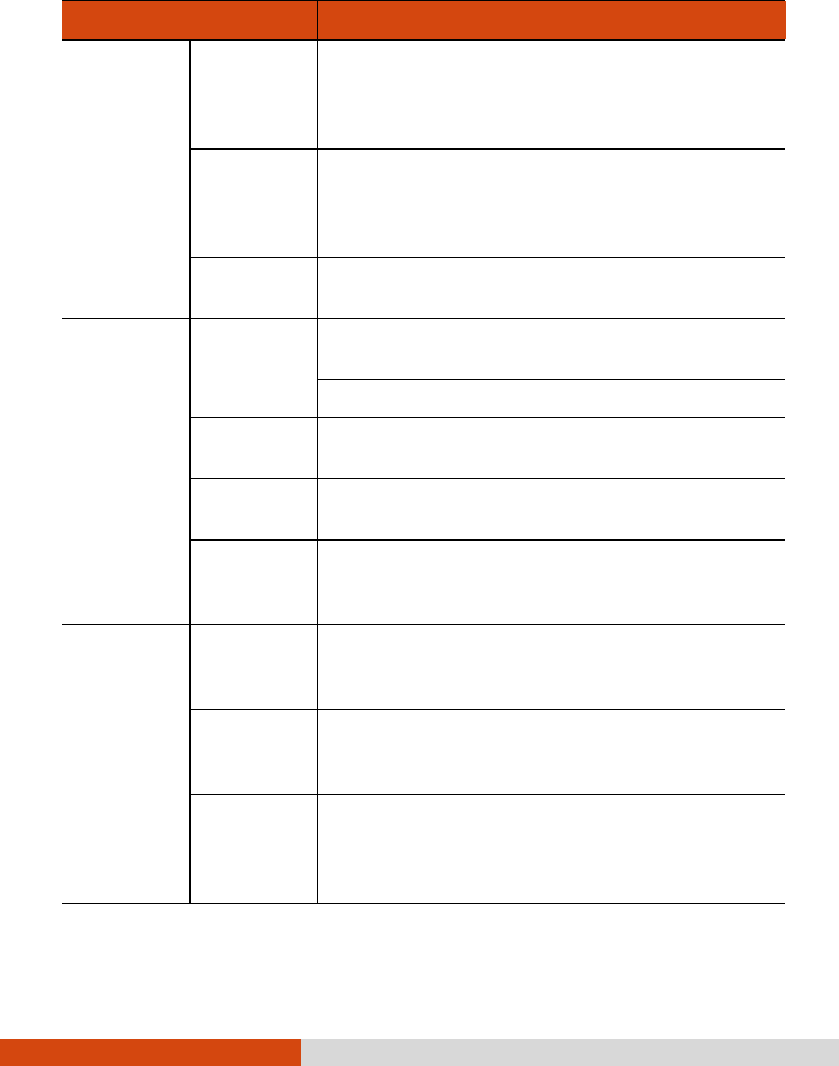
4-4 Managing Your Device
Item Description
Connections
USB to PC To enable advanced network functionality for
USB connection. In some specific cases, there can
be connection problems if this item is enabled.
Disable this item to resolve the problem.
Wi-Fi To search for wireless networks and configure
the wireless network module. (See “Using
Wireless Network” in Chapter 7 for detailed
information.)
Wireless
Manager
To change the Wi-Fi, Bluetooth, and Phone
radio status.
Personal Buttons To assign programs to hardware buttons (F1 to
F7 and Scan).
To set the repeat rate of the up/down control.
Input To set up items related to the input methods
and voice recording format.
Owner
Information
To enter your personal information.
Phone To customize the phone function. (See
“Customizing Your Phone” in Chapter 3 for
detailed information.)
System About To show the hardware information of your
device and to define the name that your device
uses for identifying itself to other computers.
Backlight To adjust the brightness level of the display and
to set the automatic turnoff for power saving
purposes.
Certificates To establish your identity or the identity of
other computers. This helps prevent
unauthorized users from accessing your device
and information.
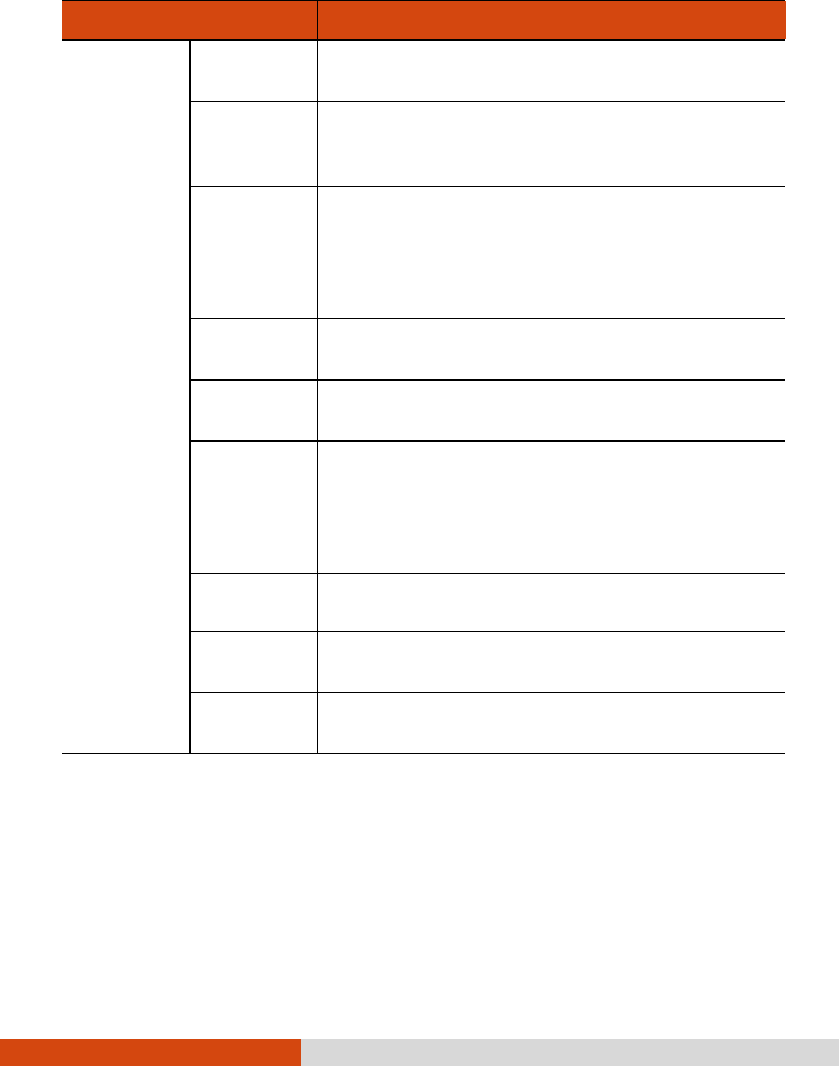
Managing Your Device 4-5
Item Description
System Customer
Feedback
To set if you want to send your feedback on
using the Windows Mobile software.
Encryption To set if you want to encrypt files placed on
storage cards. The encrypted files will be
readable only on this device.
Error
Reporting
To enable or disable error reporting. Error
Reporting sends information needed by
technical support groups to diagnose a program
error for a device running Windows Mobile
software.
External
GPS
To configure the GPS hardware settings and
manage GPS.
Managed
Programs
To manage the programs you installed.
Memory To display the allocation between storage and
program memory, to view the memory on the
storage card (if installed) and to manually stop a
program if it becomes unstable or program
memory is low.
Power To show the remaining battery power and to set
the time for the device to turn off automatically.
Regional
Settings
To specify the region of your location and the
formats of the number, currency, time and date.
Remove
Programs
To remove programs you added to the memory
of your device.
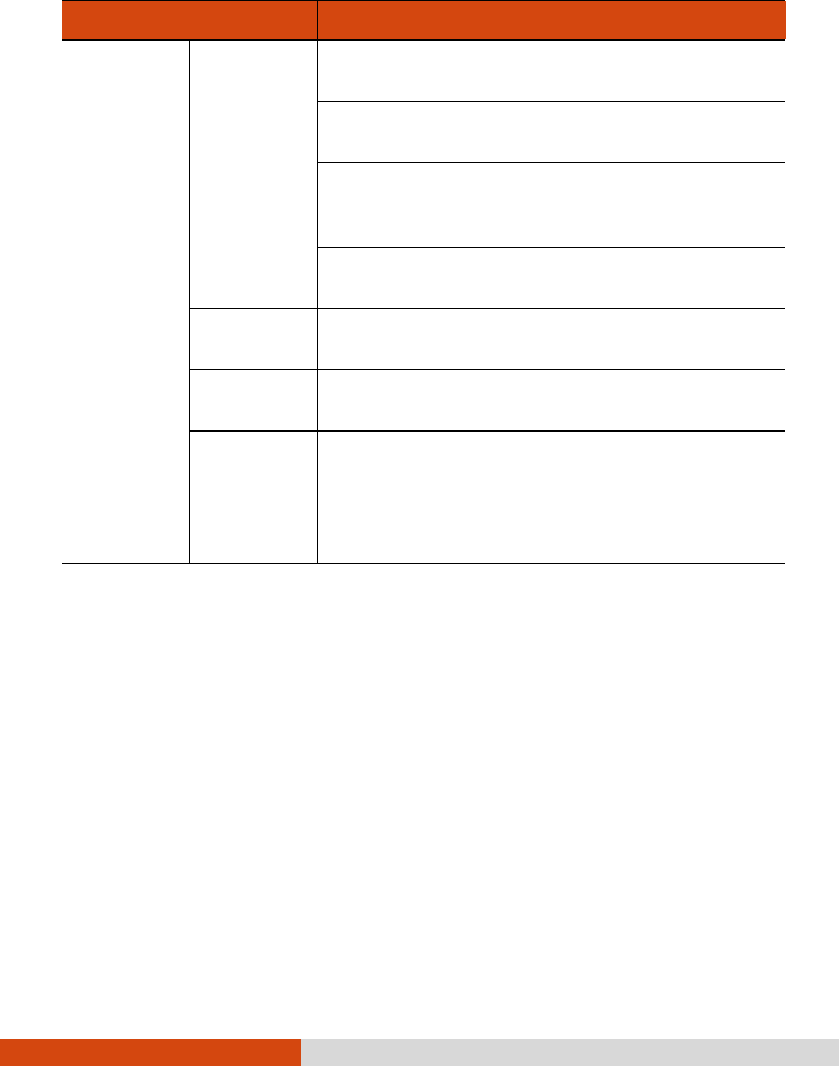
4-6 Managing Your Device
Item Description
System Screen To set the orientation of the screen to portrait
or landscape.
To adjust the touchscreen for accurate screen
taps.
To enable the ClearType feature for easier
reading of text in programs that support
ClearType.
To adjust the text size to see more content or
increase the readability in many programs.
Serial Port
Switch
To specify the use of Expansion Port or RS232
serial port.
System
Information
To display the system information.
Task
Manager
To display the information about the system
performances and the detailed information of
the running programs on your device. You can
also end or manage the running programs in
Task Manager.

Managing Your Device 4-7
Working with Programs and
Folders
Adding and Removing Programs
You can add programs compatible with Windows Mobile 6.5 to your device
by downloading or copying.
To manage programs you have installed, tap Settings System
Managed Programs.
To remove programs you have installed, tap Settings System
Remove Programs.
Searching and Organizing Information
The Search feature on your device helps you quickly locate information.
To search a file, tap Search Phone. Enter the text you want to find,
select a data type and then tap Search to start the search.
You can also use the File Explorer to find files on your device and to
organize these files into folders. Tap File Explorer.
NOTE: You can move files in File Explorer by tapping and holding the item
you want to move, tapping Cut or Copy on the shortcut menu, browsing to
the new location and then tapping Paste.

Microsoft Pocket Outlook 5-1
Chapter 5
Microsoft Pocket
Outlook
Microsoft Pocket Outlook includes Calendar, Contacts, Tasks, Notes, and
Messaging. You can use these programs individually or together. For
example, e-mail addresses stored in Contacts can be used to address e-mail
messages in Messaging.
Calendar: Scheduling
Appointments and Meetings
Use Calendar to schedule appointments, including meetings and other events.
You can check your appointments in one of several views (Agenda, Day, Week,
Month and Year), and set Calendar to remind you of appointments with a
sound or other methods. Appointments for the day can be displayed on the
Home screen.
Tap Calendar.
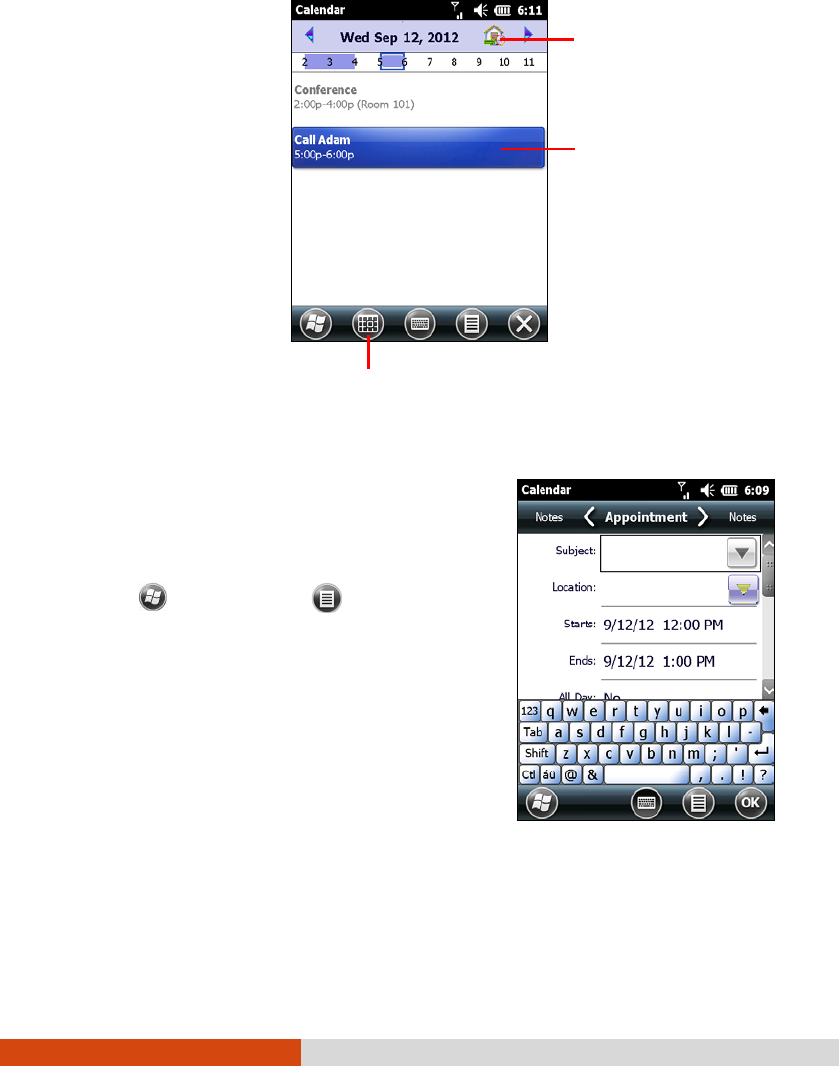
5-2 Microsoft Pocket Outlook
Creating an Appointment
1.
Tap calendar and New Appointment on
the Home screen.
– or –
Tap Calendar New
Appointment.
2. Enter appointment information.
3. Tap OK to save and return to Calendar.
Tap to go to today.
T
ap to display or edit the
appointment details.
Tap to switch to another view.
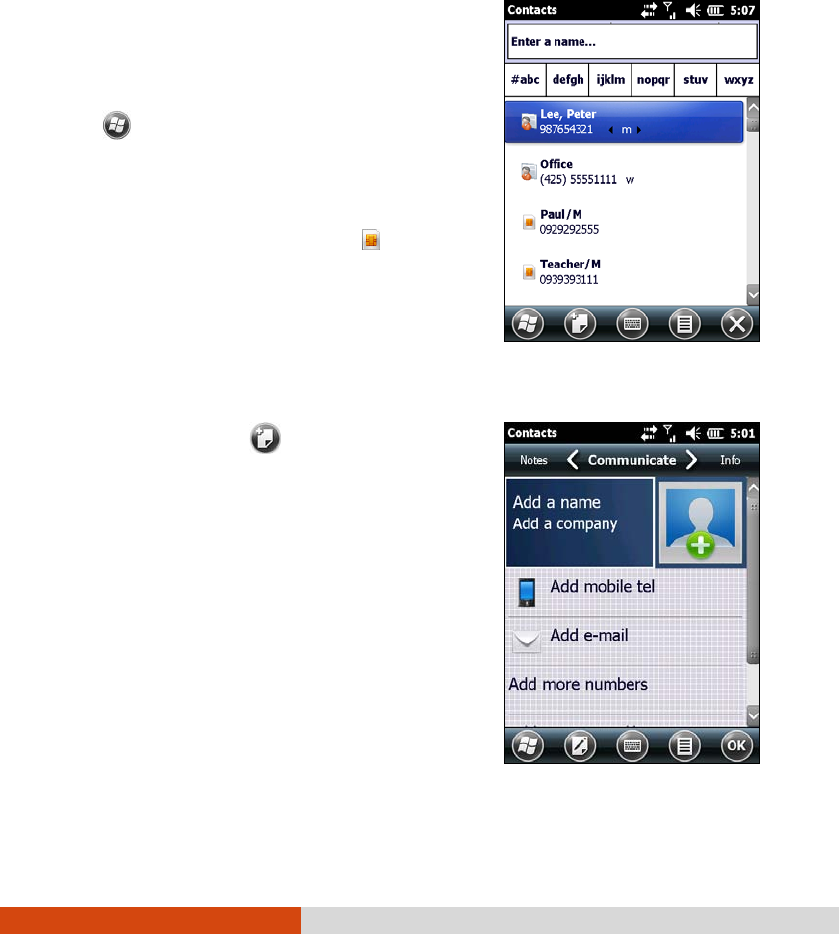
5-4 Microsoft Pocket Outlook
Contacts: Tracking Friends and
Colleagues
Contacts maintains a list of your friends and
colleagues so that you can easily find the
information you are looking for, whether
you are at home or on the road.
Tap Contacts. The Contacts list
appears.
For models with the phone function,
contacts stored in the SIM card also appear
in the list (indicated by the icon ).
Creating a Contact
1. In Contacts, tap .
2. Select a contact type.
3. Tap the first field for entering the name.
Use the Input panel to enter the
information and tap OK to complete.
4. Tap another field to enter other
information such as phone number and
e-mail address.
NOTE: You can only set the contact’s name
and phone number for a SIM contact.
5. Tap OK to save and return to the contact
list.
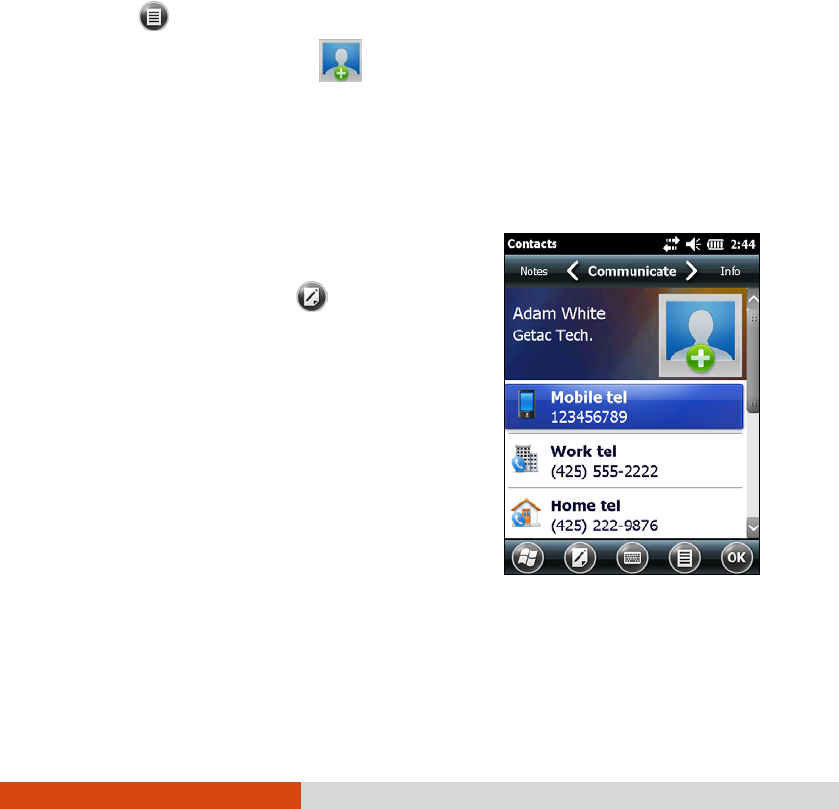
Microsoft Pocket Outlook 5-5
Assigning a Ringtone and Picture
NOTE: To use custom files (MP3, WMA, and WAV formats) as ringtones for
incoming calls, copy the files to the \Application Data\Sounds folder on your
device.
You can assign a specific ringtone and picture to an Outlook contact for easy
identification when they call.
1. Select the contact you want to edit.
2. Tap Edit.
3. To assign a picture, tap and select an image.
4. To assign a ringtone to the contact, tap Info at the upper right of the
screen. Tap Set ringtone to select a ringtone from the list.
Using the Contacts Summary Screen
When you tap a contact on the contact list, a
summary screen is displayed. To change the
contact information, tap .
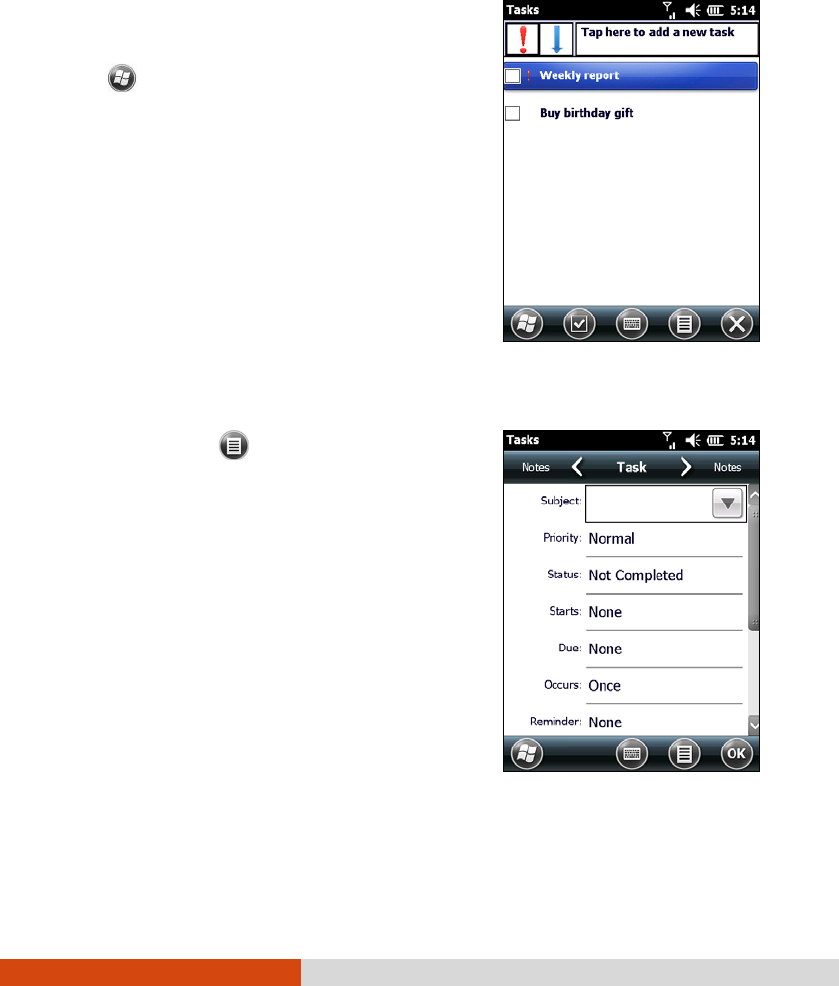
5-6 Microsoft Pocket Outlook
Tasks: Keeping a To Do List
Use Tasks to keep track of what you have to
do.
Tap Tasks.
Creating a Task
1. In Tasks, tap New Task.
2. Using the Input panel, enter a
description.
3. You can enter a start date and due date
or enter other information by first
tapping the field.
4. Tap OK to save and return to the task
list.
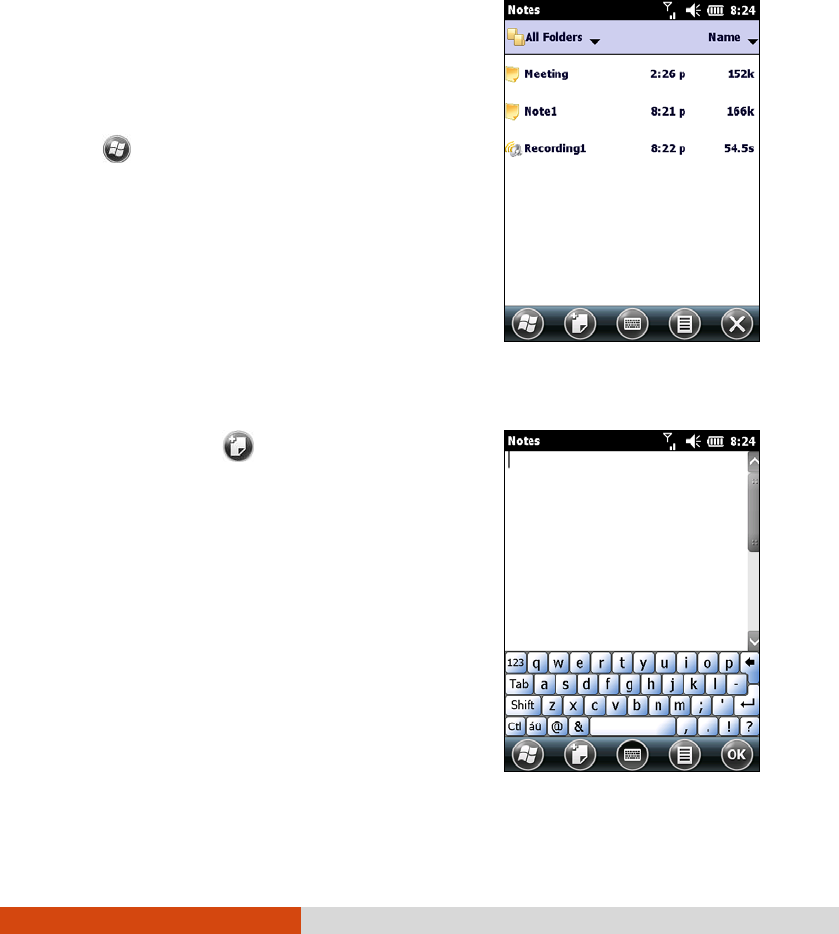
5-8 Microsoft Pocket Outlook
Notes: Capturing Thoughts and
Ideas
Quickly capture thoughts, reminders, ideas,
drawings and phone numbers with Notes.
You can create a written note or an audio
recording. You can also include a recording
in a note.
Tap Notes.
Creating a Note
1. In Notes, tap .
2. Create your note by writing, drawing,
typing, or recording.
3. Tap OK to save and return to the note
list.
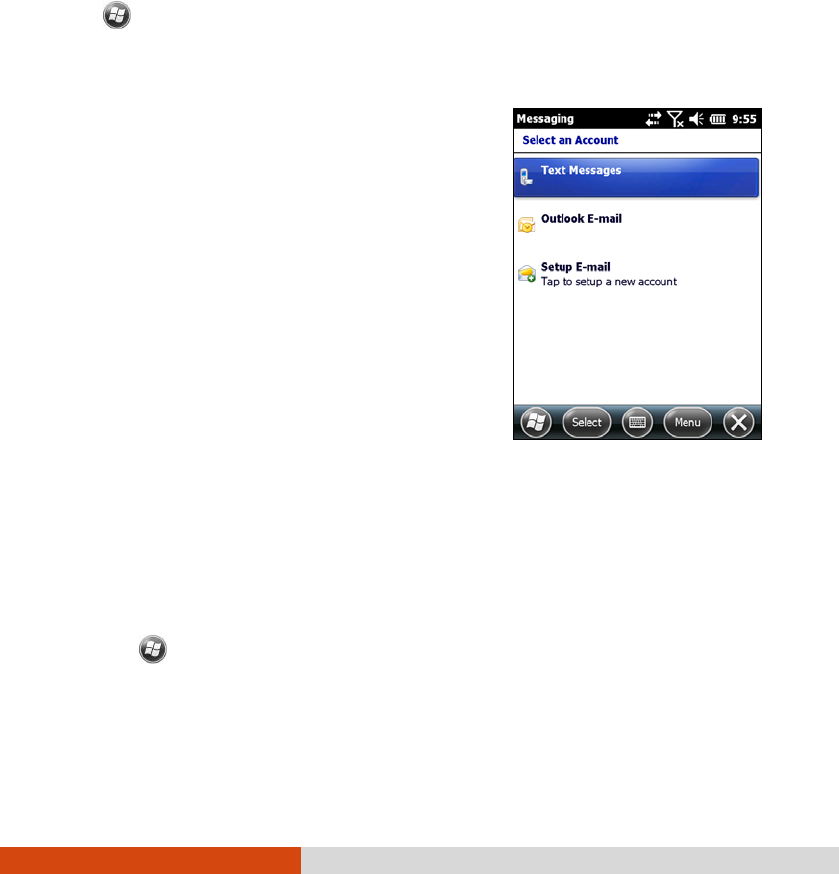
Microsoft Pocket Outlook 5-9
E-mail and Text Messaging:
Sending and Receiving Messages
About Accounts
Tap E-mail. The account selection screen appears.
You can use multiple services to send and receive messages. For different
ways of accessing messages, there are different types of account:
Text Messages (select models only): This
item appears if your model comes with
the phone function.
Outlook E-mail: This item appears if you
have synchronized directly with a
Microsoft Exchange Server account or
with Microsoft Outlook on your
computer.
An Internet account: You have to
manually set up such an account. This
type of account depends on a service
provider or a mobile operator (select
models only) to provide the messaging
services that enable you to send and
receive e-mail over the Internet.
Setting up an Internet E-mail Account
You can set up only one Outlook account on your device. However, you can
set up multiple Internet e-mail accounts.
1. Tap E-mail.
2. Tap Setup E-mail on the account selection screen.
3. Follow the on-screen instructions to complete the setup.
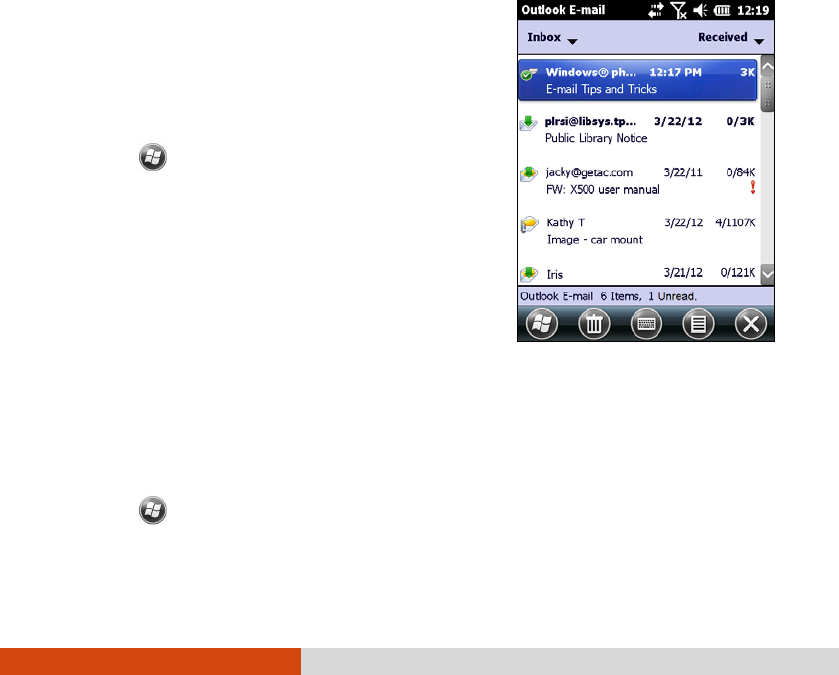
5-10 Microsoft Pocket Outlook
During setup, you can enable Auto Setup to search for and enter the
settings of the e-mail account with which you want your device to
synchronize. If Auto Setup does not find the settings, you may have to
ask your ISP, mobile operator, or system administrator for the correct
settings, and then enter them yourself.
Reading and Sending E-mails
Reading E-mails
When you connect to your email server or synchronize with your desktop
computer or server, by default, you will receive messages from the last three
days only and the first 2 KB of each new message, and not to sync file
attachments. The original messages remain on the server or your desktop
computer.
To read E-mail messages:
1. Tap the e-mail account on the Home
screen.
– or –
Tap E-mail and select the account.
2. Messages you receive are displayed in the
message list. Tap an item to open it.
Sending E-mails
1. Tap the e-mail account on the Home screen.
– or –
Tap E-mail and select the account.
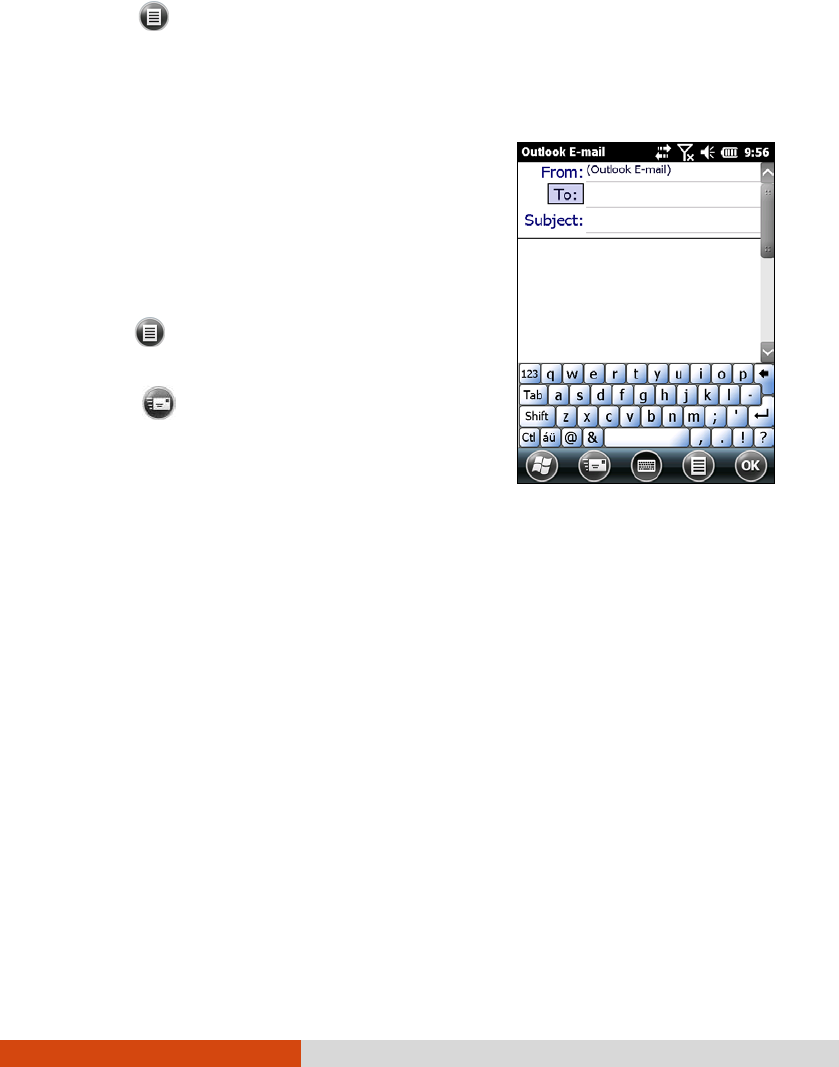
Microsoft Pocket Outlook 5-11
2. Tap New.
NOTE: You can also send an e-mail message by selecting a contact with an
e-mail address from another program such as Contacts or Phone. Then select
Send e-mail from the shortcut menu or soft key.
3.
Enter the e-mail address of one or more
recipients, separating them with a
semicolon. To access addresses from
Contacts, tap To.
4. Enter your message and subject.
5. If you want to attach a file to the message,
tap Insert and select the desired
file.
6. Tap when you have finished the
message. If you are working offline, the
message is moved to the Outbox folder
and is sent the next time you connect.
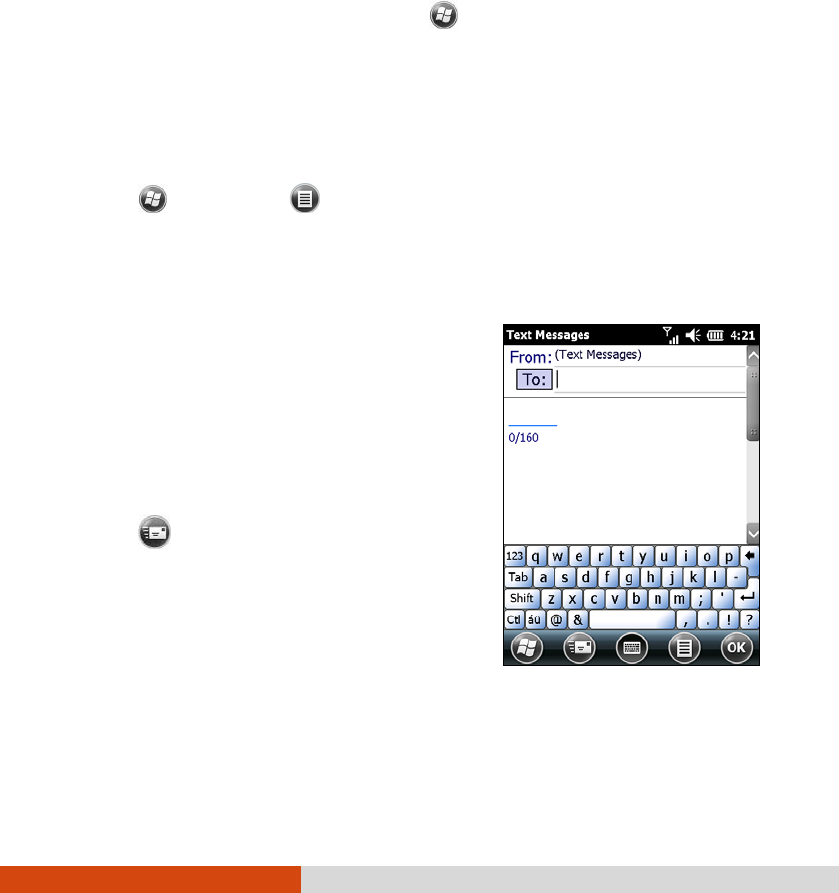
5-12 Microsoft Pocket Outlook
Reading and Sending Text Messages (Select
Models Only)
Reading Text Messages
The Home screen shows if there are new text messages. You can tap the item
to view the message. You can also tap Text to open the message list.
Sending a Text Messages
1. Tap text on the Home screen and tap Compose in the toolbar.
– or –
Tap Text. Tap New.
NOTE: You can also send a text message by selecting a phone number from
another program such as Contacts or Phone. Then select Send Text
Message from the shortcut menu or soft key.
2.
Enter the phone number of one or more
recipients, separating them with a
semicolon.
To select phone numbers from Contacts,
tap To.
3. Enter your message.
4. Tap to send the message.

More Programs 6-1
Chapter 6
More Programs
In addition to Microsoft Pocket Outlook, there are other programs built into
your device. This chapter tells you how to use these programs.
ActiveSync
ActiveSync on your device works with ActiveSync on a Windows XP
computer and with Windows Mobile Device Center on a Windows
Vista/Windows 7 computer.
When you have established the connection between your device and your
computer, you can synchronize the information between the two with
ActiveSync. Synchronization compares the data on the two sides and
updates both computers with the most recent information. For example, you
can:
Keep your Pocket Outlook Contacts, Calendar and Tasks databases
up-to-date by synchronizing your device with Microsoft Outlook data on
your computer.
Synchronize e-mail messages in your device Outlook Inbox with e-mail
messages in Microsoft Outlook on your computer.
Synchronize Microsoft Word, Excel and PowerPoint files between your
device and computer. Your files are automatically converted to the
correct format.
You can select which information types are synchronized and control how
much data is synchronized. (See the ActiveSync or Windows Mobile Device
Center help on your computer.)

6-2 More Programs
With ActiveSync, you can also:
Copy (rather than synchronize) files between your device and computer.
Add and remove programs on your device.
Pass through your computer to a network or the Internet.
Synchronizing Data
Once you have created a synchronization relationship and completed the
first synchronization, you can initiate synchronization from your device.
1. Connect your device to your computer.
2. On your device, tap ActiveSync.
3. Tap Sync to begin synchronization.
NOTE: In addition to the USB cable, you can also synchronize by using
Bluetooth. (See the ActiveSync or Windows Mobile Device Center help on
your computer.)
Synchronizing Directly with Exchange Server
You can increase your productivity when you are away from the office by
setting up an account to access e-mail, voice mail, calendar, and contact
information from a Microsoft Exchange Server.
Exchange Server, the Microsoft messaging and collaboration server, lets you
send and receive your work e-mail, calendar updates, voice mail, and contact
information while traveling.
To set up the account, you must obtain the name of the Exchange Server and
the server domain from the wireless service provider or system
administrator. You must also know your Exchange user name and password.
1. Make sure your device is not connected to your computer.
2. On your device, tap ActiveSync.

More Programs 6-3
3. Tap Add Server Source.
4. Follow the on-screen instructions to complete the setup.
5. Connect your device to the Internet for synchronization with Exchange
Server.
NOTE:
If a message pops up asking you to accept security policies for
synchronization with Exchange Server, tap OK to proceed.
You may be prompted to set the password for device lock. You can set a
longer period of time (maximum of 24 hours) before your device
prompts you to enter the password again.
To disable the Direct Push feature, tap ActiveSync. Tap
Options, uncheck the E-mail item and then tap OK to save the changes.

6-4 More Programs
Office Mobile 2010
Microsoft Office Mobile 2010 works with Microsoft Office on your computer
to give you easy access to copies of your documents.
Tap Office Mobile 2010 and select the program to use.
Excel Mobile 2010
OneNote Mobile 2010
PowerPoint Mobile 2010
SharePoint WorkSpace Mobile 2010
Word Mobile 2010
Creating a Document/Workbook/Note
NOTE: You cannot create or edit PowerPoint presentations and on your
device.
1. Tap Office Mobile 2010 and select the program to use.
2. Enter the information.
3. When finished, tap OK and the document/workbook/note is
automatically saved and named according to the first characters of text
entered in the document.
Opening an Office Mobile File
Whenever you switch to an Office Mobile program, you will see the file list.
Tap the desired file to open it. You can open only one document at a time;
when you open a second document, the first will be saved and closed
automatically.
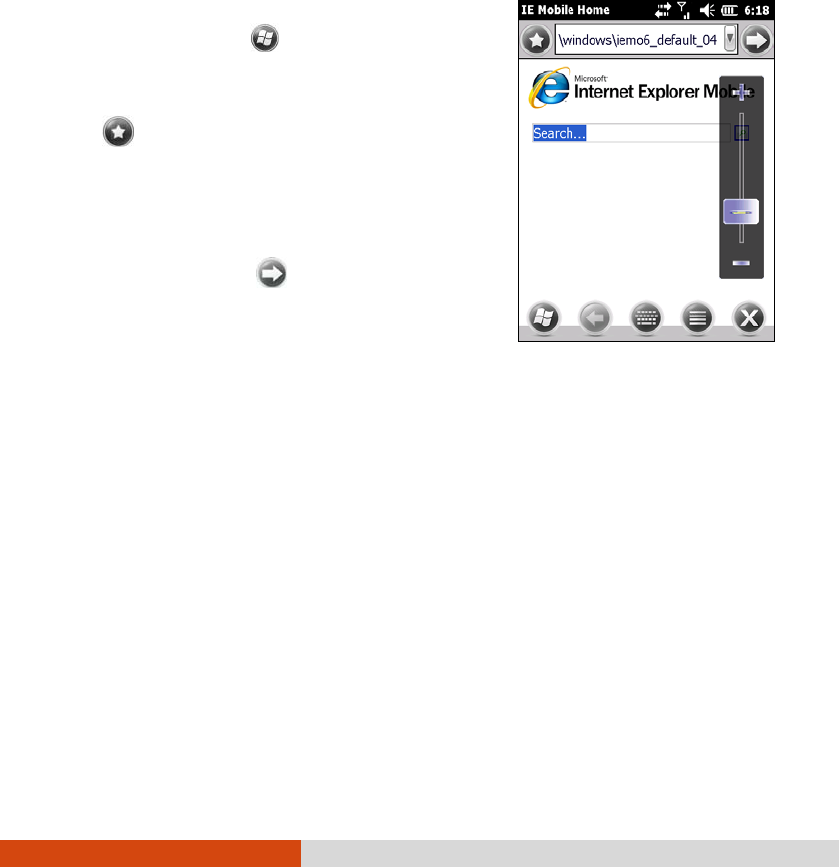
More Programs 6-5
Internet Explorer
NOTE: When surfing the Internet, your device uses the default Internet
connection in Settings Connections Connections My ISP settings. If
you want to surf the Internet through Wi-Fi, connect to the wireless
network before starting Internet Explorer. (See Chapter 7 for information.)
Tap favorites Internet Explorer on the
Home screen or tap Internet Explorer
to switch to the program. The IE Mobile
Home page appears.
Tap to display the Favorites list. Tap the
page that you want to view.
To visit web pages not included in Favorites,
in the address bar that appears at the top of
the screen, enter the web address you want
to visit and then tap . Or, tap the arrow to
choose from previously entered addresses.
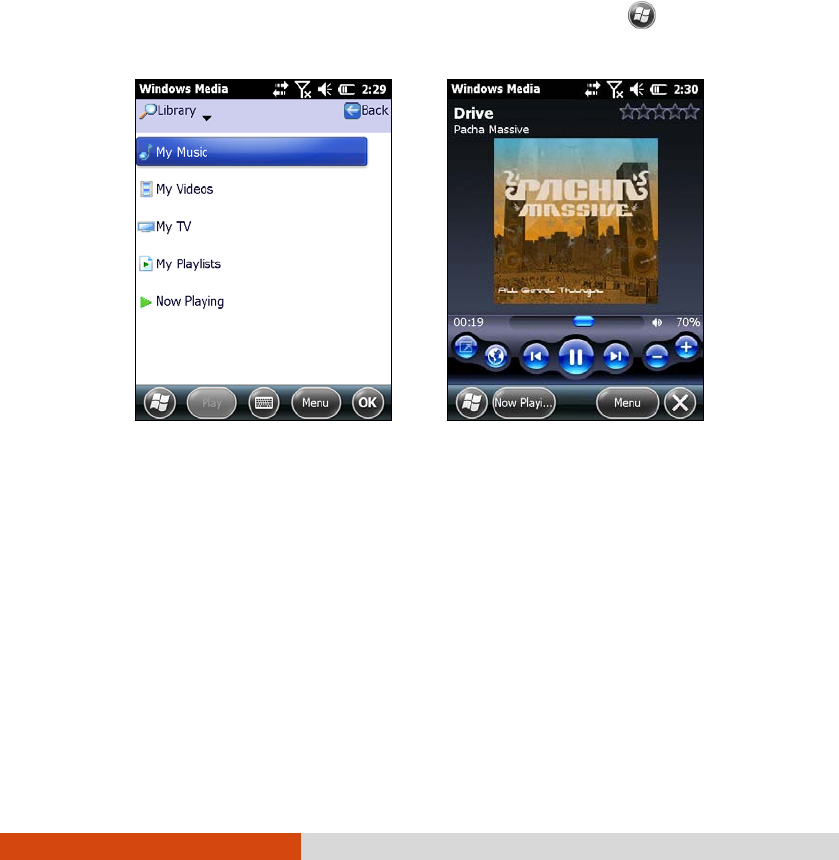
6-6 More Programs
Windows Media
Use Microsoft Windows Media Player Mobile to play digital audio and video
files that are stored on your device or on a network, such as on a web site.
You can play files in either Windows Media or MP3 format (including files
with the extensions .asf, .wma, .wmv and .mp3).
Tap music on the Home screen to directly play music. Or tap Windows
Media to switch to the program.
Library Screen Playback Screen
Use Microsoft Windows Media Player on your computer to synchronize (if
using Windows Media Player 10) or copy (if using Windows Media Player 9)
digital audio and video files from your computer to your device.
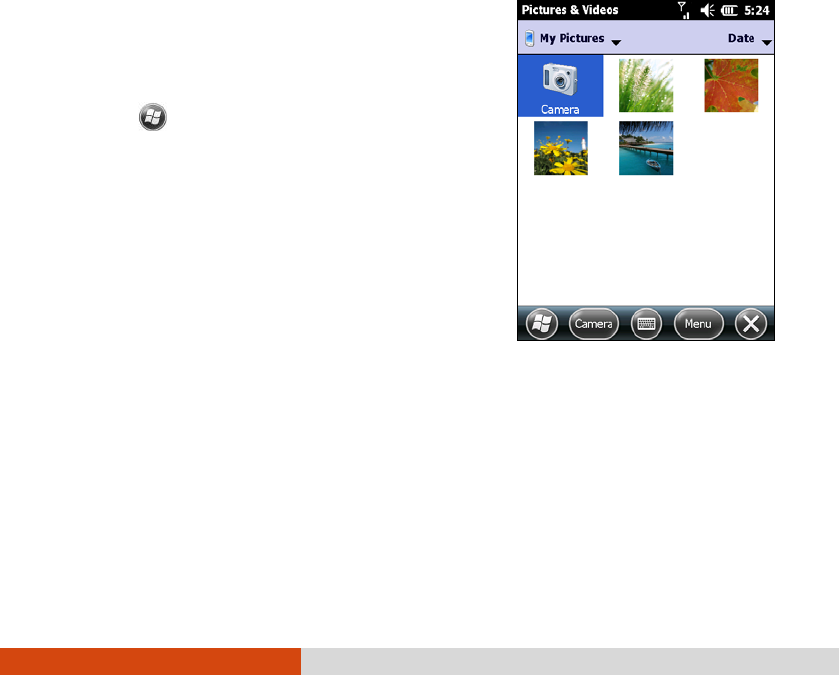
More Programs 6-7
Pictures & Videos
With Pictures & Videos, you can:
View pictures and video clips.
Send pictures and videos to others.
Set a picture as the background on the Home screen.
Play slide show.
Edit your pictures.
Viewing Pictures and Videos
1.
Tap pictures on the Home screen and All
Photos soft button.
– or –
Tap Pictures & Videos.
NOTE: You can quickly view pictures by
tapping pictures on the Home screen. Brush
left or right to scroll through the pictures. Tap
the current highlight to view in full screen.
2. By default, the program displays
thumbnails of the pictures and videos in
the My Pictures folder, within the My
Documents folder on your device.
You can tap one of them to view in full
screen.

6-8 More Programs
Camera
The Camera program allows you to take pictures and record video clips.
NOTE: Your device has two Camera programs. By default, the key on
your device starts the Camera (in Picture & Videos) program. You can change
the key to start the Getac Camera in Settings.
Taking Pictures
1. To start the program, press the key on your device or tap
Programs Pictures & Videos Camera.
The Camera screen appears. Below the display area are indicators of the
current status.
2. For camera controls such as brightness and zooming, tap Menu.
Display area
Current status
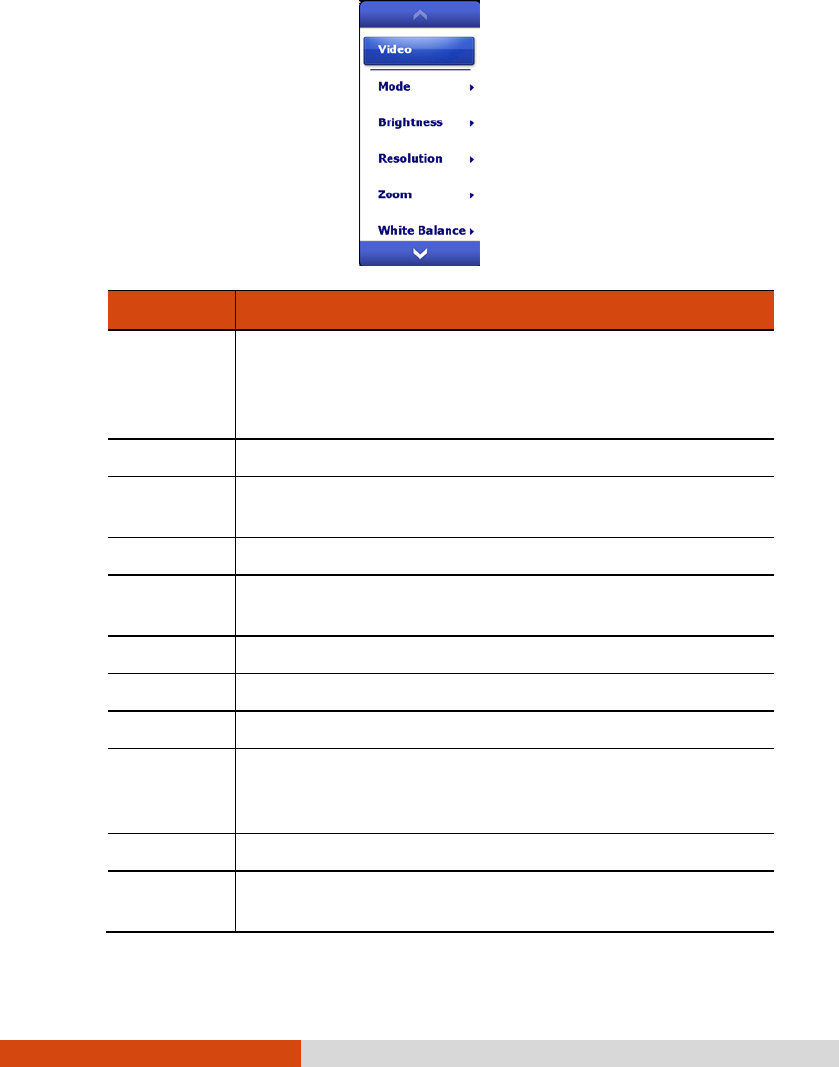
More Programs 6-9
Menu Items
Descriptions
Mode Three choices:
1. Normal
2. Burst – Continuous shooting of 5 pictures
3. Timer – 5 second countdown before shooting
Brightness Seven brightness levels
Resolution Six choices from 160x120 to 2592x1944 (1600x1200 by
default)
Zoom Available choices depend on the resolution.
White
Balance
Five choices from which you can select one that matches
the current light source.
Flash Flash on or off.
Full Screen Full screen on or off.
Options Overall settings to the Camera program.
Flicker Set to the frequency of the local electrical system (60Hz
or 50Hz) for flicker free shooting where electrical lights
exist.
Night Mode On or off. Set to On for shooting in low light situations.
BLC On or off. Set to On to correct the exposure of subjects
that are in front of a bright light source.
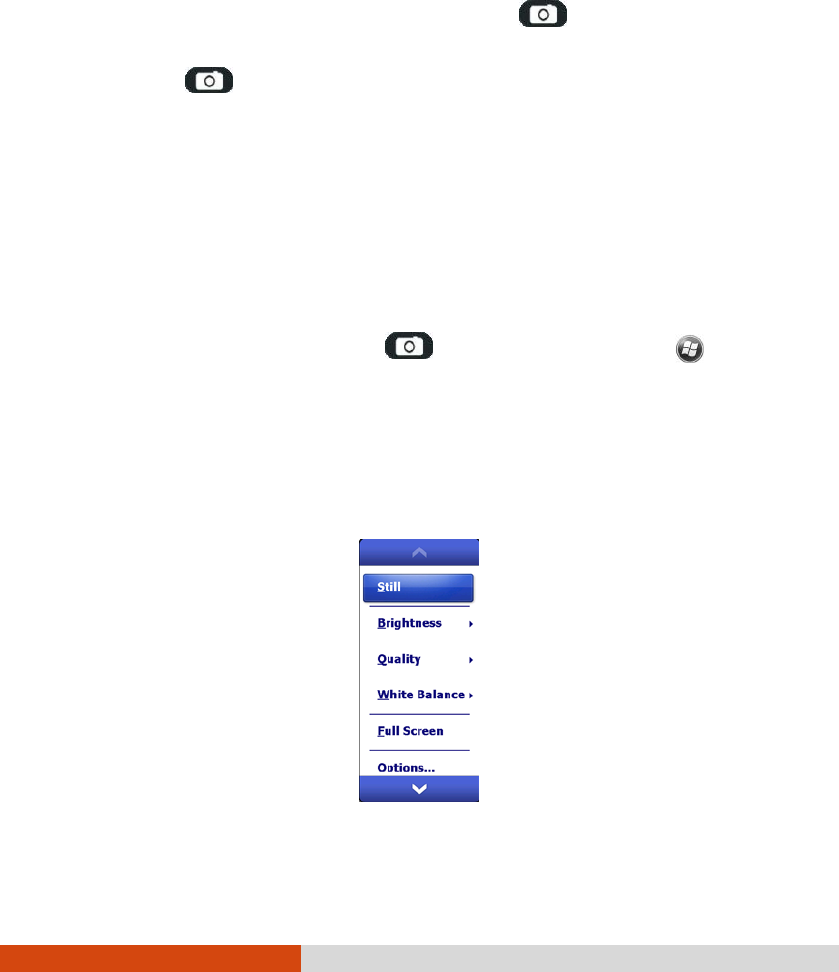
6-10 More Programs
NOTE: By default, the display area blanks out and shows the word
“Standby” when the camera has been idle for one minute. To resume, tap
the screen.
3. Aim the camera lens at the subject. Press the key halfway down for
automatic focusing. A green frame appears.
4. Press the key fully to take the picture.
5. The result shows on the screen if the picture was taken in Normal or
Timer mode. At this time, you can tap Menu to perform a desired task to
the current picture. Tap Camera or ok to go back to the Camera screen.
6. The picture is saved to the predefined storage location (as long as you
didn’t delete it in the previous step).
Recording Video Clips
1. To start the program, press the key on your device or tap
Programs Pictures & Videos Camera.
2. Tap Menu Video to switch to the video mode. Below the display area
are indicators of the current status.
3. For recording controls such as brightness and white balancing, tap
Menu.

More Programs 6-11
Menu Items Descriptions
Brightness Seven brightness levels
Quality 352 x 288
White Balance Five choices from which you can select one that matches
the current light source.
Full Screen Full screen on and off.
Options Overall settings to the Camera program.
Flicker Set to the frequency of the local electrical system
(60Hz or 50Hz) for flicker free shooting where
electrical lights exist.
Night Mode On or off. Set to On for shooting in low light
situations.
BLC On or off. Set to On to correct the exposure of subjects
that are in front of a bright light source.
NOTE: By default, the display area blanks out and shows the word
“Standby” when the camera has been idle for one minute. To resume, tap
the screen.
4. Press the key to start recording.
If needed, you can tap Pause to temporarily pause the recording and
then tap Resume to continue.
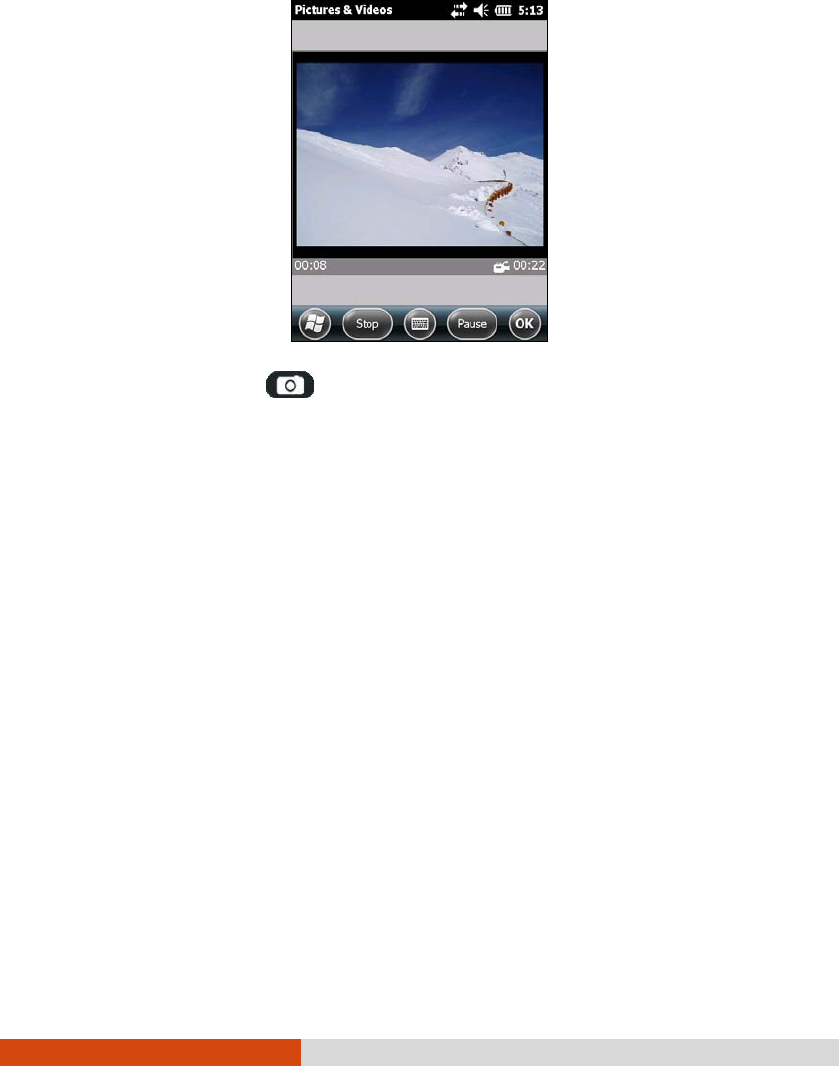
6-12 More Programs
5. To stop, press the key or tap Stop.
Or, the recording will automatically stop when the length reaches the
pre-defined maximum value (30 seconds by default).
6. The video clip is saved to the predefined storage location. To view the
video clip, tap Thumbnails.
Camera Controls and Options
While taking pictures or recording video clips, you can tap Menu to use a
function that meets your specific need.
For one time overall settings to the Camera program, tap Menu Options.
Make the necessary changes. Tap OK when finished. The changes take effect
immediately.
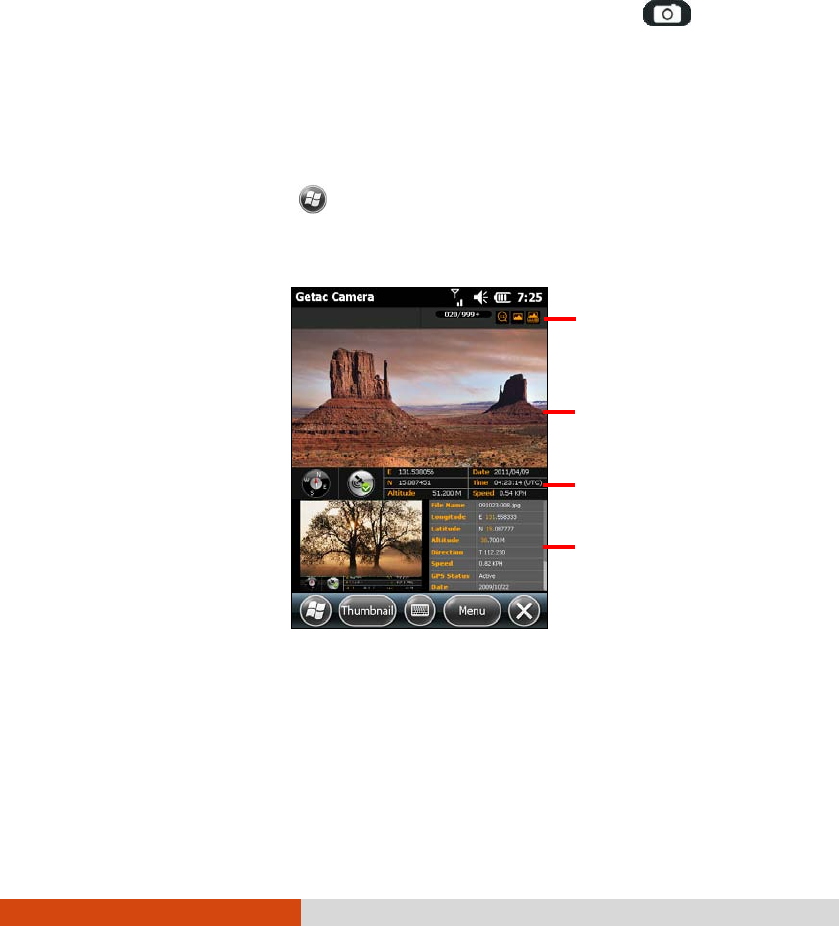
More Programs 6-13
Getac Camera
Overview
NOTE: Your device has two Camera programs. By default, the key on
your device starts the Camera (in Picture & Videos) program. You can change
the key to start the Getac Camera in Settings.
Getac Camera is a geo-tagging camera program, which allows you to stamp
geographical information on photos as watermarks and embed such
information into JPEG files as EXIF 2.2 metadata.
To start the program, tap Getac Camera. The GPS positioning will be
automatically activated. When the GPS positioning is completed, you will see
the geographical information in the watermark area on the screen.
Status Bar
Live Image
Watermark
Instant View
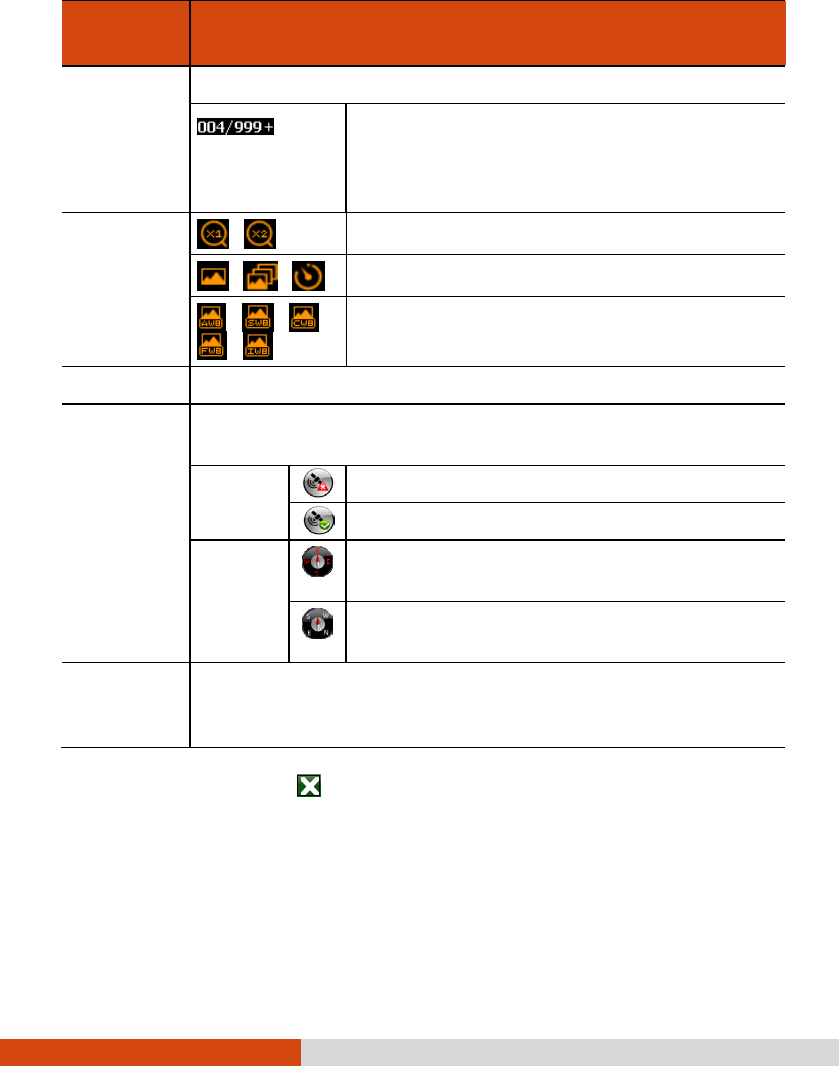
6-14 More Programs
Screen
Elements Descriptions
Status Bar Displays the current status.
Number of pictures already taken / Total
number of pictures allowed.
(Maximum number shown is 999 even if the
storage capacity allows for more.)
Status Bar / Current zooming level.
/ / Current shooting mode: Normal/Burst/Timer
/ / /
/
Current white balance: Automatic/Sunshine/
Cloudy/Fluorescence/Incandescence
Live Image Displays the live image.
Watermark Displays the GPS information such as direction, GPS status,
longitude, latitude, altitude, date, time, and speed.
GPS
Signals No or poor GPS signals.
GPS positioning completed.
Compass Letters in red: GPS information not available
or compass not calibrated.
Letters in white: GPS or compass information
available.
Instant
View
Displays the picture you have just taken or selected. The left
part contains the preview image and the right part contains
the properties of the image.
To exit the program, tap at any time.
NOTE: If the message “Not enough memory available for attempted
operation. Please check system memory.” appears, try one of the below to
free the memory of your device.
− Stop programs you are not currently using.
− Set the resolution of the images to a lower one.
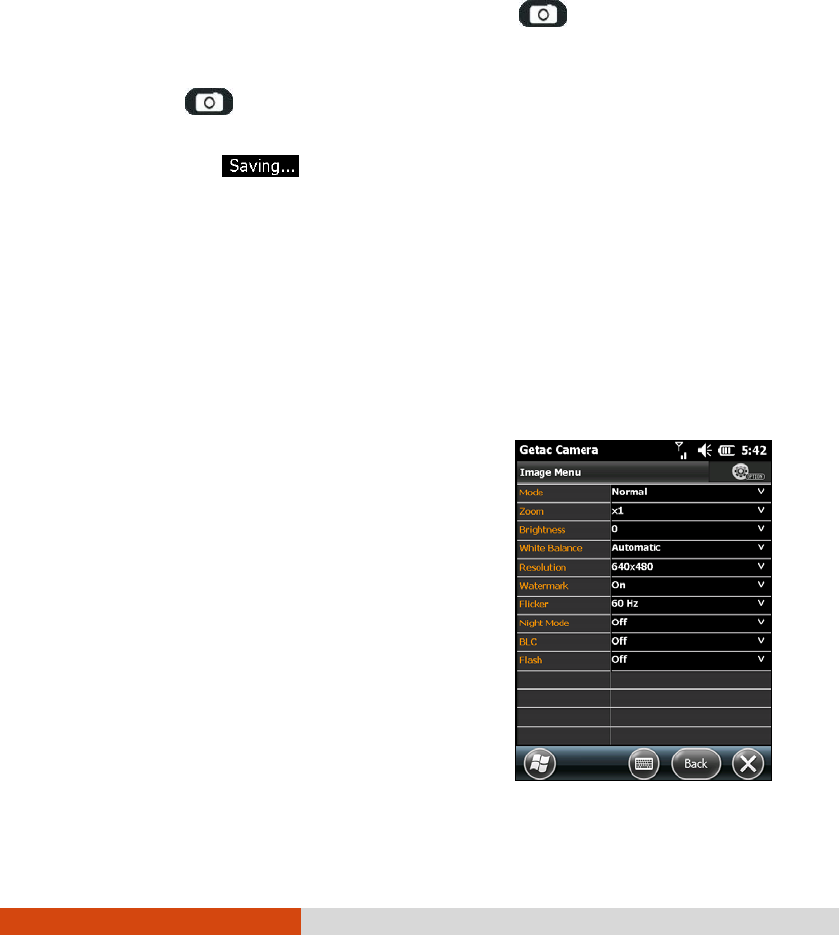
More Programs 6-15
Taking Pictures
1. Start the Getac Camera program. You will be in Camera Mode.
2. For camera controls such as brightness and zooming, tap Menu.
3. Aim the camera lens at the subject. Press the key halfway down for
automatic focusing. A white frame appears. Wait until the color of the
frame turns green indicating the subject is in focus.
4. Press the key fully or tap and hold the Live Image area to take the
picture.
5. The message appears on the screen for a few seconds, meaning
the picture is saved to the predefined storage location.
NOTE: Always wait for the saving procedure to complete before giving the
next command. An untimely command can be lost, especially in Burst mode.
6. The result shows in the Instant Image area below. You can tap the area
twice to switch to Brower Mode for the full view. (See “Browser Mode”
later for more information.)
Camera Mode Settings
To change camera settings, tap Menu while in
Camera Mode.
Tap the down arrow of the item you want to
adjust. In the pull-
down menu, tap your choice.
When finished, tap Back and then Yes.
All changes (except for Mode
) remain effective
until you change them again.
* The above screen shows the
default settings.
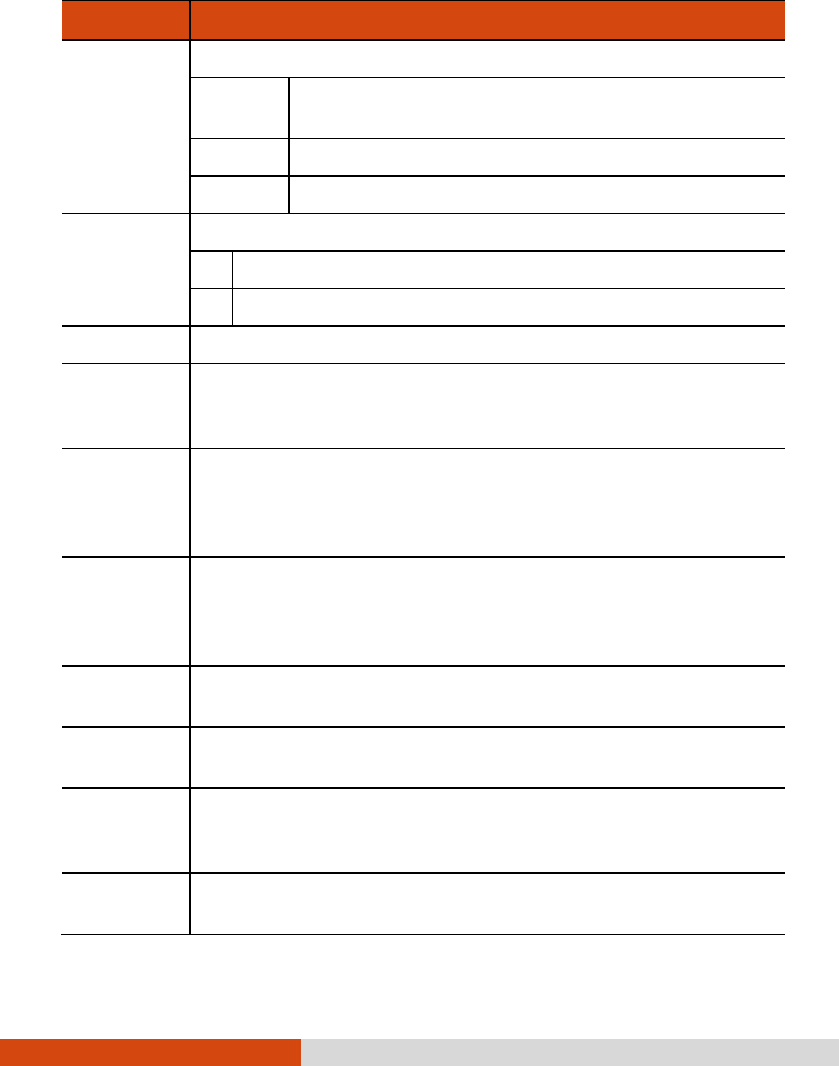
6-16 More Programs
Menu Items
Descriptions
Mode Three choices for the shooting mode:
Normal This is the default setting whenever the program is
started.
Burst Continuous shooting of 3 pictures.
Timer 5 second countdown before shooting.
Zoom Available choices depend on the current resolution setting.
x1 Available for all.
x2 Available under 640x480 resolution setting.
Brightness Seven brightness levels.
White
Balance
Five choices (Automatic, Sunshine, Cloudy, Fluorescence, and
Incandescence) from which you can select one that matches
the current light source.
Resolution Four choices(640x480, 1280x960, 1600x1200, 2048x1536,
2560x1536, and 2592x1944).
When set to a resolution higher than 640x480, the zoom level
is limited to x1.
Watermark On or Off.
Set to Off if you do not want the watermark to show in the
picture. (This does not affect the embedded EXIF 2.2
metadata.)
Flicker Set to the frequency of the local electrical system (60Hz or
50Hz) for flicker free shooting under electric light.
Night Mode On or off.
Set to On for shooting in low light situations.
BLC On or off.
Set to On to correct the exposure of subjects that are in front
of a bright light source.
Flash On or off.
Set to On to add extra light for shooting in a dark place.

More Programs 6-17
Viewing Pictures
There are different ways to view pictures and data. On some occasions, you
can drag up/down or left/right on the screen to access the pictures and data
more easily.
Instant View
While in Camera Mode, the picture taken is immediately shown in the
Instant View area with properties information.
In this view, you can:
Tap the image twice to switch to Standard View.
Tap the properties list twice to switch to Properties View.
Go to the previous or next picture by any of the three methods:
− Drag across the image: from left to right
for the previous picture and vice versa.
− Press the left or right arrow key for the
previous or next picture.
− Tap the image and, when and icons appear on both sides, tap the
left or right arrow to go to the previous or next picture.
View all properties of the current picture by drag down or up in the
properties list on the screen.
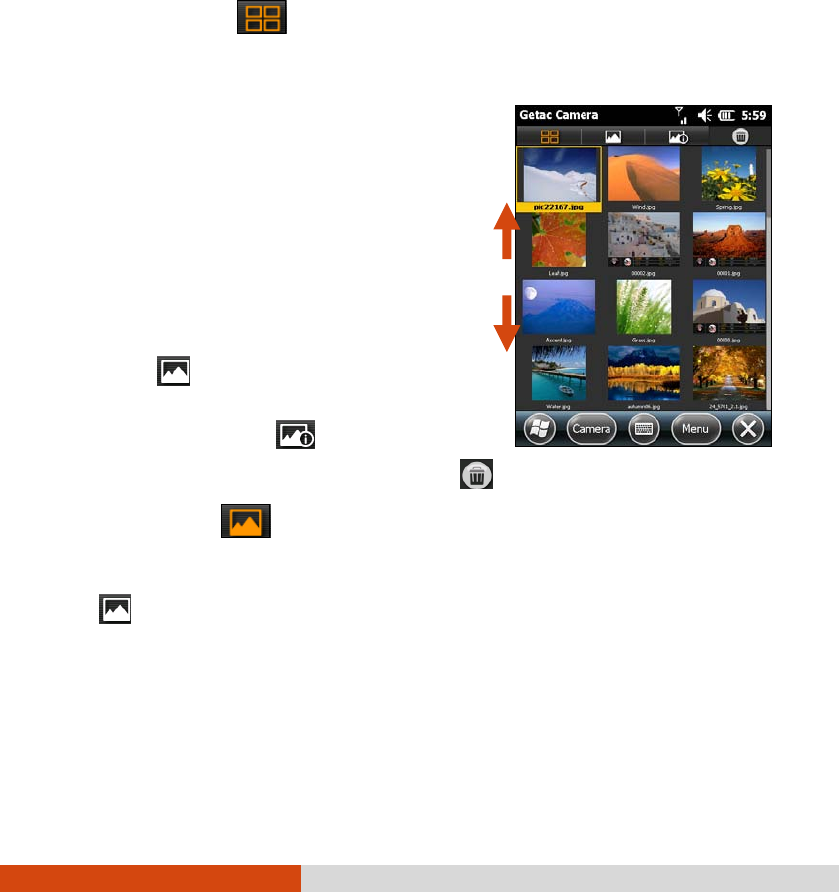
6-18 More Programs
Browser Mode
While in Camera Mode, tapping Thumbnail brings you to Browser Mode. To
switch back to Camera Mode, tap Camera.
Browser Mode has three views (Thumbnail, Standard, and Properties) as
described below.
Thumbnail View
Thumbnail is the default view of Brower Mode, showing 12 preview images
at one time.
In this view, you can:
Scroll down or up by dragging down or up
on the screen.
Go up/down/left/right one picture by
pressing the arrow key.
Switch to Standard View of the selected
picture by any of the two methods:
− Tap the picture twice.
− Tap .
Switch to Properties View of the selected
picture by tapping .
Delete the selected picture by tapping and then Yes.
Standard View
In Camera Mode, tapping the image twice in the Instant View area brings
you to Standard View. If you are currently in Thumbnail or Properties View,
tap to switch to this view.
The selected picture is shown in the upper part of the screen. The lower part
of the screen contains the strip of pictures; three small pictures (previous,
current, and next) are shown at a time.
In this view, you can:
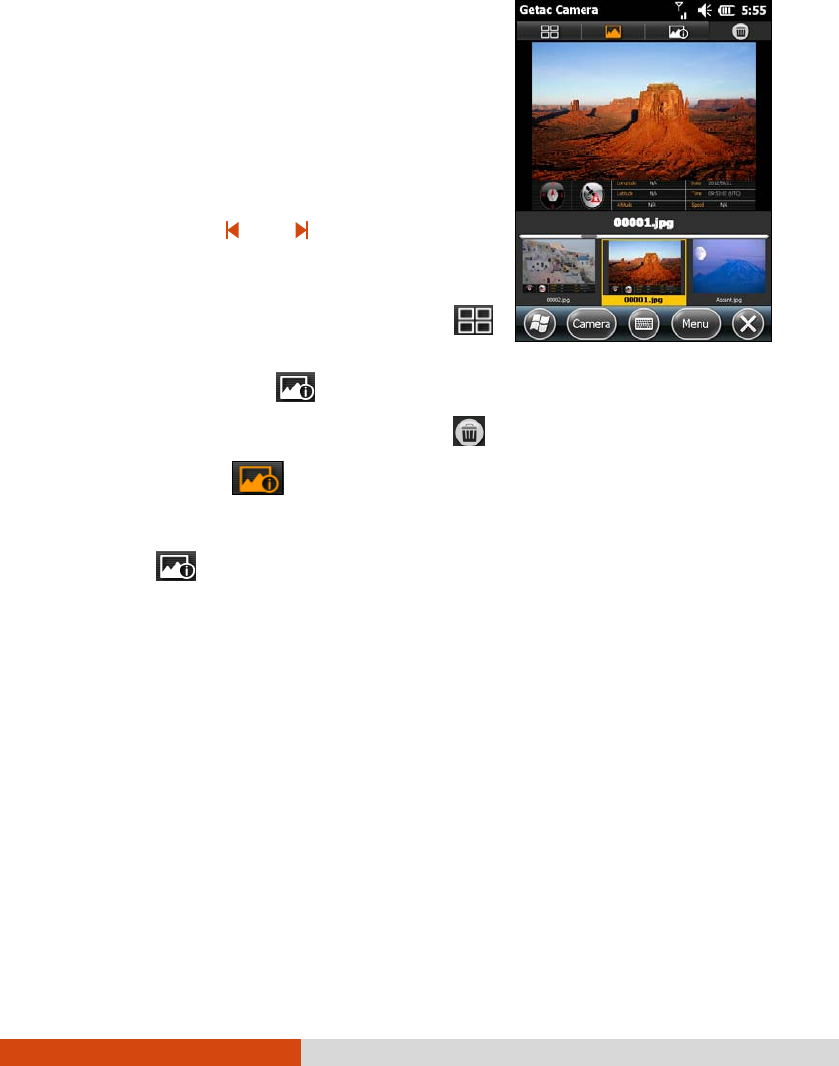
More Programs 6-19
Go to the previous or next picture by any
of the three methods:
− Tap the left or right picture in the Strip
area.
− Press the left or right arrow key for the
previous or next picture.
− Tap the left or right edge of the image
and, when and icons appear on
both sides, tap the left or right arrow to
scroll to the previous or next picture.
Switch to Thumbnail View by tapping .
Switch to Properties View of the selected
picture by tapping .
Delete the current picture by tapping and then Yes.
Properties View
In Camera Mode, tapping the properties list twice in the Instant View area
brings you to Properties View. If you are currently in Thumbnail or Standard
View, tap to switch to this view.
The information of the selected picture is shown in the upper part of the
screen. The lower part of the screen contains the strip of pictures; three
small pictures (previous, current, and next) are shown at a time.
In this view, you can:
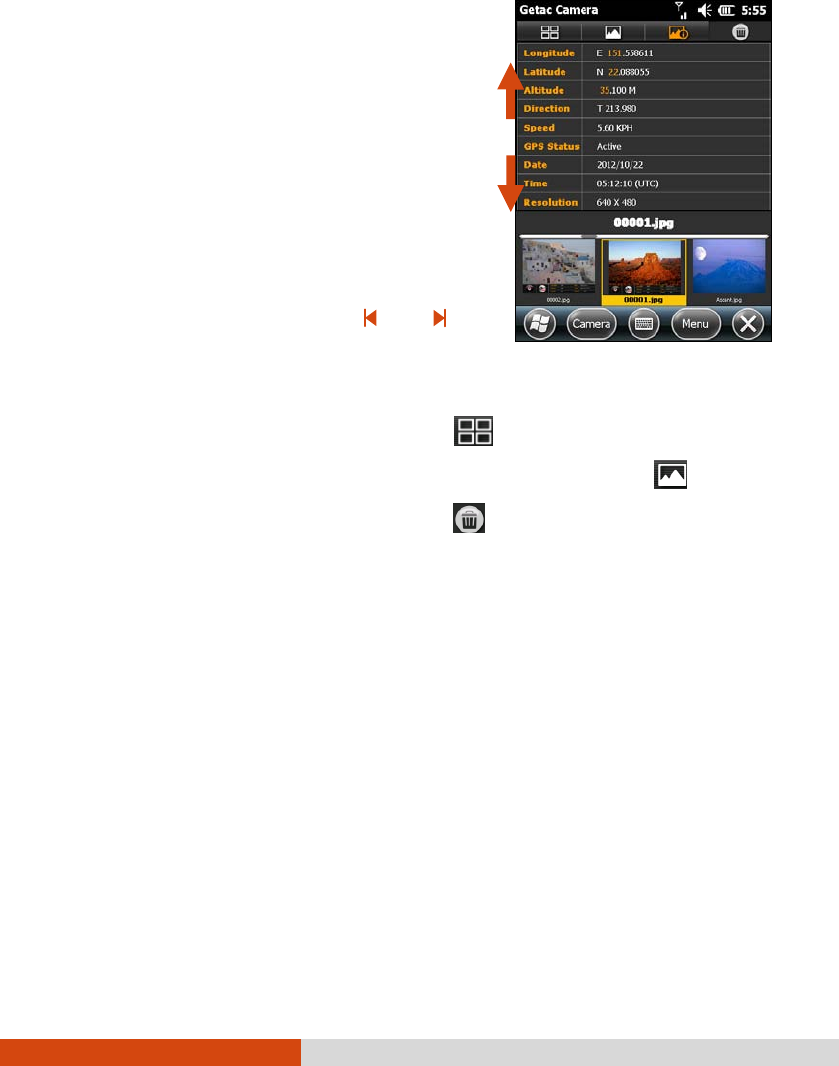
6-20 More Programs
View all properties of the current picture
by drag down or up within the properties
list on the screen.
Go to the properties of the previous or
next picture by any of the three methods:
− Tap the left or right picture in the Strip
area.
− Press the left or right arrow key for the
previous or next picture.
− Tap the left or right edge of the
properties list, and
, when and icons
appear on both sides, tap the left or
right arrow to scroll to the previous or
next picture.
Switch to Thumbnail View by tapping .
Switch to Standard View of the selected picture by tapping .
Delete the current picture by tapping and then Yes.
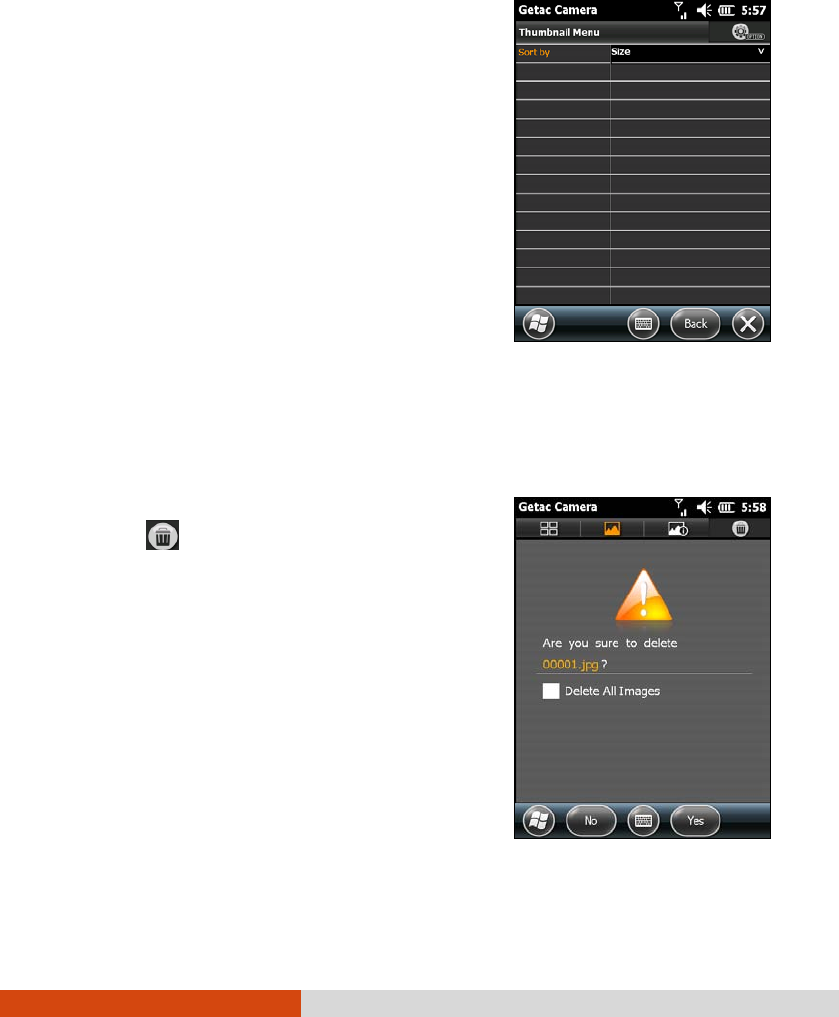
More Programs 6-21
Sorting Order
By default, the pictures are sorted by name in
Browser Mode. You can change the sorting
order to Size, Date, or Name.
To change the sorting order, tap Menu while
in any of the three views. Tap the down arrow
and, in the pull-down menu, tap your choice.
Tap Back and then Yes when finished.
Managing Images
Deleting All Images
If you want, you can delete all images by
tapping in any of the three views, check
the “Delete All Images” item, and tap Yes.
CAUTION: Deleted images cannot be restored.
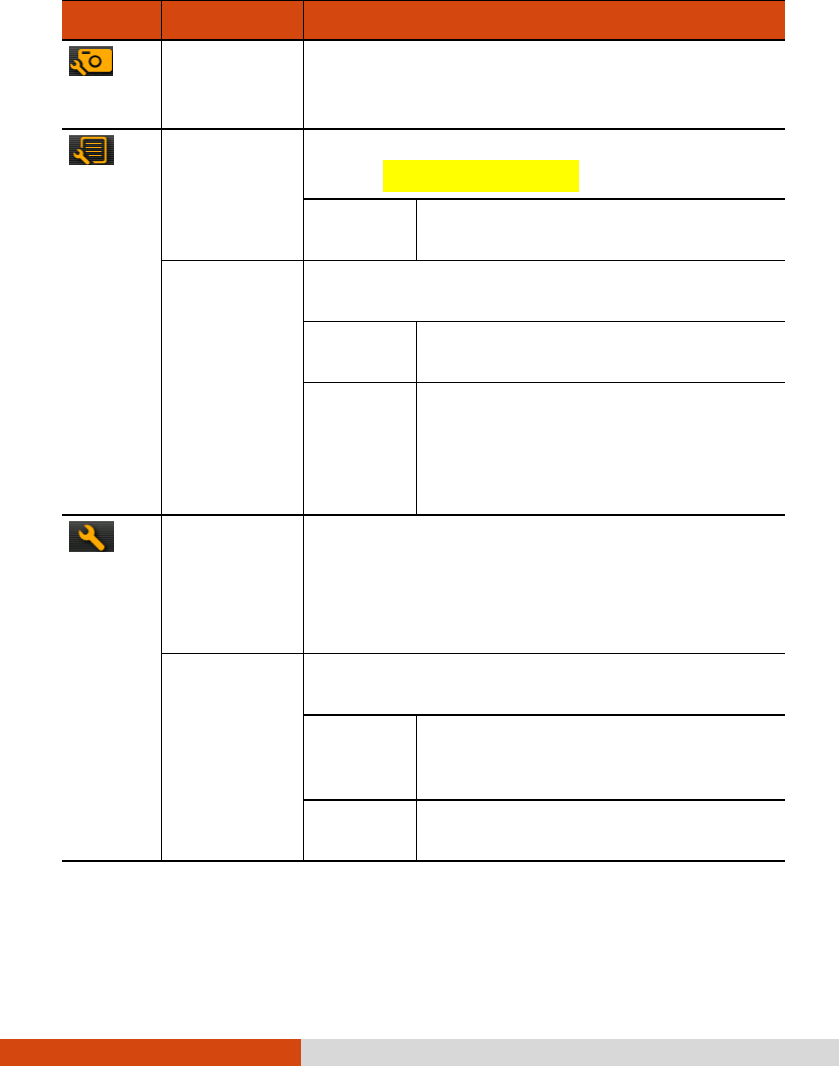
More Programs 6-23
Page Setting Items
Descriptions
Image
Option
Still Image
Compression
Level
Three choices: High Quality, Normal Quality, and
Low Quality. A higher setting means a larger file
size.
Data
Option
Altitude
Option
Displays altitude according to one of the two
choices: 只剩一項還需要選嗎?
GPS The altitude is based on GPS altitude
information.
Time Option Displays the time throughout the program
according to one of the two choices:
UTC The time is based on Coordinated
Universal Time.
System
time zone
The time zone setting of the device is
taken into consideration. If the
current location is in daylight saving
time, the time will be adjusted
accordingly.
General
Option
File Name
Prefix
By default, the filename is
xxxxx
(where
xxxxx
is a
sequential number).
You can add a prefix to the filenames (default is
no prefix). Type the characters in the entry field.
Maximum number of characters allowed is 3.
Save to Sets the storage location of the pictures to one of
the two choices:
Main
Memory
The picture will be saved to the
device’s My Documents/My Pictures
folder.
Storage
Card
This choice appears only when a
storage card is inserted.

6-24 More Programs
Page Setting Items
Descriptions
Sound Effect Sets if the program will play sounds for screen
tapping and photo shooting. (This setting is
independent of the “Sound and Notifications”
settings of Windows Mobile.)
About
Provides copyright and licensing information of
the program.
Tap Back and then Yes when finished. The changes remain effective until
you change them again.
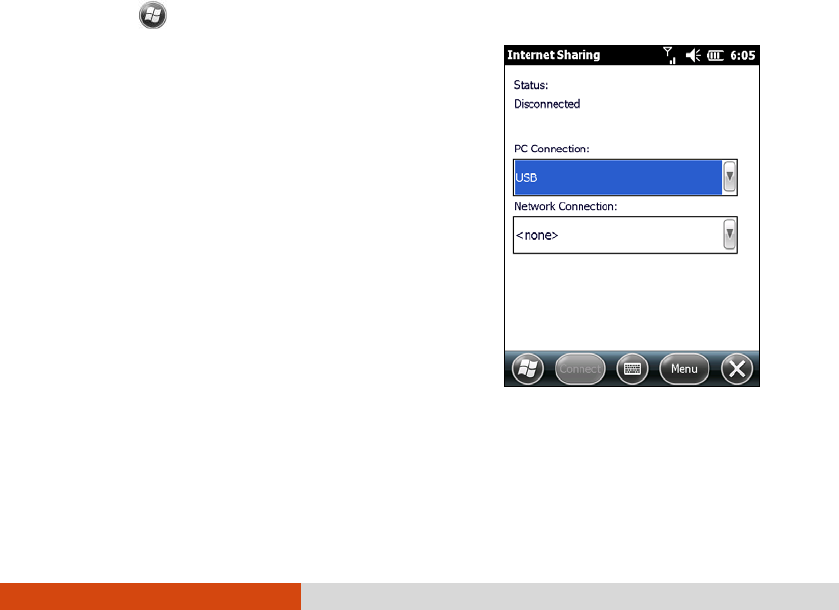
More Programs 6-25
Internet Sharing (Select Models
Only)
Using Internet Sharing, you can use your device as an external modem for
the computer via the USB or Bluetooth connection.
NOTE: The Internet Sharing function does not support Windows 98.
1. Make sure that your device is not connected to another device, and that
you have installed proper GPRS settings.
2. To use USB connection, connect your device to the computer with the
USB cable.
To use the Bluetooth connection, you must first initiate and complete
the Bluetooth Personal Area Network (PAN) partnership on the
computer. (For more information, refer to Windows Help and Support.)
3. Tap Internet Sharing.
4.
In PC Connection, select USB if using USB
connection.
Select Bluetooth PAN if using Bluetooth
connection. When prompted to make
your device as visible in the Bluetooth
settings, tap Yes.
5. In Network Connection, select your
GPRS setting (select models only).
6. Tap Connect for your device to connect
to the Internet.
Now your computer connects to the
Internet via your device.
7. To end the connection, tap Disconnect on your device.
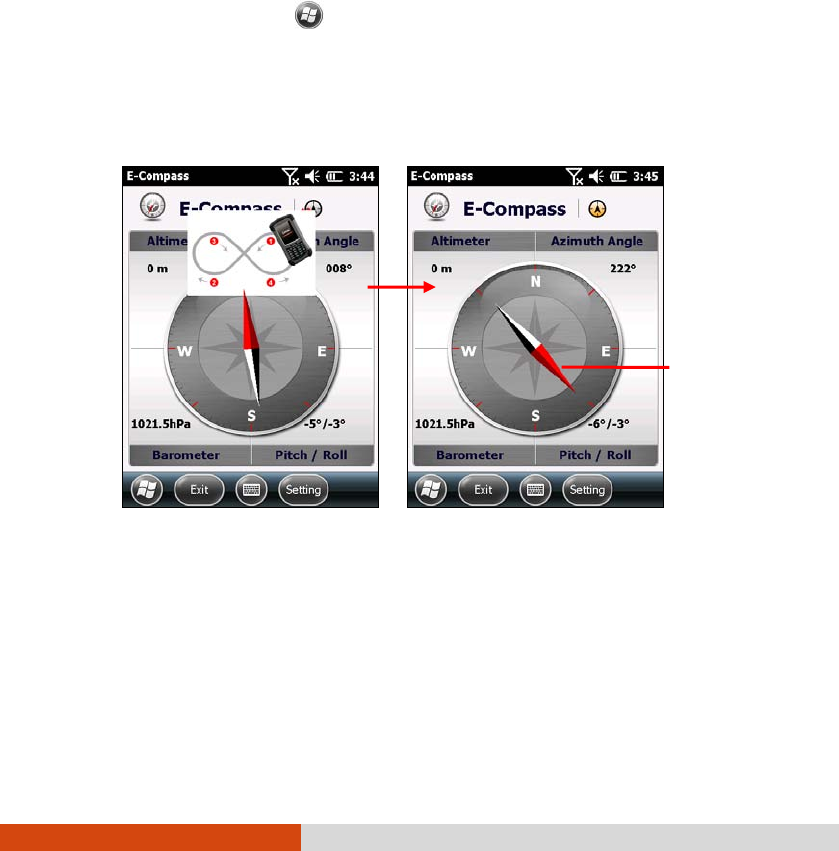
6-26 More Programs
E-Compass
The E-Compass program shows directions of movement including heading,
pitch angle, roll angle, and altitude.
Reading and Calibrating the Compass
To run the program, tap E-Compass.
Each time you start the program, you’ll be requested to calibrate the
compass. Hold the device in your palm and swing it in the way as shown in
the small popup window on the screen. Do this several times until the popup
window disappears.
To exit the program, tap Exit at the bottom left of the screen.
NOTE: Follow these guidelines when using the compass.
Keep the device away from objects that generate magnetic fields, such
as cars, large belt buckles, computers, cell phones, etc.
If you must use the compass inside a car, the device should be at least
20 cm (7.87 inches) away from metal objects such as car doors,
dashboard, air vents, etc.
Needle on
the compass
dial
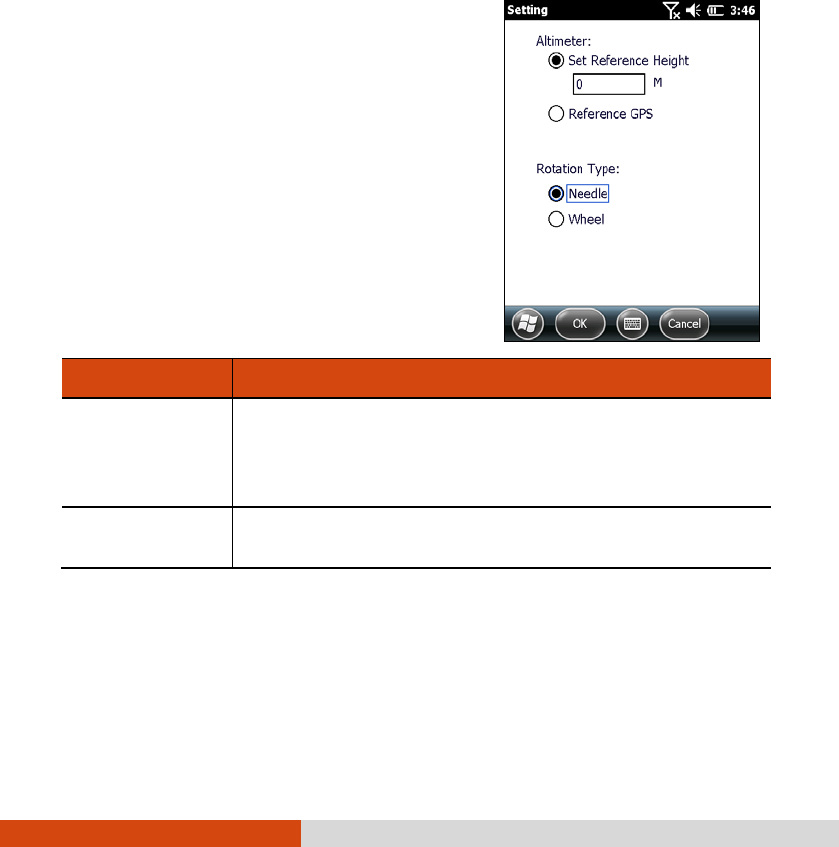
More Programs 6-27
Avoid playing the MP3 music with the internal speaker or connecting
the AC adapter. This will cause the magnetic interference to the
compass.
Regularly set the reference altitude for an accurate output. (See the
next section.)
Compass Settings
The value of altitude is adjusted according
to the change in the ambient pressure. It is
important that you regularly set the
reference altitude because the compass
needs an appropriate starting point
(altitude versus ambient pressure) for future
adjustments.
To configure the compass, tap Setting
Setting. When finished, tap OK to save the
changes and go back to the Compass screen.
Setting Items Descriptions
Altimeter Set the reference altitude for the compass. You can
either set a specific height (zero by default) or use GPS
positioning as the reference (GPS positioning will be
initiated after you tap OK).
Rotation Type Set to Needle for a pivoting needle on a fixed dial or
Wheel for a fixed needle on a rotating dial.
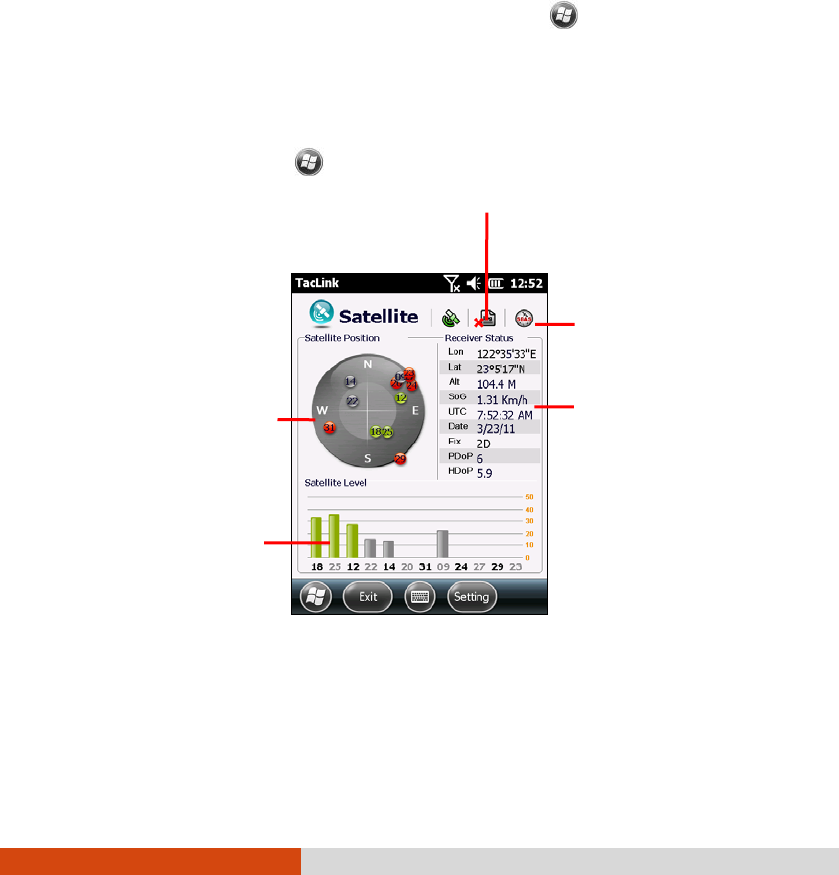
6-28 More Programs
TacLink
The TacLink program receives GPS satellite signals to calculate the location
of your device. You can also record a NMEA log file for the use of other
applications.
NOTE: TacLink only supports NMEA format. TacLink will not start if you
have set the GPS output format to Binary Mode in Settings
System GPS Mode for the need of third party programs.
Running TacLink
To run the program, tap TacLink.
A message appears if positioning is not completed in 10 minutes.
To exit the program, tap Exit at the bottom left of the screen.
S
hows the overhead
satellite positions.
Shows the signal strength
of the satellites.
Shows the result of GPS
positioning.
A minimum of
4 GPS satellite signals is
needed to calculate your
GPS position.
A red X indicates logging is not
activated. No X indicates logging is
activated.
This icon appears only if SBAS
is enabled. (See the next
section for information.)
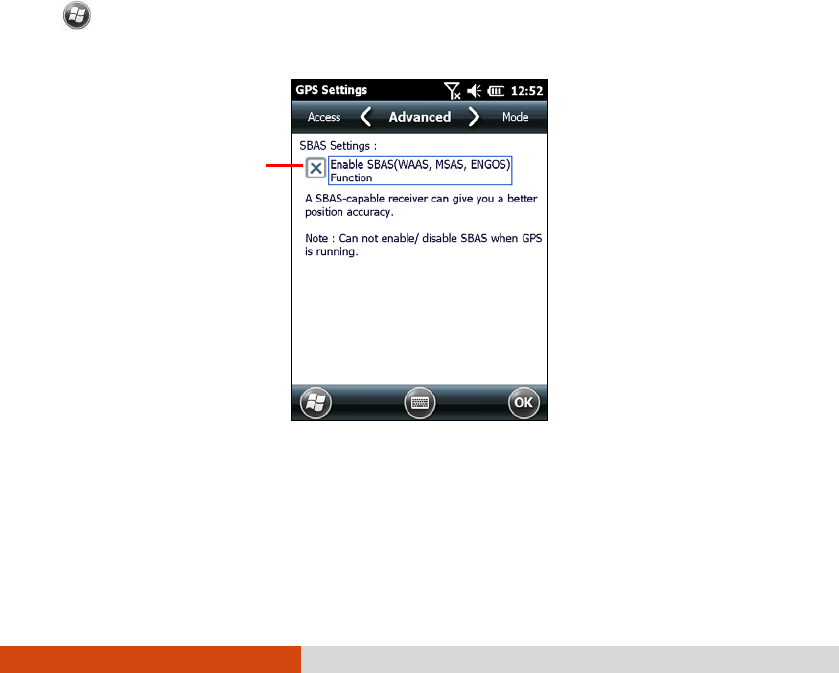
More Programs 6-29
NMEA Log
To start logging, tap Setting Log Start. To stop, tap Setting Log
Stop.
For each logging section, new data is added to the end of the existing data
in the same file. By default, the log file is named “GeTACGPSLog” and saved
to “My Documents” folder on your device. To specify a different name and
location for file, tap Setting Log File.
SBAS Settings
SBAS (WAAS, MSAS, ENGOS) provides additional accuracy and reliability for
the GPS devices. Ground stations are necessary to achieve the purpose.
The SBAS feature works where such stations exist. To enable the feature, tap
Settings System External GPS Advanced. Tap the checkbox to
enable or disable the SBAS function.
Tap OK when finished. If you change the setting while a GPS program (such
as TacLink) is running, the change takes effect only after you exit the GPS
program and then start it again.
Tap the checkbox to
enable or disable the
function. An X
indicates enabled.
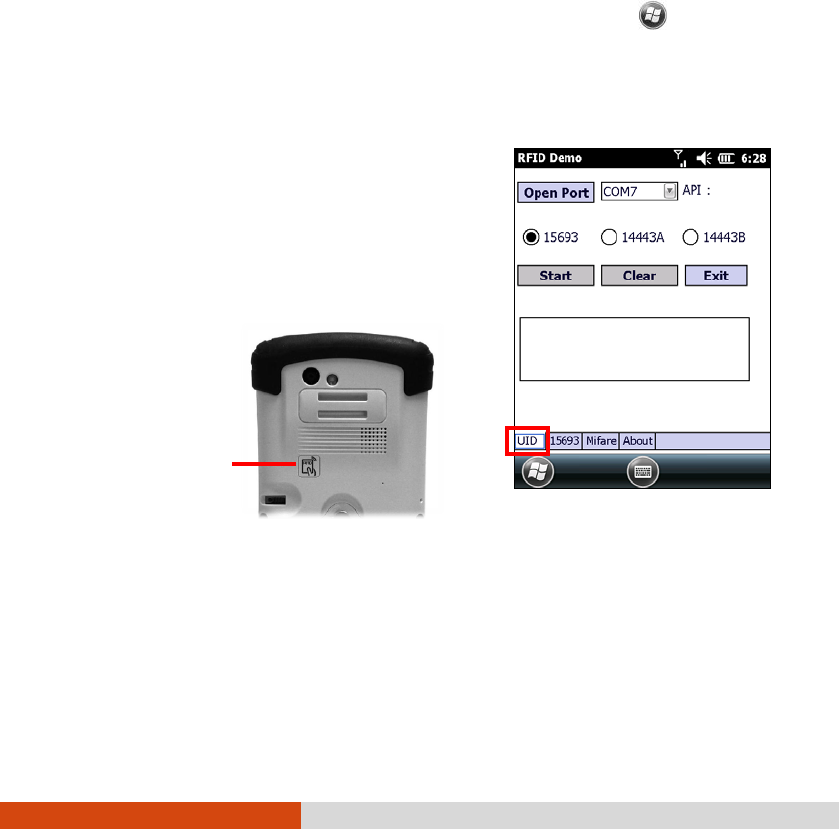
6-30 More Programs
RFID Demo
RFID Demo is a demo program that can read UID numbers from RFID tags
and write data to RFID tags. The tag types supported are ISO15693,
ISO14443A, ISO14443B and Mifare S50/S70.
NOTE: For enhanced applications and customization of the RFID module,
contact your authorized Getac dealer.
To run the program, press the Scan key on your device or tap RFID
Demo.
Reading Tags
1.
Start RFID Demo. The first page is UID.
2. Select a COM port to open and a tag type
to read (15693, 14443A, or 14443B).
3. Tap Start to begin reading.
4. Bring the tag near the RFID antenna.
If a tag of the matching type is found, its UID is displayed in the data
area.
5. To stop the reading session, tap Stop.
6. You can tap Clear to clear the data area.
Location of
internal RFID
antenna
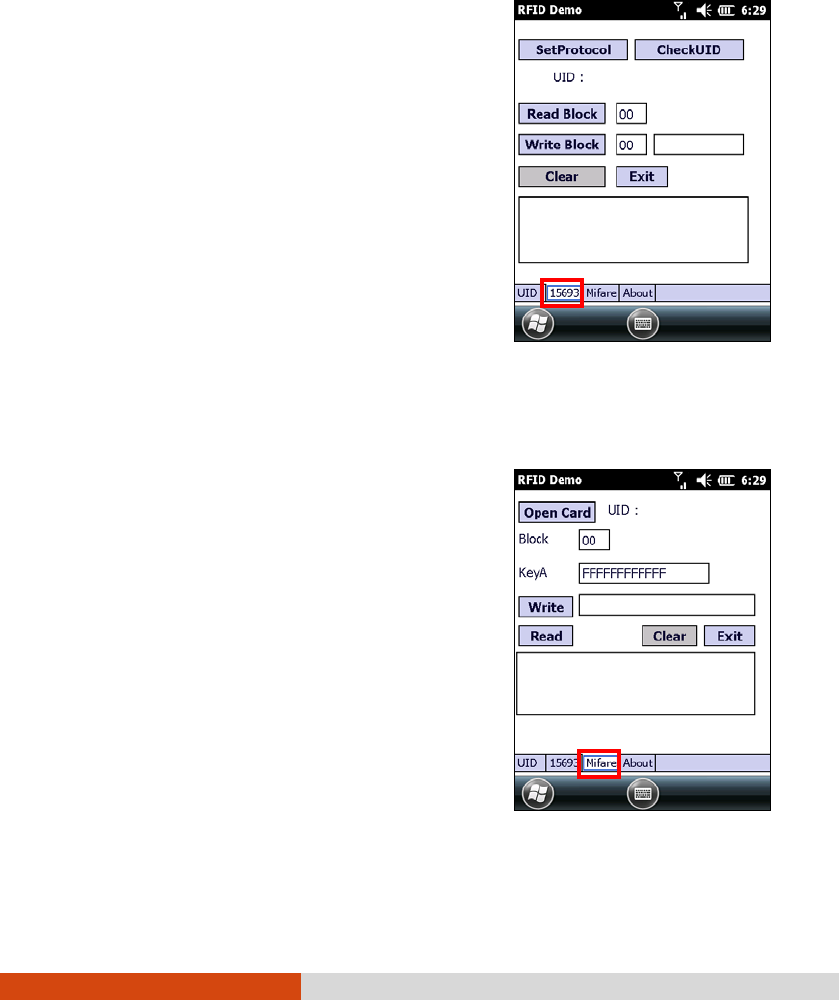
More Programs 6-31
Writing Data to 15693 Tags
1.
Start RFID Demo. Tap the 15693 tab.
2. Tap SetProtocol to specify 15693 as the
target.
3. Bring the tag near the RFID antenna.
Tap CheckUID to obtain the UID of the tag.
4. Enter the block number you want to read
data from. Tap Read Block. T
he data of the
block is displayed in the data area.
5. Enter the block number and the data you
want to write to the block. Tap Write
Block.
6. You can tap Clear to clear the data area.
Writing Data to Mifare Tags
1. Start RFID Demo. Tap the Mifare tab.
2. Bring the tag near the RFID antenna.
Tap Open Card to obtain the UID of the
tag.
3. Enter the KeyA password.
4. Enter the block number you want to read
data from and write to.
5. Enter the data you want to write to the
block. Tap Write
6. To read the data from the block, tap Read.
7. You can tap Clear to clear the data area.

Getting Connected 7-1
Chapter 7
Getting Connected
This chapter tells you how you can get your device connected through a
variety of ways.
Types of Connections
Your device can connect to the Internet, to your computer, and to other
devices and services.
Your device has two groups of connection settings: My ISP and My Work
Network. My ISP settings connect your device to the Internet, and My Work
Network settings connect to any private network, such as an intranet that
you use at work.
The following types of connections are available on your device:
Cellular (GPRS) is a long-distance wireless data connection that is
available through some mobile service operators. (Select models only)
Dial-up lets you access the Internet or a corporate network by dialing a
phone number. (Select models only)
Wi-Fi lets you wirelessly connect your device to the Internet through
access points that can be up to 30 meters (about 100 feet) away.
Bluetooth lets you create a temporary wireless network that can link up
to eight devices that are within 10 meters (about 33 feet) of one
another.
USB is a wired connection between your device and a computer for
synchronizing data or surfing the Internet. (See “ActiveSync” in Chapter
6 for information.)

7-2 Getting Connected
Using Cellular Connection (Select
Models Only)
Models supporting mobile phone functions allow you to access the Internet
using the mobile network.
Setting up a Cellular (GPRS) Connection
NOTE: You must subscribe to GPRS service with your mobile operator.
In most cases, your cellular (GPRS) connection will be preconfigured by your
cellular service provider. You will not have to set up a GPRS connection or
change your GPRS settings.
If you do have to set up a GPRS connection, you must obtain the settings
from your mobile operator before you start this procedure.
1. Tap Settings Connections Connections.
2. In either group, tap Add a new modem connection.
3. In the Enter a name for the connection field, enter a name for the
connection.
4. In the Select a modem field, select Cellular Line (GPRS), and then tap
Next.
5. Enter the access point name provided by your mobile operator, and then
tap Next.
6. Enter your user name and password, and then tap Finish.

Getting Connected 7-3
Setting up a Dial-up Connection
NOTE: Depending on your wireless service provider, dial-up connections
may not be supported on your device.
With dial-up, your service provider gives you a phone number that you dial
in order to connect your device to the Internet.
1. Tap Settings Connections Connections.
2. In either group, tap Add a new modem connection.
3. In the Enter a name for the connection field, enter a name for the
connection.
4. In the Select a modem field, select Cellular Line, and then tap Next.
5. Enter the phone number provided by your service provider, and then tap
Next.
6. Enter your user name and password, and then tap Finish.
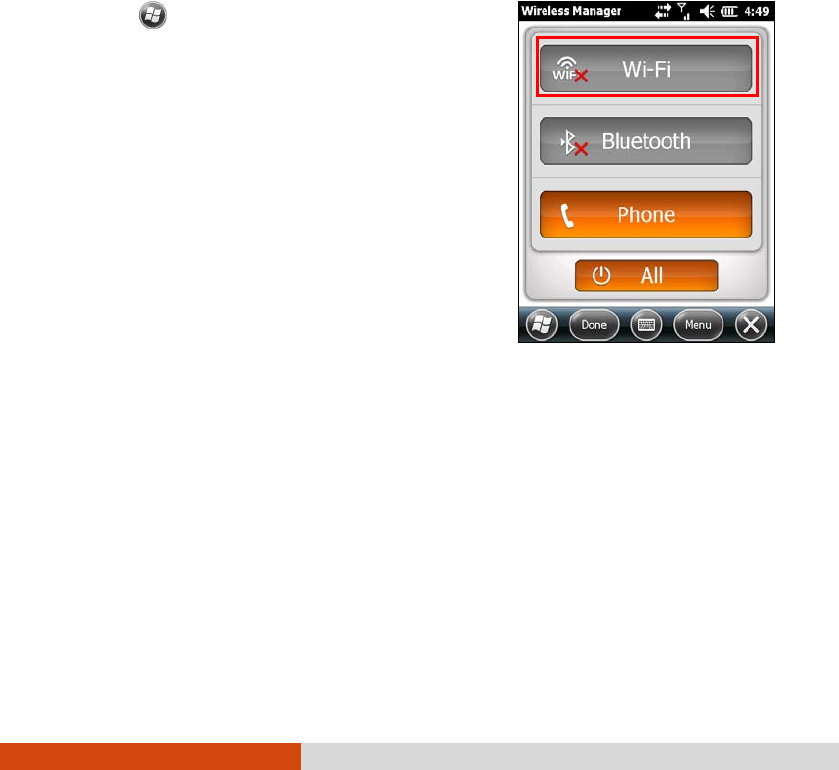
7-4 Getting Connected
Using Wireless Network
Your device has a built-in wireless network module. As long as you are in a
wireless LAN (WLAN) environment, you can connect to the network without
physical cables.
Switching On or Off the Wi-Fi Radio
By default, the Wi-Fi radio is switched off. To switch on or off the Wi-Fi
radio:
1. Tap Settings Connections
Wireless Manager.
2. In the Wireless Manager screen, tap Wi-Fi
to change the Wi-Fi radio status.
When switched on, your device will display
the word Available if wireless networks
are detected.
If you have previously connected to a
wireless network, your device will try to
connect to the same network and display
the name of the network after the
connection.
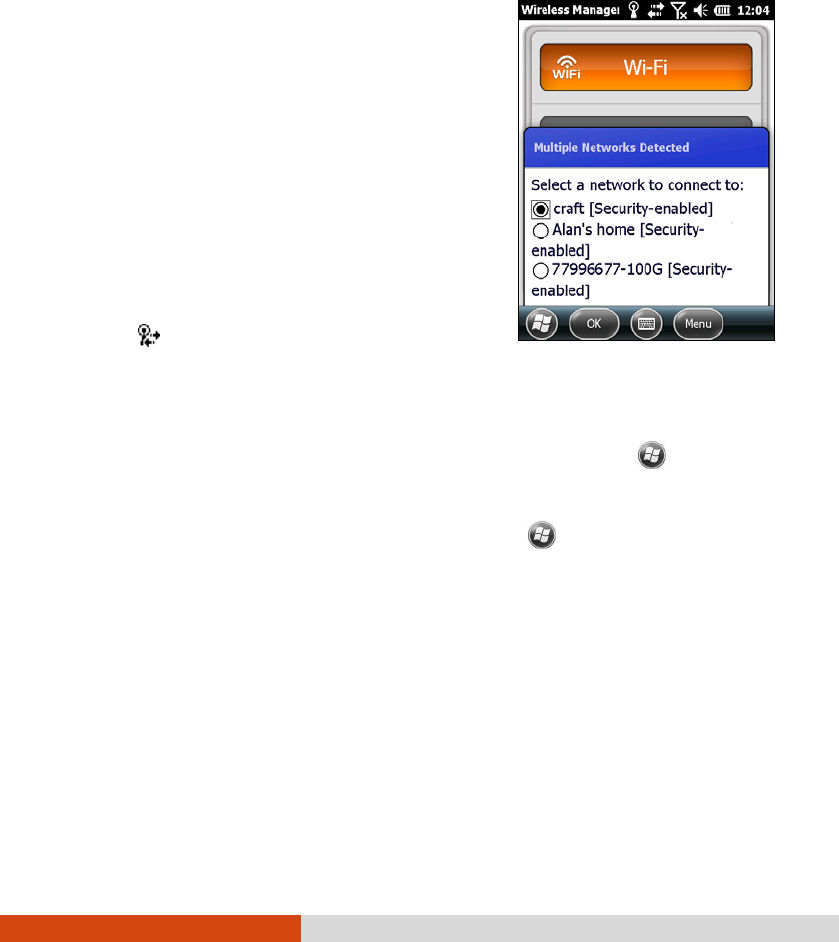
Getting Connected 7-5
Connecting to a Wireless Network
1. Switch on the Wi-Fi radio. (See “Switching On or Off the Wi-Fi Radio”
previously.)
2. Your device will detect available Wi-Fi
networks. When detected, the
Notification soft button appears in the
toolbar. Tap Notification to see the
network list.
3. Select the network you want to connect
to, and tap OK.
4. Select to connect to the Internet or the
private network, and then tap Connect.
5. If the selected network requires a network
key, enter the key and tap Connect.
The icon appears on the navigation bar
and the RF indicator on your device flashes
in amber.
NOTE:
You can also search for a network to connect by tapping Settings
Connections Wi-Fi.
Once you have connected to a network, the shortcut is created in
Settings. To change the network settings, tap Settings
Connections Wi-Fi. Tap the desired network and change the settings.
When you have finished using the wireless network, end the Wi-Fi
connection by switching off its radio. Leaving the radio on will consume
more power.
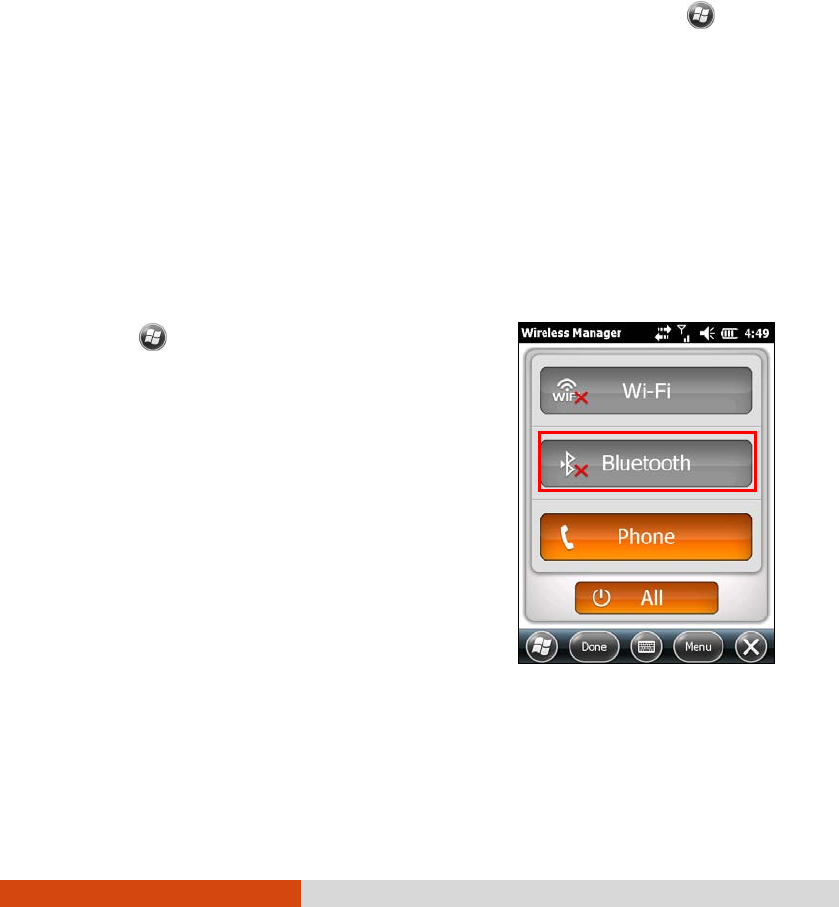
7-6 Getting Connected
Using the Bluetooth Function
NOTE:
Getac does not guarantee the product’s compatibilities with the
Bluetooth headsets/devices from all manufacturers.
To know the Bluetooth profiles that your device supports, tap
Settings Bluetooth About Profiles.
Your device incorporates the Bluetooth capability. Bluetooth technology is a
short-range wireless communications technology. Devices with Bluetooth
capabilities can exchange information over a distance of about 10 meters (30
feet) without requiring a physical connection.
Switching On or Off the Bluetooth Radio
By default, the Bluetooth radio is switched off. To switch on or off the
Bluetooth radio:
1. Tap Settings Connections
Wireless Manager.
2. In the Wireless Manager screen, tap
Bluetooth to switch on or off the radio.
The RF indicator flashes in blue to indicate
that the Bluetooth radio is on.
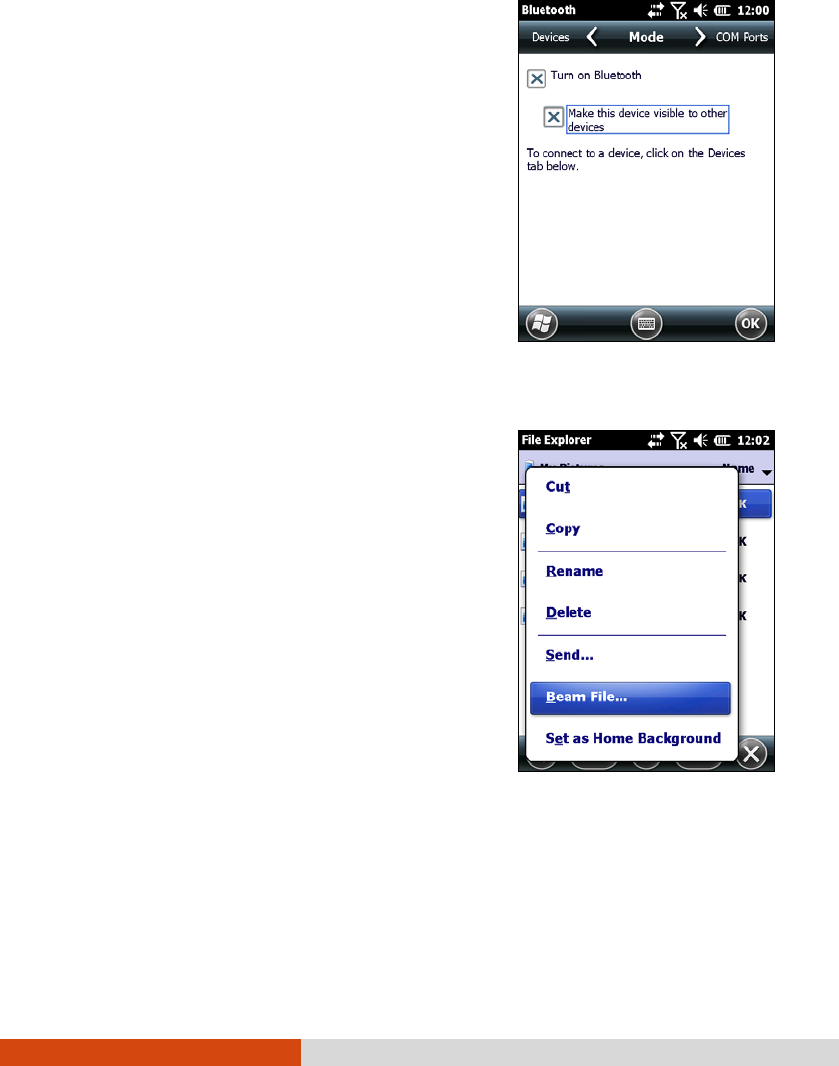
Getting Connected 7-7
3. For other devices to detect your device,
tap Menu Bluetooth Settings Mode
Make this device visible to other
devices.
4. Tap OK.
NOTE: When not using the Bluetooth
function, switch off the Bluetooth radio.
Leaving the radio on will consume more
power.
Sending Files via the Bluetooth Function
1.
Switch on the Bluetooth radio. (See
“Switching On or Off the Bluetooth
Radio” previously.)
2. From the program, tap and hold the item
you want to beam, such as an appointment
in Calendar, a task in Tasks, a contact card
in Contacts, or a file in File Explorer.
3. Tap Beam [type of item] in the shortcut
menu.
4. Your device searches for other devices
with Bluetooth capabilities within close
range, and displays them in the list. Tap
the device to which you want to send the
item.
CAUTION: Files are saved automatically before they are beamed. If a Word
document or Excel workbook was created on a computer, unsupported
content and formatting may be lost when the files are saved.
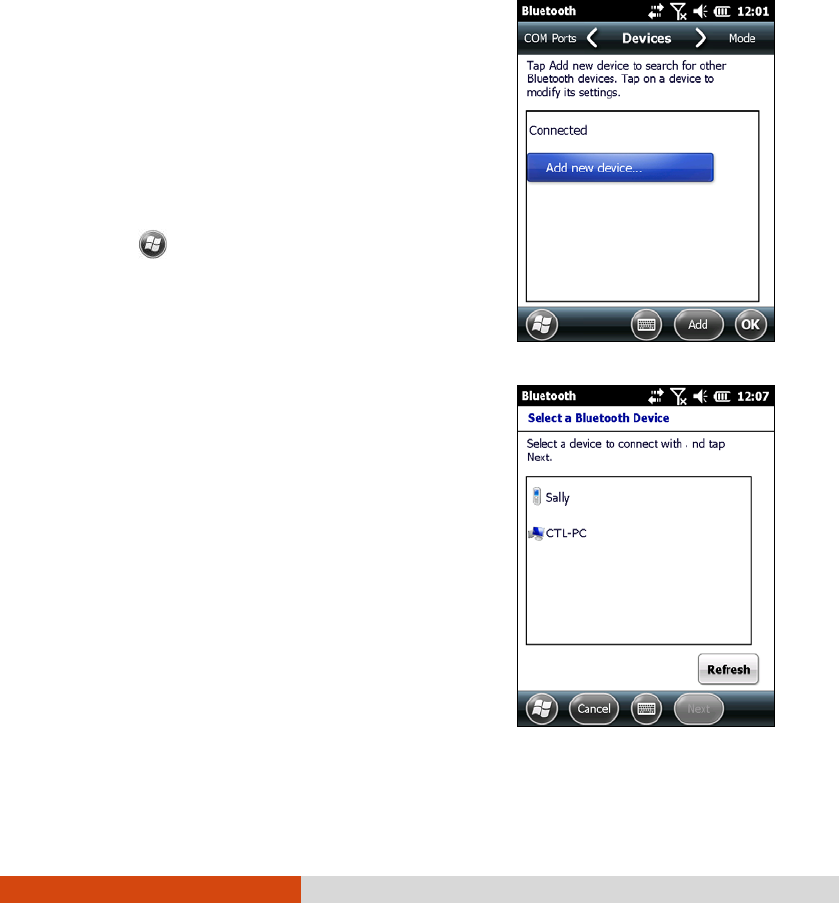
7-8 Getting Connected
Creating a Bluetooth Partnership
A partnership is a relationship that you create between your device and
another device with Bluetooth capabilities to help exchange information in
a secure manner.
Creating a partnership involves entering the
same Bluetooth passcode on both devices.
Once a partnership is created, your devices
need only have the Bluetooth function
switched on to exchange information; they
do not need to be visible.
1. Make sure that the two devices are
switched on, visible, and within close
range.
2. Tap Settings Connections
Bluetooth Devices Add new device.
Your device searches for other devices
with Bluetooth capabilities, and displays
them in the list.
3.
Tap the name of the other device, and tap
Next.
4. In Passcode, enter an alphanumeric
passcode between
1 and 16 characters,
and tap Next.
5. Enter the same passcode on the other
device.
6. Tap Done.

Troubleshooting and Maintenance 8-1
Chapter 8
Troubleshooting and
Maintenance
This chapter gives solutions to common device problems you may encounter.
It also provides guidelines on taking care of your device.
Resetting Your Device
Occasionally, you may need to reset your device. For example, you should
reset your device when it stops responding; or appears to be “frozen” or
“locked up.”
To reset your device, press the power button for at least 10 seconds. Your
device should restart.
Restoring Factory Default State
In some cases, you may need to restore your device to the factory default
state by clearing the memory from your device. For example, you should
clear the memory:
When your device does not respond after being restarted.
When you forget your password.
Clearing the memory means all data you have entered in your device’s
memory, including all files, system settings and additional programs you

8-2 Troubleshooting and Maintenance
have installed, will be erased. (Programs installed to ROM at the factory are
not affected.)
CAUTION: To ensure the integrity of your data should it be necessary to
clear the memory, you are advised to regularly back up your data.
Follow this procedure to clear the memory from your device:
1. Remove the battery and then replace it.
2. Press the up arrow key and the Action key, and while keeping the
two keys down, press the power button.
3. Release all the keys when you see the “Clean boot now” message.
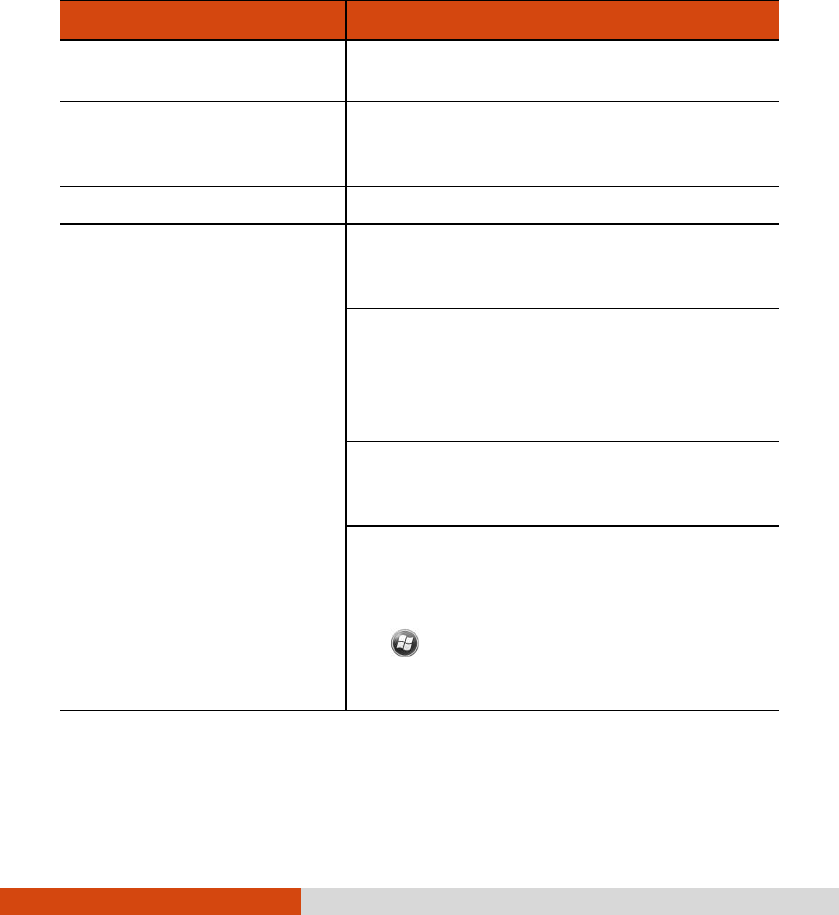
Troubleshooting and Maintenance 8-3
Troubleshooting
NOTE: If you encounter a problem you cannot solve, contact your dealer for
assistance.
Problem Solution
Power does not switch on
when using battery power.
The remaining battery power may be too
low to run your device. Charge the battery.
Screen responds slowly. Make sure that your device is not running
out of battery power. If the problem still
persists, restart your device.
Screen freezes. Restart your device.
Cannot establish a
connection with a computer
via USB.
Make sure that your device and your
computer are both switched on before
trying to establish a connection.
Make sure that the cable is securely plugged
into the USB port on your computer and on
your device. Connect the USB cable directly
to your computer—do not run the cable
through a USB hub.
Restart your device before connecting the
cable. Always disconnect your device before
you restart your computer.
In some specific cases, your device may
experience connection problems when it is
connected to a Windows computer running
ActiveSync. To resolve the problems, please
tap Settings Connections USB to
PC, and then clear Enable advanced network
functionality.
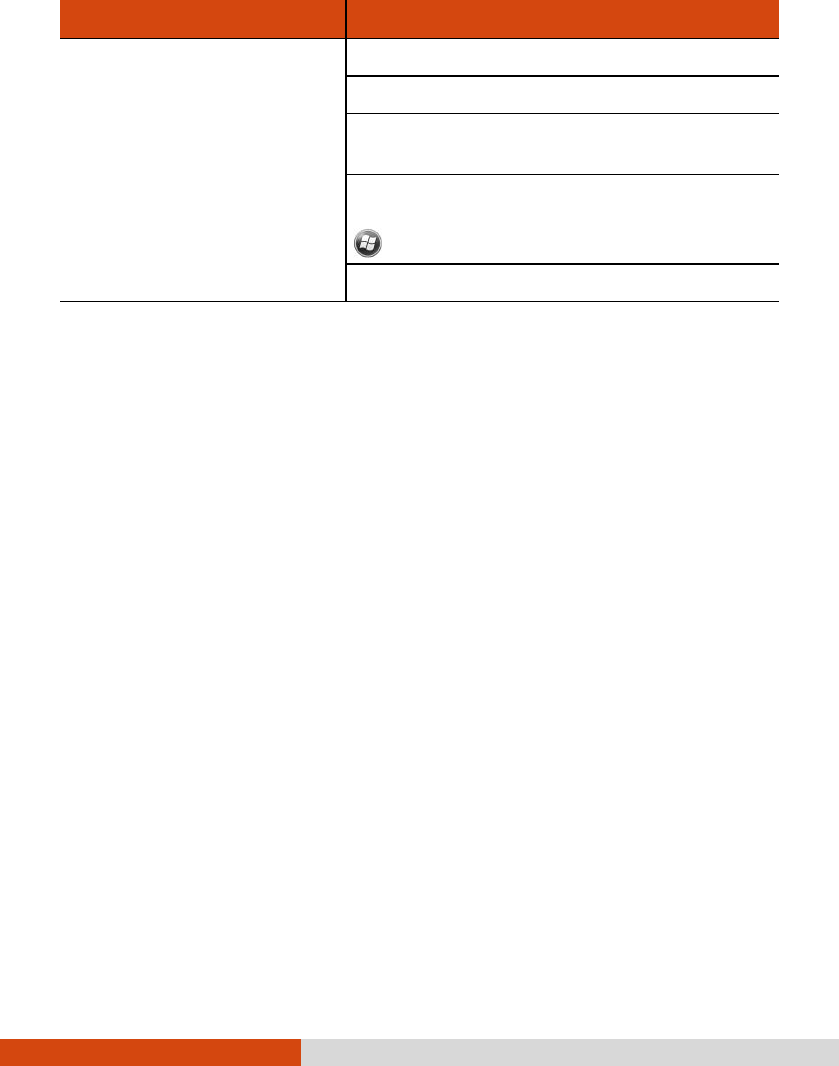
8-4 Troubleshooting and Maintenance
Problem Solution
A warning message of not
enough memory appears.
Delete files you no longer need.
Remove programs you no longer need.
Delete all files and clear history in Internet
Explorer.
Stop programs you are not currently using. To
check the state of your active programs, tap
Settings System Task Manager.
Restart your device.
Caring for Your Device
Taking good care of your device will ensure trouble-free operation and
reduce the risk of damage to your device.
Keep your device away from excessive moisture and extreme
temperatures.
Avoid exposing your device to direct sunlight or strong ultraviolet light
for extended periods of time.
Do not place anything on top of your device or drop objects on your
device.
Do not drop your device or subject it to severe shock.
Do not subject your device to sudden and severe temperature changes.
This could cause moisture condensation inside the unit, which could
damage your device. In the event of moisture condensation, allow your
device to dry out completely before use.
The screen surface can easily be scratched. Avoid touching it with sharp
objects. Non-adhesive generic screen protectors designed specifically for
use on portable devices with LCD panels may be used to help protect the
screen from minor scratches.

Troubleshooting and Maintenance 8-5
Never clean your device with it powered on. Use a soft, lint-free cloth to
wipe the screen and the exterior of your device.
Do not use paper towels to clean the screen.
Never attempt to disassemble, repair or make any modifications to your
device. Disassembly, modification or any attempt at repair could cause
damage to your device and even bodily injury or property damage and
will void the warranty.
Do not store or carry flammable liquids, gases or explosive materials in
the same compartment as your device, its parts or accessories.

Regulatory Information 9-1
Chapter 9
Regulatory
Information
This chapter provides regulatory statements and safety notices on your
device.
NOTE: Marking labels located on the exterior of your device indicate the
regulations that your model complies with. Please check the marking labels
on your device and refer to the corresponding statements in this chapter.
Some notices apply to specific models only.
Regulations Statements
European Notice
Products with the CE marking comply with Radio & Telecommunication
Terminal Equipment Directive (R&TTE) (1999/5/EEC), the Electromagnetic
Compatibility Directive (89/336/EEC) and the Low Voltage Directive
(73/23/EEC) – as amended by Directive 93/68/ECC – issued by the Commission
of the European Community.
Compliance with these directives implies conformity to the following
European Standards:
EN301489-1: Electronic compatibility and Radio spectrum Matters (ERM),
ElectroMagnetic Compatibility (EMC) standard for radio equipment and
services; Part 1: Common technical requirements
EN301489-17: Electronic compatibility and Radio spectrum Matters (ERM),

9-2 Regulatory Information
ElectroMagnetic Compatibility (EMC) standard for radio equipment and
services; Part 17: Specific conditions for 2.4 GHz wideband transmission
systems and 5 GHz high performance RLAN equipment
EN55022: Radio disturbance characteristics
EN55024: Immunity characteristics
EN6100-3-2: Limits for harmonic current emissions
EN6100-3-3: Limitation of voltage fluctuation and flicker in low-voltage
supply system
EN60950 / IEC 60950: Product Safety
The manufacturer cannot be held responsible for modifications made by the
User and the consequences thereof, which may alter the conformity of the
product with the CE Marking.
FCC Regulations
This device complies with part 15 of the FCC Rules. Operation is subject to
the following two conditions: (1) This device may not cause harmful
interference, and (2) this device must accept any interference received,
including interference that may cause undesired operation.
This device has been tested and found to comply with the limits for a Class B
digital device, pursuant to Part 15 of the FCC Rules. These limits are designed
to provide reasonable protection against harmful interference in a
residential installation. This equipment generates, uses and can radiated
radio frequency energy and, if not installed and used in accordance with the
instructions, may cause harmful interference to radio communications.
However, there is no guarantee that interference will not occur in a
particular installation. If this equipment does cause harmful interference to
radio or television reception, which can be determined by turning the
equipment off and on, the user is encouraged to try to correct the
interference by one or more of the following measures:
Reorient or relocate the receiving antenna.
Increase the separation between the equipment and receiver.
Connect the equipment into an outlet on a circuit different from that to
which the receiver is connected.
Consult the dealer or an experienced radio/TV technician for help.

Regulatory Information 9-3
Changes or modifications not expressly approved by the party responsible
for compliance could void the user‘s authority to operate the equipment.
The antenna(s) used for this transmitter must not be co-located or operating
in conjunction with any other antenna or transmitter.
Safety Precautions
Prolonged listening of music in maximum volume can damage the ears.
The use of headphones other than those recommended/supplied can
cause hearing impairment due to excessive sound pressure.
About Charging
Use only the AC adapter supplied with your device. Use of another type
of AC adapter will result in malfunction and/or danger.
Use only the car charger supplied by the manufacturer. Use of another
type of car charger will result in malfunction and/or danger.
This product is intended to be supplied by a LISTED Power Unit marked
with “LPS,” “Limited Power Source,” and output rated + 12 V dc / 2 A.
Use a specified cradle approved by the manufacturer.
Use a specified battery in the equipment.
About the Charger
Do not use the charger in a high moisture environment. Never touch the
charger when your hands or feet are wet.
Allow adequate ventilation around the charger when using it to operate
the device or charge the battery. Do not cover the charger with paper or
other objects that will reduce cooling. Do not use the charger while it is
inside a carrying case.

9-4 Regulatory Information
Connect the charger to a proper power source. The voltage and
grounding requirements are found on the product case and/or
packaging.
Do not use the charger if the cord becomes damaged.
Do not attempt to service the unit. There are no serviceable parts inside.
Replace the unit if it is damaged or exposed to excess moisture.
About the Battery
Use a specified charger approved by the manufacturer.
Do not mutilate, puncture, or dispose of battery in fire. The battery can
burst or explode, releasing hazardous chemicals.
Important instructions
Caution: Risk of explosion if battery is replaced by an incorrect type.
Dispose of used batteries according to the instructions.
Replace only with the same or equivalent type recommended by the
manufacturer.
The battery must be recycled or disposed of properly.
Use the battery only in the specified equipment.
About Radio Frequency Exposure
This device meets the government’s requirements for exposure to radio
waves. This device is designed and manufactured not to exceed the emission
limits for exposure to radio frequency (RF) energy set by the Federal
Communications Commission of the U.S. Government.
The exposure standard for wireless devices employs a unit of measurement
known as the Specific Absorption Rate, or SAR. The SAR limit set by the FCC
is 1.6W/kg. *Tests for SAR are conducted using standard operating positions
accepted by the FCC with the device transmitting at its highest certified
power level in all tested frequency bands. Although the SAR is determined
at the highest certified power level, the actual SAR level of the device while
operating can be well below the maximum value. This is because the device
is designed to operate at multiple power levels so as to use only the poser

required to reach the network. In general, the closer you are to a wireless base station
antenna, the lower the power output.
The highest SAR value for the model device as reported to the FCC when tested for use at the
ear is 0.374 W/kg and when worn on the body, as described in this user guide, is 0.366 W/kg
(Body-worn measurements differ among device models, depending upon available
accessories and FCC requirements.)
While there may be differences between the SAR levels of various devices and at various
positions, they all meet the government requirement.
The FCC has granted an Equipment Authorization for this model device with all reported
SAR levels evaluated as in compliance with the FCC RF exposure guidelines. SAR
information on this model device is on file with the FCC and can be found under the Display
Grant section of www.fcc.gov/oet/ea/fccid after searching on FCC ID: QYLPHS8-PP.
For body worn operation, this device has been tested and meets the FCC RF exposure
guidelines for use with an accessory that contains no metal and be positioned a minimum of
1.5cm from the body. Use of other accessories may not ensure compliance with FCC RF
exposure guidelines. If you do not use a body-worn accessory and are not holding the
device at the ear, position the handset a minimum of 1.5cm from your body when the device
is switched on.
